Employer’s Perceptions on the Promotion of Workplace Health and Wellbeing in Public and Private Institutions in Kigali City, Rwanda
VerifiedAdded on 2023/06/07
|59
|14318
|230
AI Summary
This final thesis explores the perceptions of employers on the promotion of workplace health and wellbeing in public and private institutions in Kigali City, Rwanda. The study reveals the main interventions of employers, their potential beliefs, and the factors influencing their perceptions towards workplace health and wellbeing. The study concludes that different workplace circumstances must be given consideration when designing initiatives and interventions.
Contribute Materials
Your contribution can guide someone’s learning journey. Share your
documents today.
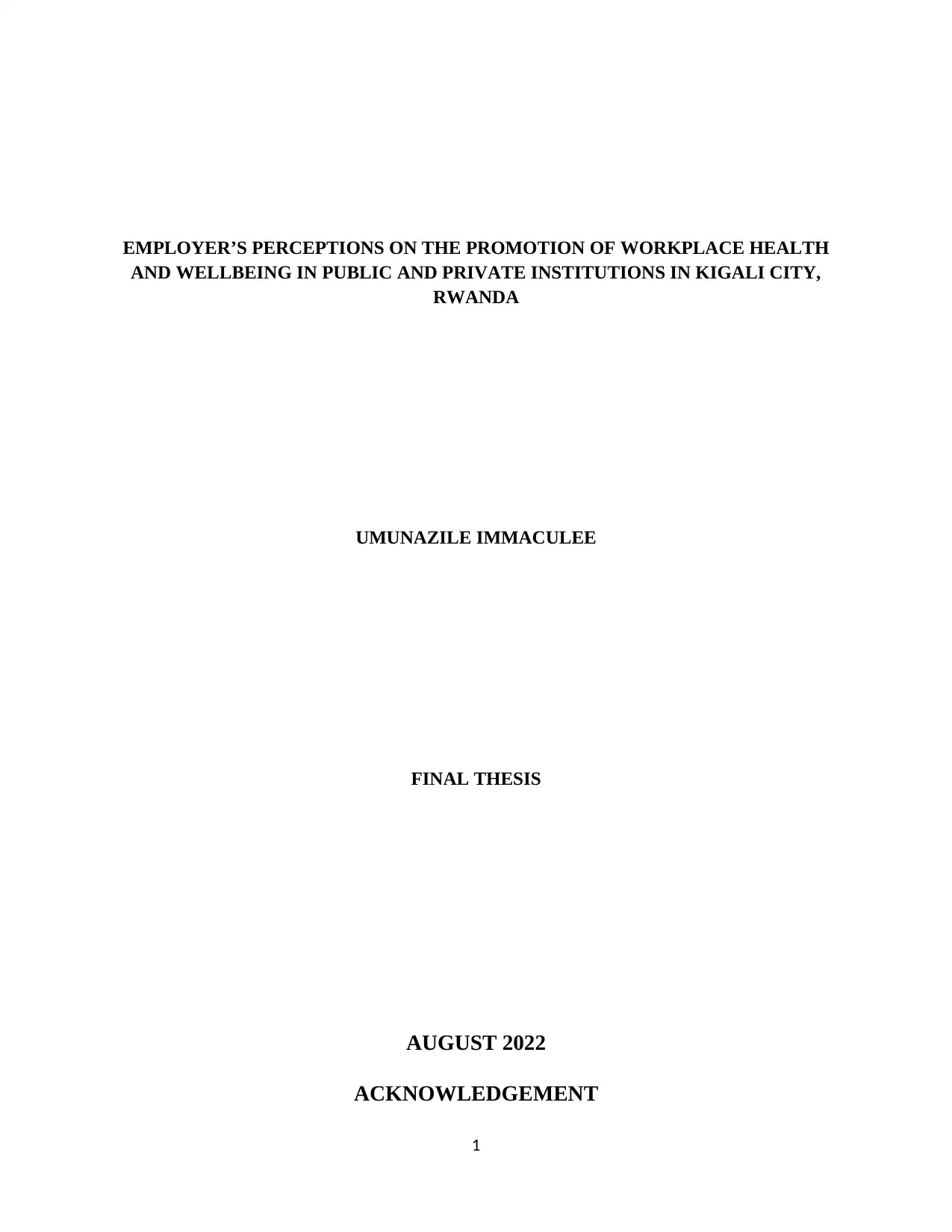
EMPLOYER’S PERCEPTIONS ON THE PROMOTION OF WORKPLACE HEALTH
AND WELLBEING IN PUBLIC AND PRIVATE INSTITUTIONS IN KIGALI CITY,
RWANDA
UMUNAZILE IMMACULEE
FINAL THESIS
AUGUST 2022
ACKNOWLEDGEMENT
1
AND WELLBEING IN PUBLIC AND PRIVATE INSTITUTIONS IN KIGALI CITY,
RWANDA
UMUNAZILE IMMACULEE
FINAL THESIS
AUGUST 2022
ACKNOWLEDGEMENT
1
Secure Best Marks with AI Grader
Need help grading? Try our AI Grader for instant feedback on your assignments.
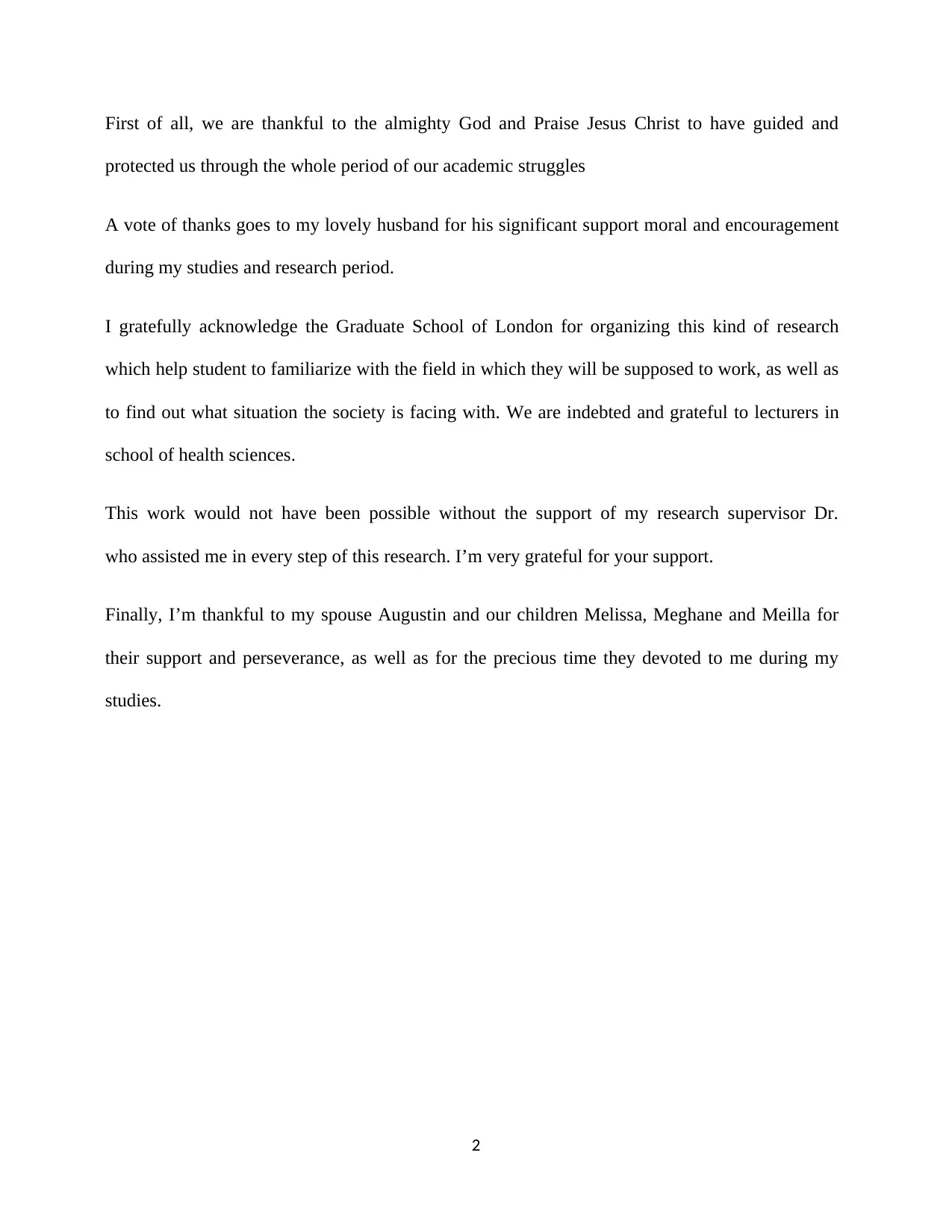
First of all, we are thankful to the almighty God and Praise Jesus Christ to have guided and
protected us through the whole period of our academic struggles
A vote of thanks goes to my lovely husband for his significant support moral and encouragement
during my studies and research period.
I gratefully acknowledge the Graduate School of London for organizing this kind of research
which help student to familiarize with the field in which they will be supposed to work, as well as
to find out what situation the society is facing with. We are indebted and grateful to lecturers in
school of health sciences.
This work would not have been possible without the support of my research supervisor Dr.
who assisted me in every step of this research. I’m very grateful for your support.
Finally, I’m thankful to my spouse Augustin and our children Melissa, Meghane and Meilla for
their support and perseverance, as well as for the precious time they devoted to me during my
studies.
2
protected us through the whole period of our academic struggles
A vote of thanks goes to my lovely husband for his significant support moral and encouragement
during my studies and research period.
I gratefully acknowledge the Graduate School of London for organizing this kind of research
which help student to familiarize with the field in which they will be supposed to work, as well as
to find out what situation the society is facing with. We are indebted and grateful to lecturers in
school of health sciences.
This work would not have been possible without the support of my research supervisor Dr.
who assisted me in every step of this research. I’m very grateful for your support.
Finally, I’m thankful to my spouse Augustin and our children Melissa, Meghane and Meilla for
their support and perseverance, as well as for the precious time they devoted to me during my
studies.
2
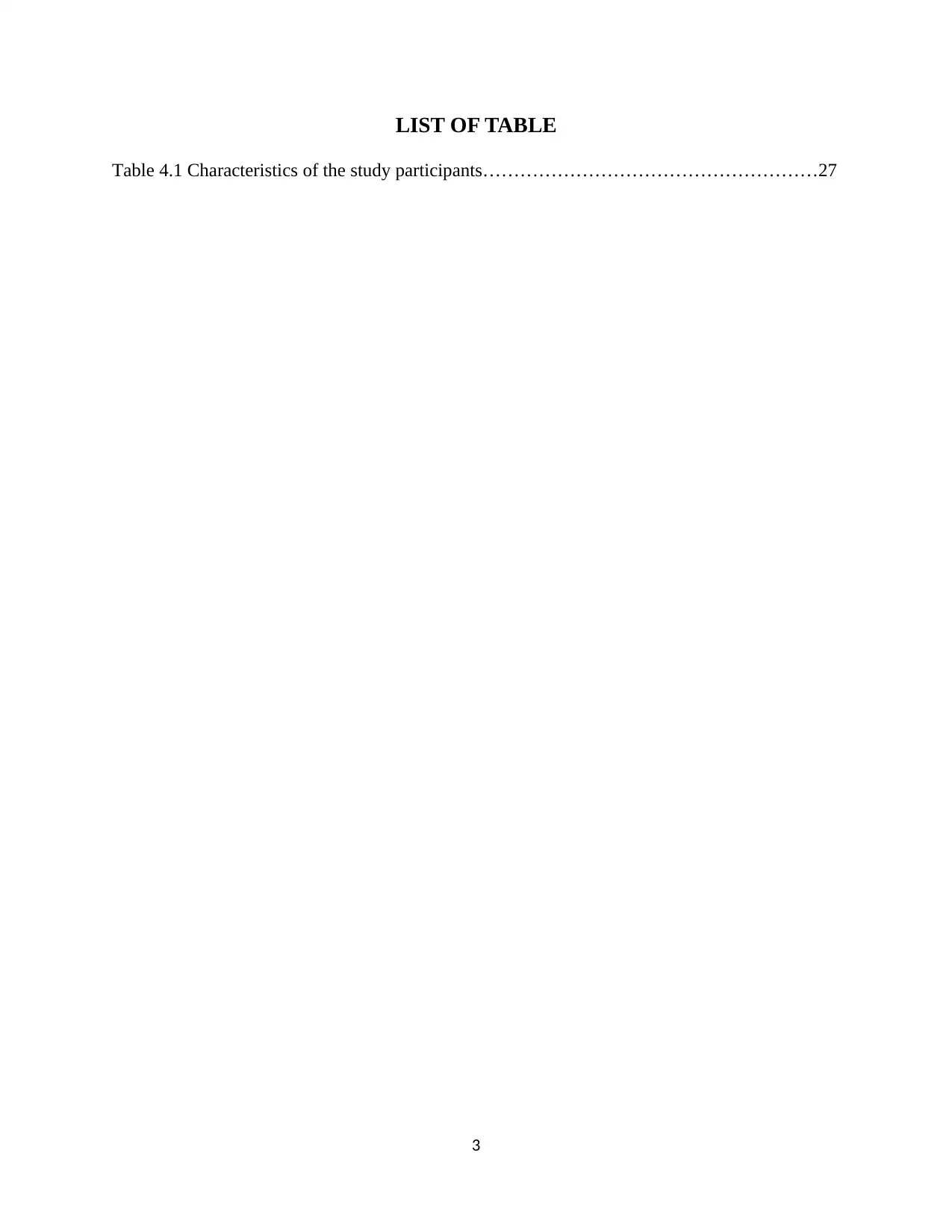
LIST OF TABLE
Table 4.1 Characteristics of the study participants………………………………………………27
3
Table 4.1 Characteristics of the study participants………………………………………………27
3
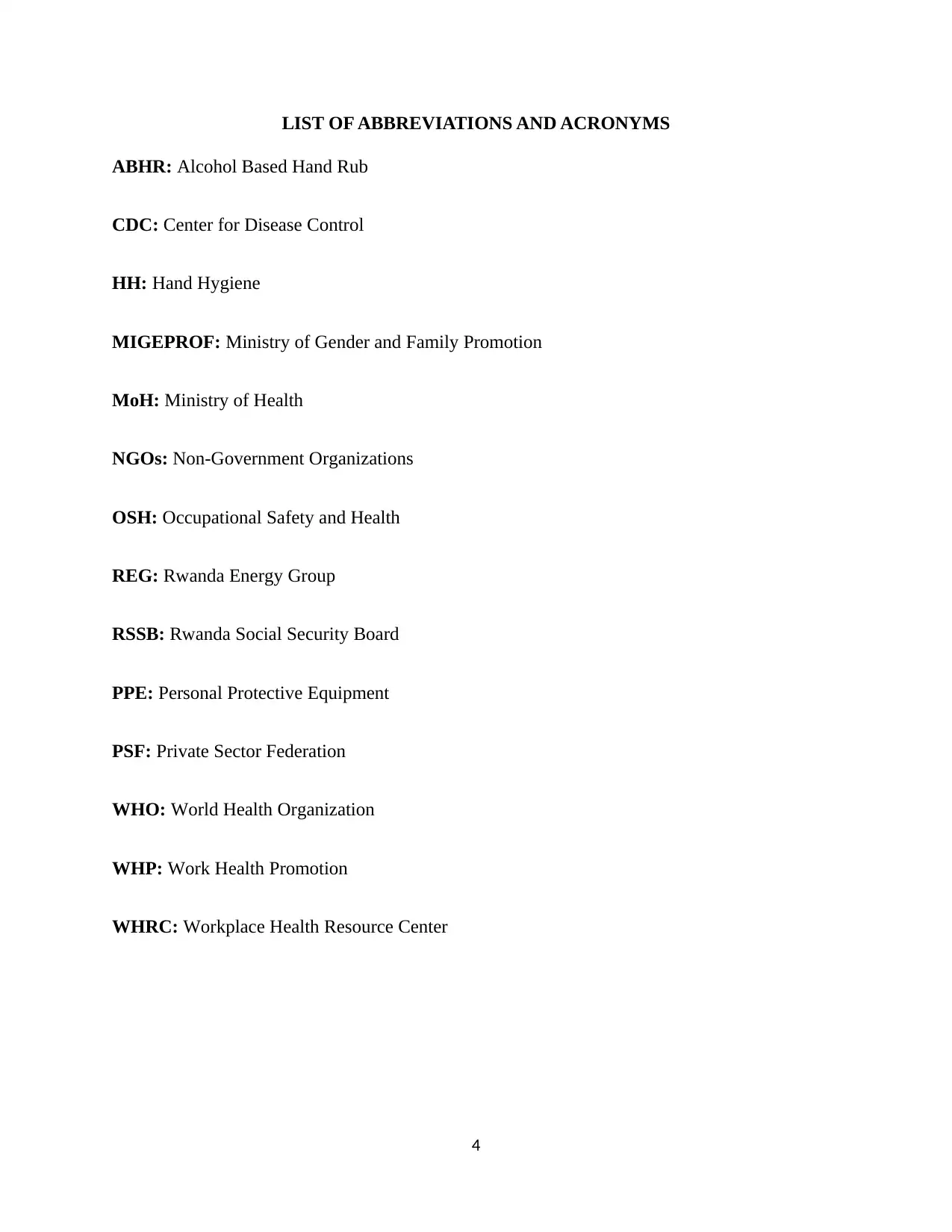
LIST OF ABBREVIATIONS AND ACRONYMS
ABHR: Alcohol Based Hand Rub
CDC: Center for Disease Control
HH: Hand Hygiene
MIGEPROF: Ministry of Gender and Family Promotion
MoH: Ministry of Health
NGOs: Non-Government Organizations
OSH: Occupational Safety and Health
REG: Rwanda Energy Group
RSSB: Rwanda Social Security Board
PPE: Personal Protective Equipment
PSF: Private Sector Federation
WHO: World Health Organization
WHP: Work Health Promotion
WHRC: Workplace Health Resource Center
4
ABHR: Alcohol Based Hand Rub
CDC: Center for Disease Control
HH: Hand Hygiene
MIGEPROF: Ministry of Gender and Family Promotion
MoH: Ministry of Health
NGOs: Non-Government Organizations
OSH: Occupational Safety and Health
REG: Rwanda Energy Group
RSSB: Rwanda Social Security Board
PPE: Personal Protective Equipment
PSF: Private Sector Federation
WHO: World Health Organization
WHP: Work Health Promotion
WHRC: Workplace Health Resource Center
4
Secure Best Marks with AI Grader
Need help grading? Try our AI Grader for instant feedback on your assignments.
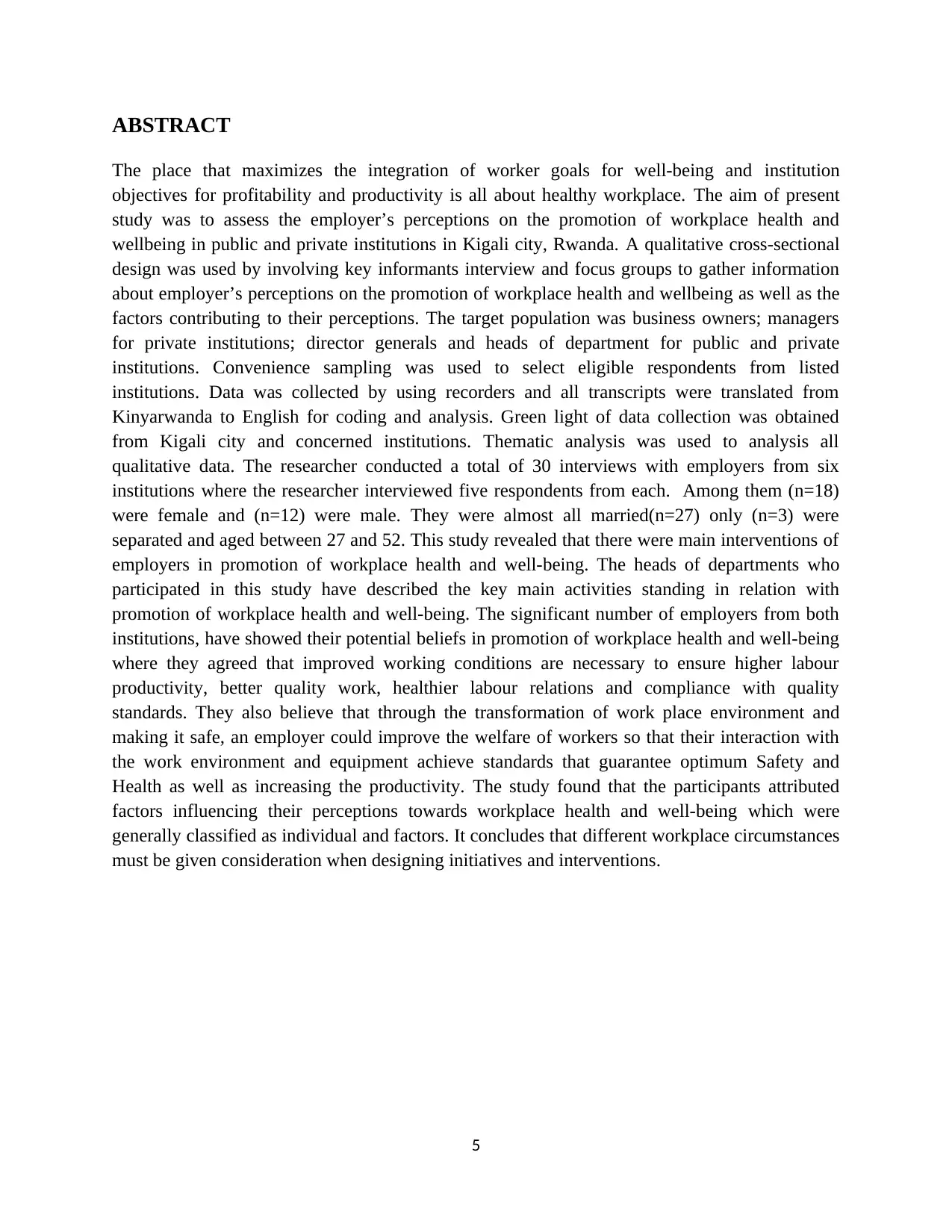
ABSTRACT
The place that maximizes the integration of worker goals for well-being and institution
objectives for profitability and productivity is all about healthy workplace. The aim of present
study was to assess the employer’s perceptions on the promotion of workplace health and
wellbeing in public and private institutions in Kigali city, Rwanda. A qualitative cross-sectional
design was used by involving key informants interview and focus groups to gather information
about employer’s perceptions on the promotion of workplace health and wellbeing as well as the
factors contributing to their perceptions. The target population was business owners; managers
for private institutions; director generals and heads of department for public and private
institutions. Convenience sampling was used to select eligible respondents from listed
institutions. Data was collected by using recorders and all transcripts were translated from
Kinyarwanda to English for coding and analysis. Green light of data collection was obtained
from Kigali city and concerned institutions. Thematic analysis was used to analysis all
qualitative data. The researcher conducted a total of 30 interviews with employers from six
institutions where the researcher interviewed five respondents from each. Among them (n=18)
were female and (n=12) were male. They were almost all married(n=27) only (n=3) were
separated and aged between 27 and 52. This study revealed that there were main interventions of
employers in promotion of workplace health and well-being. The heads of departments who
participated in this study have described the key main activities standing in relation with
promotion of workplace health and well-being. The significant number of employers from both
institutions, have showed their potential beliefs in promotion of workplace health and well-being
where they agreed that improved working conditions are necessary to ensure higher labour
productivity, better quality work, healthier labour relations and compliance with quality
standards. They also believe that through the transformation of work place environment and
making it safe, an employer could improve the welfare of workers so that their interaction with
the work environment and equipment achieve standards that guarantee optimum Safety and
Health as well as increasing the productivity. The study found that the participants attributed
factors influencing their perceptions towards workplace health and well-being which were
generally classified as individual and factors. It concludes that different workplace circumstances
must be given consideration when designing initiatives and interventions.
5
The place that maximizes the integration of worker goals for well-being and institution
objectives for profitability and productivity is all about healthy workplace. The aim of present
study was to assess the employer’s perceptions on the promotion of workplace health and
wellbeing in public and private institutions in Kigali city, Rwanda. A qualitative cross-sectional
design was used by involving key informants interview and focus groups to gather information
about employer’s perceptions on the promotion of workplace health and wellbeing as well as the
factors contributing to their perceptions. The target population was business owners; managers
for private institutions; director generals and heads of department for public and private
institutions. Convenience sampling was used to select eligible respondents from listed
institutions. Data was collected by using recorders and all transcripts were translated from
Kinyarwanda to English for coding and analysis. Green light of data collection was obtained
from Kigali city and concerned institutions. Thematic analysis was used to analysis all
qualitative data. The researcher conducted a total of 30 interviews with employers from six
institutions where the researcher interviewed five respondents from each. Among them (n=18)
were female and (n=12) were male. They were almost all married(n=27) only (n=3) were
separated and aged between 27 and 52. This study revealed that there were main interventions of
employers in promotion of workplace health and well-being. The heads of departments who
participated in this study have described the key main activities standing in relation with
promotion of workplace health and well-being. The significant number of employers from both
institutions, have showed their potential beliefs in promotion of workplace health and well-being
where they agreed that improved working conditions are necessary to ensure higher labour
productivity, better quality work, healthier labour relations and compliance with quality
standards. They also believe that through the transformation of work place environment and
making it safe, an employer could improve the welfare of workers so that their interaction with
the work environment and equipment achieve standards that guarantee optimum Safety and
Health as well as increasing the productivity. The study found that the participants attributed
factors influencing their perceptions towards workplace health and well-being which were
generally classified as individual and factors. It concludes that different workplace circumstances
must be given consideration when designing initiatives and interventions.
5
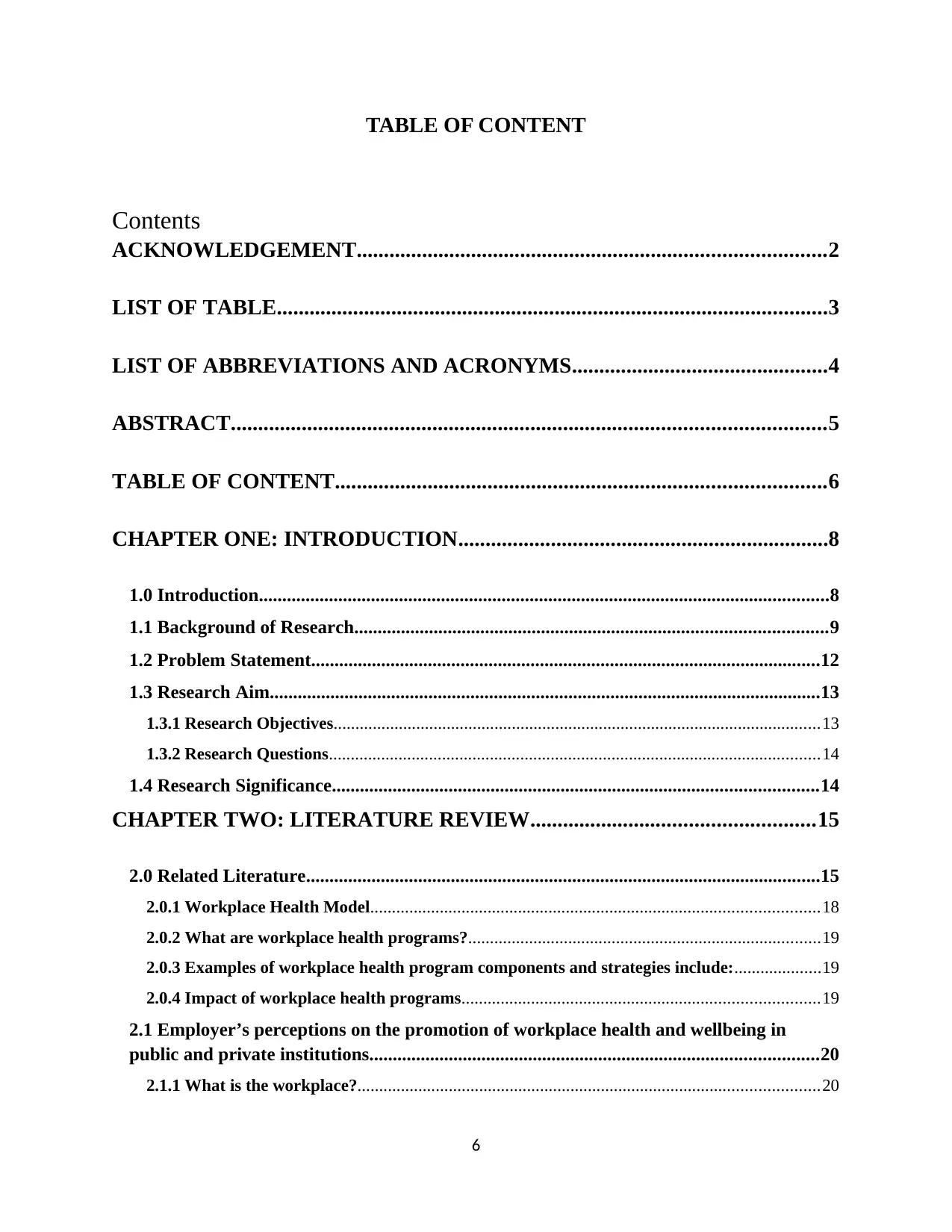
TABLE OF CONTENT
Contents
ACKNOWLEDGEMENT......................................................................................2
LIST OF TABLE.....................................................................................................3
LIST OF ABBREVIATIONS AND ACRONYMS...............................................4
ABSTRACT.............................................................................................................5
TABLE OF CONTENT..........................................................................................6
CHAPTER ONE: INTRODUCTION....................................................................8
1.0 Introduction..........................................................................................................................8
1.1 Background of Research.....................................................................................................9
1.2 Problem Statement.............................................................................................................12
1.3 Research Aim......................................................................................................................13
1.3.1 Research Objectives................................................................................................................13
1.3.2 Research Questions.................................................................................................................14
1.4 Research Significance........................................................................................................14
CHAPTER TWO: LITERATURE REVIEW....................................................15
2.0 Related Literature..............................................................................................................15
2.0.1 Workplace Health Model.......................................................................................................18
2.0.2 What are workplace health programs?.................................................................................19
2.0.3 Examples of workplace health program components and strategies include:....................19
2.0.4 Impact of workplace health programs..................................................................................19
2.1 Employer’s perceptions on the promotion of workplace health and wellbeing in
public and private institutions................................................................................................20
2.1.1 What is the workplace?..........................................................................................................20
6
Contents
ACKNOWLEDGEMENT......................................................................................2
LIST OF TABLE.....................................................................................................3
LIST OF ABBREVIATIONS AND ACRONYMS...............................................4
ABSTRACT.............................................................................................................5
TABLE OF CONTENT..........................................................................................6
CHAPTER ONE: INTRODUCTION....................................................................8
1.0 Introduction..........................................................................................................................8
1.1 Background of Research.....................................................................................................9
1.2 Problem Statement.............................................................................................................12
1.3 Research Aim......................................................................................................................13
1.3.1 Research Objectives................................................................................................................13
1.3.2 Research Questions.................................................................................................................14
1.4 Research Significance........................................................................................................14
CHAPTER TWO: LITERATURE REVIEW....................................................15
2.0 Related Literature..............................................................................................................15
2.0.1 Workplace Health Model.......................................................................................................18
2.0.2 What are workplace health programs?.................................................................................19
2.0.3 Examples of workplace health program components and strategies include:....................19
2.0.4 Impact of workplace health programs..................................................................................19
2.1 Employer’s perceptions on the promotion of workplace health and wellbeing in
public and private institutions................................................................................................20
2.1.1 What is the workplace?..........................................................................................................20
6
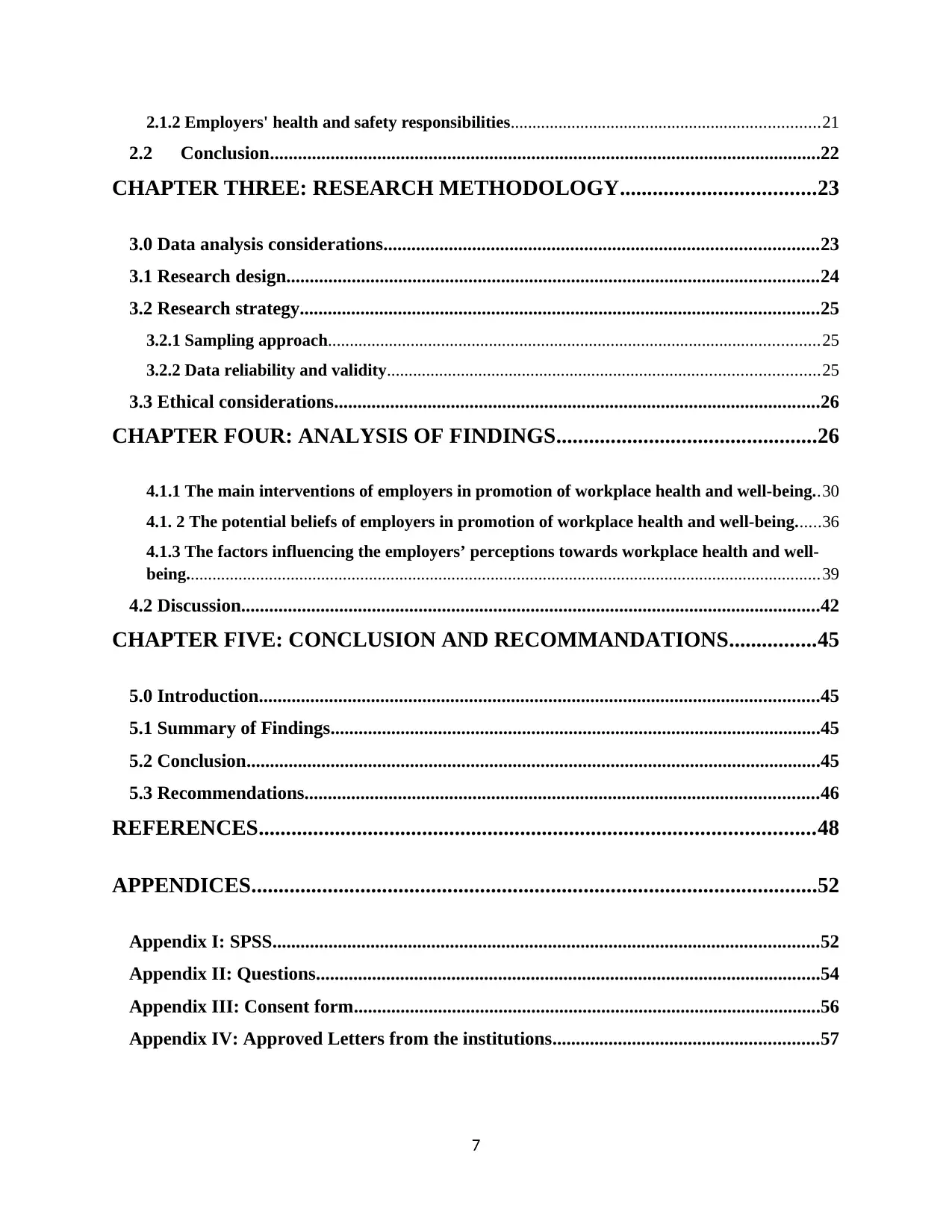
2.1.2 Employers' health and safety responsibilities.......................................................................21
2.2 Conclusion......................................................................................................................22
CHAPTER THREE: RESEARCH METHODOLOGY....................................23
3.0 Data analysis considerations.............................................................................................23
3.1 Research design..................................................................................................................24
3.2 Research strategy...............................................................................................................25
3.2.1 Sampling approach.................................................................................................................25
3.2.2 Data reliability and validity...................................................................................................25
3.3 Ethical considerations........................................................................................................26
CHAPTER FOUR: ANALYSIS OF FINDINGS................................................26
4.1.1 The main interventions of employers in promotion of workplace health and well-being..30
4.1. 2 The potential beliefs of employers in promotion of workplace health and well-being......36
4.1.3 The factors influencing the employers’ perceptions towards workplace health and well-
being..................................................................................................................................................39
4.2 Discussion............................................................................................................................42
CHAPTER FIVE: CONCLUSION AND RECOMMANDATIONS................45
5.0 Introduction........................................................................................................................45
5.1 Summary of Findings.........................................................................................................45
5.2 Conclusion...........................................................................................................................45
5.3 Recommendations..............................................................................................................46
REFERENCES......................................................................................................48
APPENDICES........................................................................................................52
Appendix I: SPSS.....................................................................................................................52
Appendix II: Questions............................................................................................................54
Appendix III: Consent form....................................................................................................56
Appendix IV: Approved Letters from the institutions.........................................................57
7
2.2 Conclusion......................................................................................................................22
CHAPTER THREE: RESEARCH METHODOLOGY....................................23
3.0 Data analysis considerations.............................................................................................23
3.1 Research design..................................................................................................................24
3.2 Research strategy...............................................................................................................25
3.2.1 Sampling approach.................................................................................................................25
3.2.2 Data reliability and validity...................................................................................................25
3.3 Ethical considerations........................................................................................................26
CHAPTER FOUR: ANALYSIS OF FINDINGS................................................26
4.1.1 The main interventions of employers in promotion of workplace health and well-being..30
4.1. 2 The potential beliefs of employers in promotion of workplace health and well-being......36
4.1.3 The factors influencing the employers’ perceptions towards workplace health and well-
being..................................................................................................................................................39
4.2 Discussion............................................................................................................................42
CHAPTER FIVE: CONCLUSION AND RECOMMANDATIONS................45
5.0 Introduction........................................................................................................................45
5.1 Summary of Findings.........................................................................................................45
5.2 Conclusion...........................................................................................................................45
5.3 Recommendations..............................................................................................................46
REFERENCES......................................................................................................48
APPENDICES........................................................................................................52
Appendix I: SPSS.....................................................................................................................52
Appendix II: Questions............................................................................................................54
Appendix III: Consent form....................................................................................................56
Appendix IV: Approved Letters from the institutions.........................................................57
7
Paraphrase This Document
Need a fresh take? Get an instant paraphrase of this document with our AI Paraphraser
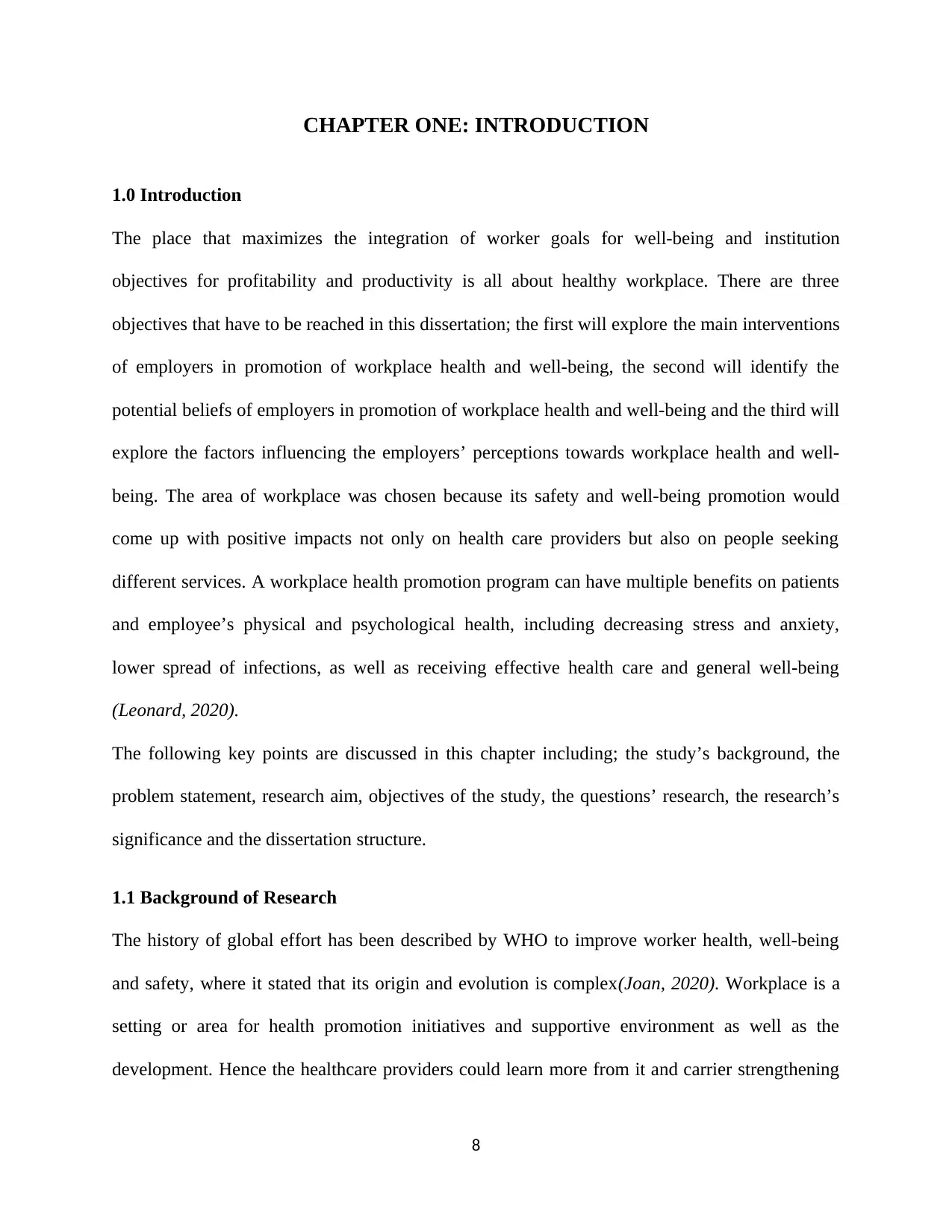
CHAPTER ONE: INTRODUCTION
1.0 Introduction
The place that maximizes the integration of worker goals for well-being and institution
objectives for profitability and productivity is all about healthy workplace. There are three
objectives that have to be reached in this dissertation; the first will explore the main interventions
of employers in promotion of workplace health and well-being, the second will identify the
potential beliefs of employers in promotion of workplace health and well-being and the third will
explore the factors influencing the employers’ perceptions towards workplace health and well-
being. The area of workplace was chosen because its safety and well-being promotion would
come up with positive impacts not only on health care providers but also on people seeking
different services. A workplace health promotion program can have multiple benefits on patients
and employee’s physical and psychological health, including decreasing stress and anxiety,
lower spread of infections, as well as receiving effective health care and general well-being
(Leonard, 2020).
The following key points are discussed in this chapter including; the study’s background, the
problem statement, research aim, objectives of the study, the questions’ research, the research’s
significance and the dissertation structure.
1.1 Background of Research
The history of global effort has been described by WHO to improve worker health, well-being
and safety, where it stated that its origin and evolution is complex(Joan, 2020). Workplace is a
setting or area for health promotion initiatives and supportive environment as well as the
development. Hence the healthcare providers could learn more from it and carrier strengthening
8
1.0 Introduction
The place that maximizes the integration of worker goals for well-being and institution
objectives for profitability and productivity is all about healthy workplace. There are three
objectives that have to be reached in this dissertation; the first will explore the main interventions
of employers in promotion of workplace health and well-being, the second will identify the
potential beliefs of employers in promotion of workplace health and well-being and the third will
explore the factors influencing the employers’ perceptions towards workplace health and well-
being. The area of workplace was chosen because its safety and well-being promotion would
come up with positive impacts not only on health care providers but also on people seeking
different services. A workplace health promotion program can have multiple benefits on patients
and employee’s physical and psychological health, including decreasing stress and anxiety,
lower spread of infections, as well as receiving effective health care and general well-being
(Leonard, 2020).
The following key points are discussed in this chapter including; the study’s background, the
problem statement, research aim, objectives of the study, the questions’ research, the research’s
significance and the dissertation structure.
1.1 Background of Research
The history of global effort has been described by WHO to improve worker health, well-being
and safety, where it stated that its origin and evolution is complex(Joan, 2020). Workplace is a
setting or area for health promotion initiatives and supportive environment as well as the
development. Hence the healthcare providers could learn more from it and carrier strengthening
8
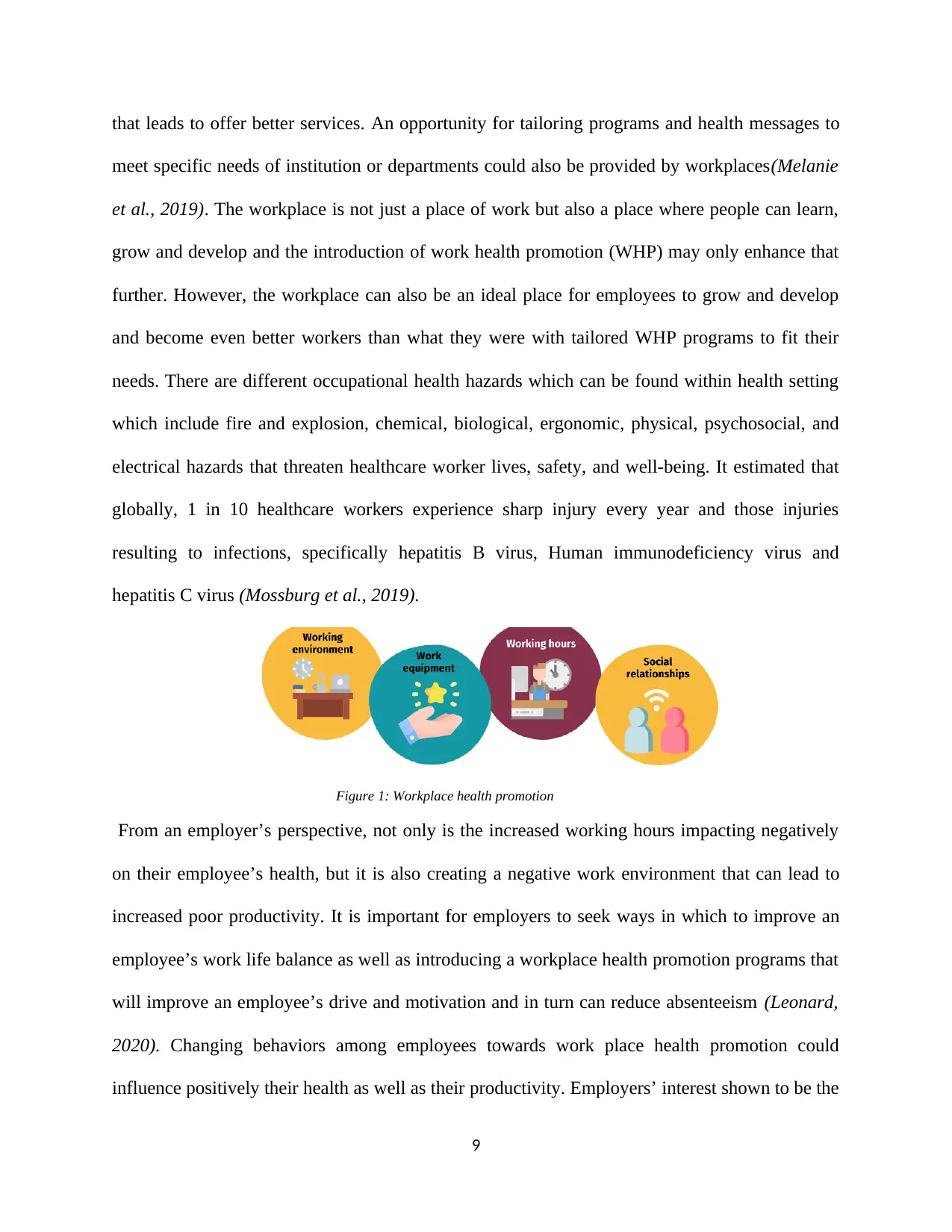
that leads to offer better services. An opportunity for tailoring programs and health messages to
meet specific needs of institution or departments could also be provided by workplaces(Melanie
et al., 2019). The workplace is not just a place of work but also a place where people can learn,
grow and develop and the introduction of work health promotion (WHP) may only enhance that
further. However, the workplace can also be an ideal place for employees to grow and develop
and become even better workers than what they were with tailored WHP programs to fit their
needs. There are different occupational health hazards which can be found within health setting
which include fire and explosion, chemical, biological, ergonomic, physical, psychosocial, and
electrical hazards that threaten healthcare worker lives, safety, and well-being. It estimated that
globally, 1 in 10 healthcare workers experience sharp injury every year and those injuries
resulting to infections, specifically hepatitis B virus, Human immunodeficiency virus and
hepatitis C virus (Mossburg et al., 2019).
Figure 1: Workplace health promotion
From an employer’s perspective, not only is the increased working hours impacting negatively
on their employee’s health, but it is also creating a negative work environment that can lead to
increased poor productivity. It is important for employers to seek ways in which to improve an
employee’s work life balance as well as introducing a workplace health promotion programs that
will improve an employee’s drive and motivation and in turn can reduce absenteeism (Leonard,
2020). Changing behaviors among employees towards work place health promotion could
influence positively their health as well as their productivity. Employers’ interest shown to be the
9
meet specific needs of institution or departments could also be provided by workplaces(Melanie
et al., 2019). The workplace is not just a place of work but also a place where people can learn,
grow and develop and the introduction of work health promotion (WHP) may only enhance that
further. However, the workplace can also be an ideal place for employees to grow and develop
and become even better workers than what they were with tailored WHP programs to fit their
needs. There are different occupational health hazards which can be found within health setting
which include fire and explosion, chemical, biological, ergonomic, physical, psychosocial, and
electrical hazards that threaten healthcare worker lives, safety, and well-being. It estimated that
globally, 1 in 10 healthcare workers experience sharp injury every year and those injuries
resulting to infections, specifically hepatitis B virus, Human immunodeficiency virus and
hepatitis C virus (Mossburg et al., 2019).
Figure 1: Workplace health promotion
From an employer’s perspective, not only is the increased working hours impacting negatively
on their employee’s health, but it is also creating a negative work environment that can lead to
increased poor productivity. It is important for employers to seek ways in which to improve an
employee’s work life balance as well as introducing a workplace health promotion programs that
will improve an employee’s drive and motivation and in turn can reduce absenteeism (Leonard,
2020). Changing behaviors among employees towards work place health promotion could
influence positively their health as well as their productivity. Employers’ interest shown to be the
9
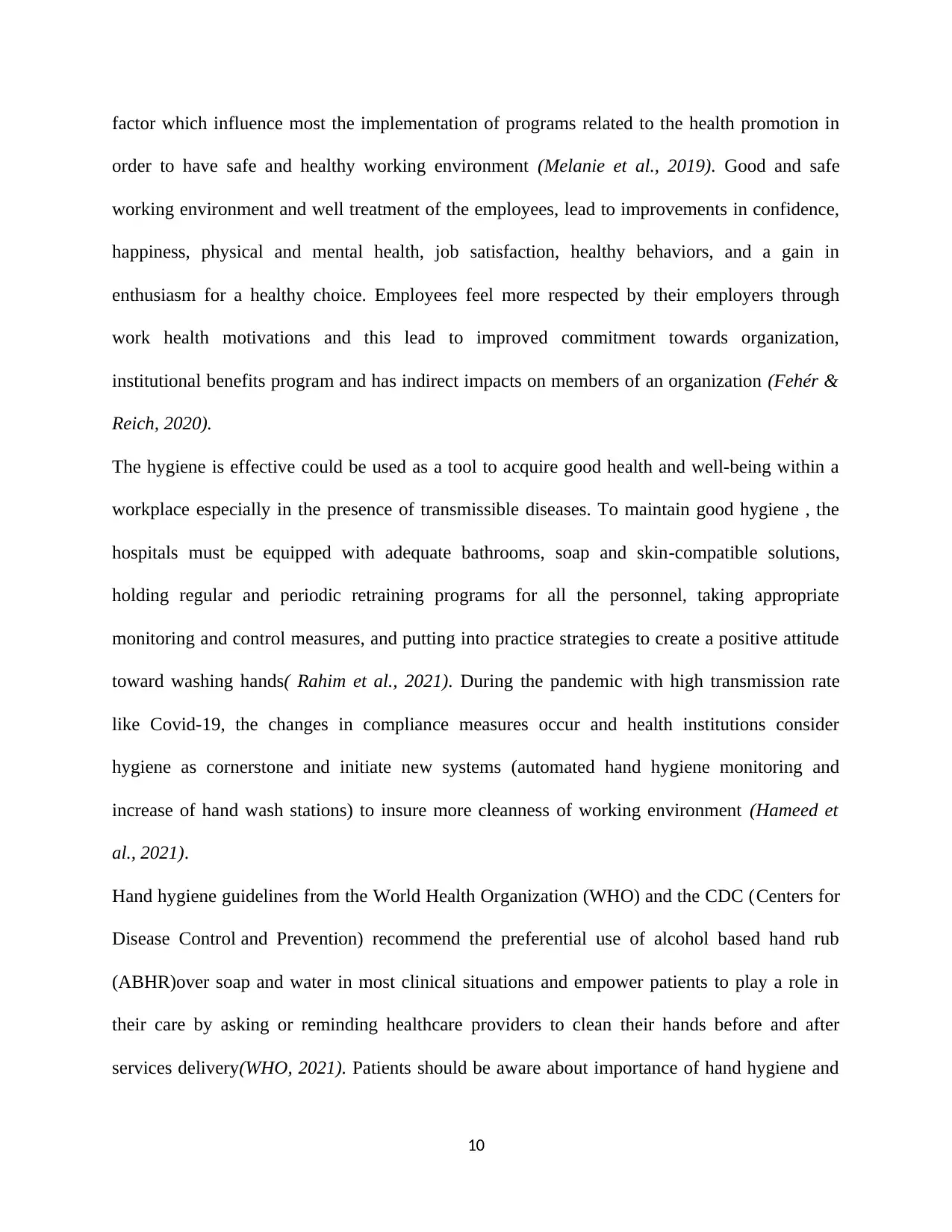
factor which influence most the implementation of programs related to the health promotion in
order to have safe and healthy working environment (Melanie et al., 2019). Good and safe
working environment and well treatment of the employees, lead to improvements in confidence,
happiness, physical and mental health, job satisfaction, healthy behaviors, and a gain in
enthusiasm for a healthy choice. Employees feel more respected by their employers through
work health motivations and this lead to improved commitment towards organization,
institutional benefits program and has indirect impacts on members of an organization (Fehér &
Reich, 2020).
The hygiene is effective could be used as a tool to acquire good health and well-being within a
workplace especially in the presence of transmissible diseases. To maintain good hygiene , the
hospitals must be equipped with adequate bathrooms, soap and skin-compatible solutions,
holding regular and periodic retraining programs for all the personnel, taking appropriate
monitoring and control measures, and putting into practice strategies to create a positive attitude
toward washing hands( Rahim et al., 2021). During the pandemic with high transmission rate
like Covid-19, the changes in compliance measures occur and health institutions consider
hygiene as cornerstone and initiate new systems (automated hand hygiene monitoring and
increase of hand wash stations) to insure more cleanness of working environment (Hameed et
al., 2021).
Hand hygiene guidelines from the World Health Organization (WHO) and the CDC (Centers for
Disease Control and Prevention) recommend the preferential use of alcohol based hand rub
(ABHR)over soap and water in most clinical situations and empower patients to play a role in
their care by asking or reminding healthcare providers to clean their hands before and after
services delivery(WHO, 2021). Patients should be aware about importance of hand hygiene and
10
order to have safe and healthy working environment (Melanie et al., 2019). Good and safe
working environment and well treatment of the employees, lead to improvements in confidence,
happiness, physical and mental health, job satisfaction, healthy behaviors, and a gain in
enthusiasm for a healthy choice. Employees feel more respected by their employers through
work health motivations and this lead to improved commitment towards organization,
institutional benefits program and has indirect impacts on members of an organization (Fehér &
Reich, 2020).
The hygiene is effective could be used as a tool to acquire good health and well-being within a
workplace especially in the presence of transmissible diseases. To maintain good hygiene , the
hospitals must be equipped with adequate bathrooms, soap and skin-compatible solutions,
holding regular and periodic retraining programs for all the personnel, taking appropriate
monitoring and control measures, and putting into practice strategies to create a positive attitude
toward washing hands( Rahim et al., 2021). During the pandemic with high transmission rate
like Covid-19, the changes in compliance measures occur and health institutions consider
hygiene as cornerstone and initiate new systems (automated hand hygiene monitoring and
increase of hand wash stations) to insure more cleanness of working environment (Hameed et
al., 2021).
Hand hygiene guidelines from the World Health Organization (WHO) and the CDC (Centers for
Disease Control and Prevention) recommend the preferential use of alcohol based hand rub
(ABHR)over soap and water in most clinical situations and empower patients to play a role in
their care by asking or reminding healthcare providers to clean their hands before and after
services delivery(WHO, 2021). Patients should be aware about importance of hand hygiene and
10
Secure Best Marks with AI Grader
Need help grading? Try our AI Grader for instant feedback on your assignments.

they have to be educated where it is needed but they hesitate to ask healthcare providers about
hygiene during physical examinations because they have worries of receiving back poor services
from their health cares(Ahmed & Al-surimi, 2021).
To improve outcomes of hand hygiene and safety within health setting, engaging patients in
healthcare, providing daily education sessions and increasing patient awareness of hand hygiene
practices could play. The hand hygiene observation form should be used regularly, as part of this
strategy, to assess the hand hygiene compliance and provide safe work place. Although this
improvement has shown some initial promising results, continuous monitoring is required to
ensure that compliance continues to improve and is sustained(Ahmed & Al-surimi, 2021). In
Saudi Arabia, hand hygiene compliance was low where overall estimate of the last quarter in
2014 was 30% as revealed by retrospective research and the decision has been made to test
change ideas to improve hand hygiene compliance as a method for reducing healthcare
associated infections as well as to ensure safe working environment(Ahmed & Al-surimi, 2021).
The key role of nurses working as a medical and healthcare unit is ensuring the well-being of
individuals and society and it is essential to devise strategies to change public behavior through
understanding how people care about hand hygiene and what factors contribute to such
behavior(Hazni et al., 2021). Working experience, age and behavior of an individual could
increase intention toward positive hand hygiene, healthcare providers with more working
experience tend to develop good behavior towards hand hygiene. The study revealed that females
are more committed to hand hygiene practices and safe environment working in comparison with
males(Rahimi et al., 2019).
11
hygiene during physical examinations because they have worries of receiving back poor services
from their health cares(Ahmed & Al-surimi, 2021).
To improve outcomes of hand hygiene and safety within health setting, engaging patients in
healthcare, providing daily education sessions and increasing patient awareness of hand hygiene
practices could play. The hand hygiene observation form should be used regularly, as part of this
strategy, to assess the hand hygiene compliance and provide safe work place. Although this
improvement has shown some initial promising results, continuous monitoring is required to
ensure that compliance continues to improve and is sustained(Ahmed & Al-surimi, 2021). In
Saudi Arabia, hand hygiene compliance was low where overall estimate of the last quarter in
2014 was 30% as revealed by retrospective research and the decision has been made to test
change ideas to improve hand hygiene compliance as a method for reducing healthcare
associated infections as well as to ensure safe working environment(Ahmed & Al-surimi, 2021).
The key role of nurses working as a medical and healthcare unit is ensuring the well-being of
individuals and society and it is essential to devise strategies to change public behavior through
understanding how people care about hand hygiene and what factors contribute to such
behavior(Hazni et al., 2021). Working experience, age and behavior of an individual could
increase intention toward positive hand hygiene, healthcare providers with more working
experience tend to develop good behavior towards hand hygiene. The study revealed that females
are more committed to hand hygiene practices and safe environment working in comparison with
males(Rahimi et al., 2019).
11
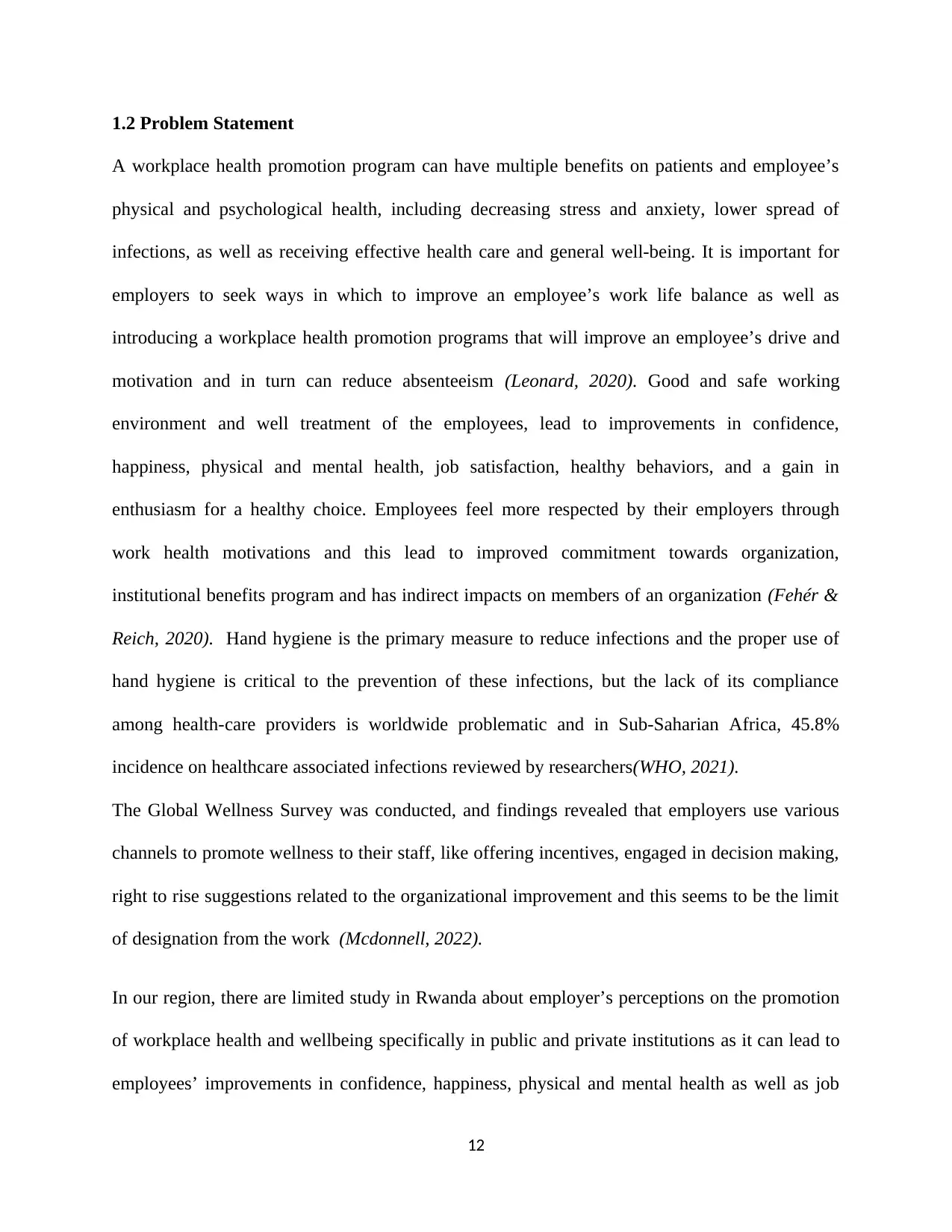
1.2 Problem Statement
A workplace health promotion program can have multiple benefits on patients and employee’s
physical and psychological health, including decreasing stress and anxiety, lower spread of
infections, as well as receiving effective health care and general well-being. It is important for
employers to seek ways in which to improve an employee’s work life balance as well as
introducing a workplace health promotion programs that will improve an employee’s drive and
motivation and in turn can reduce absenteeism (Leonard, 2020). Good and safe working
environment and well treatment of the employees, lead to improvements in confidence,
happiness, physical and mental health, job satisfaction, healthy behaviors, and a gain in
enthusiasm for a healthy choice. Employees feel more respected by their employers through
work health motivations and this lead to improved commitment towards organization,
institutional benefits program and has indirect impacts on members of an organization (Fehér &
Reich, 2020). Hand hygiene is the primary measure to reduce infections and the proper use of
hand hygiene is critical to the prevention of these infections, but the lack of its compliance
among health-care providers is worldwide problematic and in Sub-Saharian Africa, 45.8%
incidence on healthcare associated infections reviewed by researchers(WHO, 2021).
The Global Wellness Survey was conducted, and findings revealed that employers use various
channels to promote wellness to their staff, like offering incentives, engaged in decision making,
right to rise suggestions related to the organizational improvement and this seems to be the limit
of designation from the work (Mcdonnell, 2022).
In our region, there are limited study in Rwanda about employer’s perceptions on the promotion
of workplace health and wellbeing specifically in public and private institutions as it can lead to
employees’ improvements in confidence, happiness, physical and mental health as well as job
12
A workplace health promotion program can have multiple benefits on patients and employee’s
physical and psychological health, including decreasing stress and anxiety, lower spread of
infections, as well as receiving effective health care and general well-being. It is important for
employers to seek ways in which to improve an employee’s work life balance as well as
introducing a workplace health promotion programs that will improve an employee’s drive and
motivation and in turn can reduce absenteeism (Leonard, 2020). Good and safe working
environment and well treatment of the employees, lead to improvements in confidence,
happiness, physical and mental health, job satisfaction, healthy behaviors, and a gain in
enthusiasm for a healthy choice. Employees feel more respected by their employers through
work health motivations and this lead to improved commitment towards organization,
institutional benefits program and has indirect impacts on members of an organization (Fehér &
Reich, 2020). Hand hygiene is the primary measure to reduce infections and the proper use of
hand hygiene is critical to the prevention of these infections, but the lack of its compliance
among health-care providers is worldwide problematic and in Sub-Saharian Africa, 45.8%
incidence on healthcare associated infections reviewed by researchers(WHO, 2021).
The Global Wellness Survey was conducted, and findings revealed that employers use various
channels to promote wellness to their staff, like offering incentives, engaged in decision making,
right to rise suggestions related to the organizational improvement and this seems to be the limit
of designation from the work (Mcdonnell, 2022).
In our region, there are limited study in Rwanda about employer’s perceptions on the promotion
of workplace health and wellbeing specifically in public and private institutions as it can lead to
employees’ improvements in confidence, happiness, physical and mental health as well as job
12
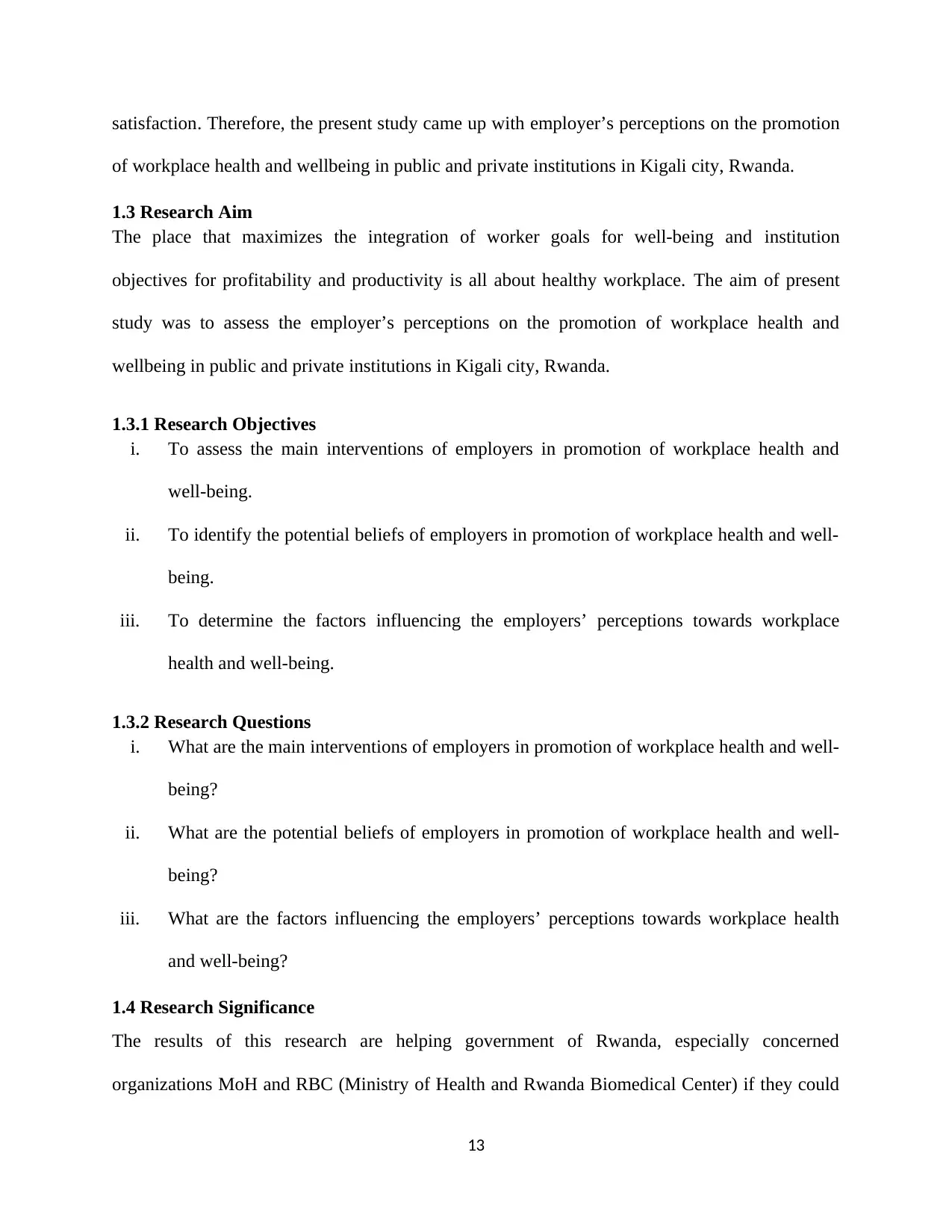
satisfaction. Therefore, the present study came up with employer’s perceptions on the promotion
of workplace health and wellbeing in public and private institutions in Kigali city, Rwanda.
1.3 Research Aim
The place that maximizes the integration of worker goals for well-being and institution
objectives for profitability and productivity is all about healthy workplace. The aim of present
study was to assess the employer’s perceptions on the promotion of workplace health and
wellbeing in public and private institutions in Kigali city, Rwanda.
1.3.1 Research Objectives
i. To assess the main interventions of employers in promotion of workplace health and
well-being.
ii. To identify the potential beliefs of employers in promotion of workplace health and well-
being.
iii. To determine the factors influencing the employers’ perceptions towards workplace
health and well-being.
1.3.2 Research Questions
i. What are the main interventions of employers in promotion of workplace health and well-
being?
ii. What are the potential beliefs of employers in promotion of workplace health and well-
being?
iii. What are the factors influencing the employers’ perceptions towards workplace health
and well-being?
1.4 Research Significance
The results of this research are helping government of Rwanda, especially concerned
organizations MoH and RBC (Ministry of Health and Rwanda Biomedical Center) if they could
13
of workplace health and wellbeing in public and private institutions in Kigali city, Rwanda.
1.3 Research Aim
The place that maximizes the integration of worker goals for well-being and institution
objectives for profitability and productivity is all about healthy workplace. The aim of present
study was to assess the employer’s perceptions on the promotion of workplace health and
wellbeing in public and private institutions in Kigali city, Rwanda.
1.3.1 Research Objectives
i. To assess the main interventions of employers in promotion of workplace health and
well-being.
ii. To identify the potential beliefs of employers in promotion of workplace health and well-
being.
iii. To determine the factors influencing the employers’ perceptions towards workplace
health and well-being.
1.3.2 Research Questions
i. What are the main interventions of employers in promotion of workplace health and well-
being?
ii. What are the potential beliefs of employers in promotion of workplace health and well-
being?
iii. What are the factors influencing the employers’ perceptions towards workplace health
and well-being?
1.4 Research Significance
The results of this research are helping government of Rwanda, especially concerned
organizations MoH and RBC (Ministry of Health and Rwanda Biomedical Center) if they could
13
Paraphrase This Document
Need a fresh take? Get an instant paraphrase of this document with our AI Paraphraser
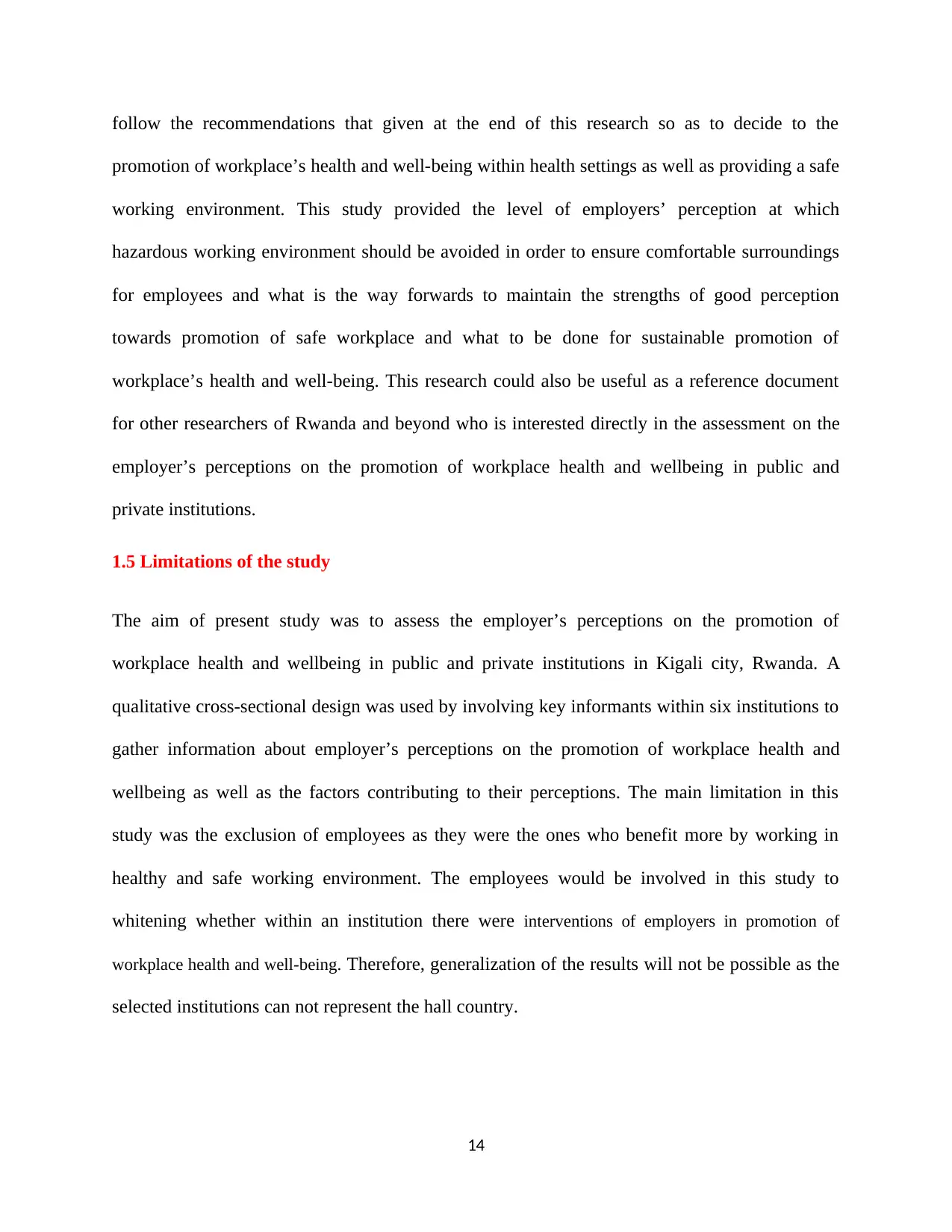
follow the recommendations that given at the end of this research so as to decide to the
promotion of workplace’s health and well-being within health settings as well as providing a safe
working environment. This study provided the level of employers’ perception at which
hazardous working environment should be avoided in order to ensure comfortable surroundings
for employees and what is the way forwards to maintain the strengths of good perception
towards promotion of safe workplace and what to be done for sustainable promotion of
workplace’s health and well-being. This research could also be useful as a reference document
for other researchers of Rwanda and beyond who is interested directly in the assessment on the
employer’s perceptions on the promotion of workplace health and wellbeing in public and
private institutions.
1.5 Limitations of the study
The aim of present study was to assess the employer’s perceptions on the promotion of
workplace health and wellbeing in public and private institutions in Kigali city, Rwanda. A
qualitative cross-sectional design was used by involving key informants within six institutions to
gather information about employer’s perceptions on the promotion of workplace health and
wellbeing as well as the factors contributing to their perceptions. The main limitation in this
study was the exclusion of employees as they were the ones who benefit more by working in
healthy and safe working environment. The employees would be involved in this study to
whitening whether within an institution there were interventions of employers in promotion of
workplace health and well-being. Therefore, generalization of the results will not be possible as the
selected institutions can not represent the hall country.
14
promotion of workplace’s health and well-being within health settings as well as providing a safe
working environment. This study provided the level of employers’ perception at which
hazardous working environment should be avoided in order to ensure comfortable surroundings
for employees and what is the way forwards to maintain the strengths of good perception
towards promotion of safe workplace and what to be done for sustainable promotion of
workplace’s health and well-being. This research could also be useful as a reference document
for other researchers of Rwanda and beyond who is interested directly in the assessment on the
employer’s perceptions on the promotion of workplace health and wellbeing in public and
private institutions.
1.5 Limitations of the study
The aim of present study was to assess the employer’s perceptions on the promotion of
workplace health and wellbeing in public and private institutions in Kigali city, Rwanda. A
qualitative cross-sectional design was used by involving key informants within six institutions to
gather information about employer’s perceptions on the promotion of workplace health and
wellbeing as well as the factors contributing to their perceptions. The main limitation in this
study was the exclusion of employees as they were the ones who benefit more by working in
healthy and safe working environment. The employees would be involved in this study to
whitening whether within an institution there were interventions of employers in promotion of
workplace health and well-being. Therefore, generalization of the results will not be possible as the
selected institutions can not represent the hall country.
14
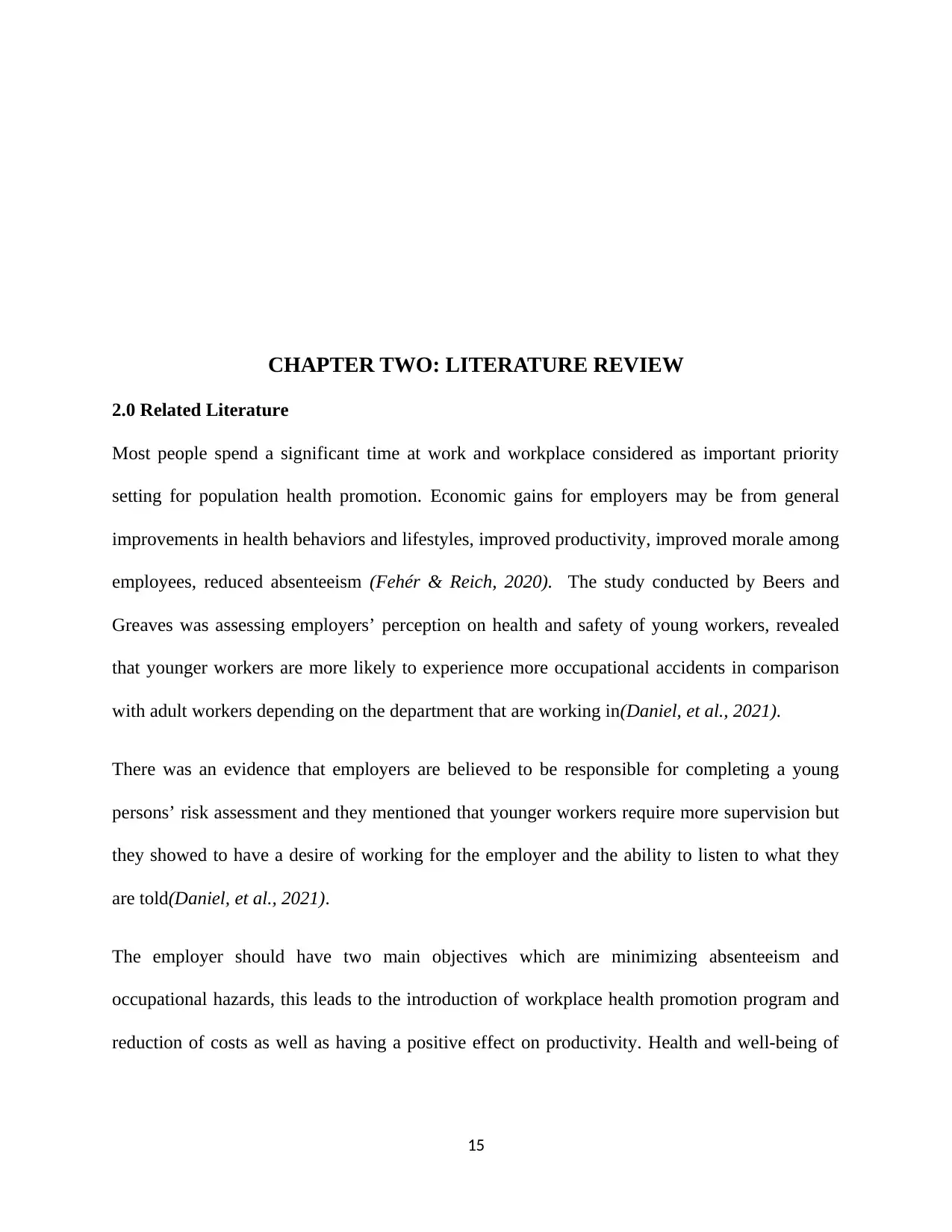
CHAPTER TWO: LITERATURE REVIEW
2.0 Related Literature
Most people spend a significant time at work and workplace considered as important priority
setting for population health promotion. Economic gains for employers may be from general
improvements in health behaviors and lifestyles, improved productivity, improved morale among
employees, reduced absenteeism (Fehér & Reich, 2020). The study conducted by Beers and
Greaves was assessing employers’ perception on health and safety of young workers, revealed
that younger workers are more likely to experience more occupational accidents in comparison
with adult workers depending on the department that are working in(Daniel, et al., 2021).
There was an evidence that employers are believed to be responsible for completing a young
persons’ risk assessment and they mentioned that younger workers require more supervision but
they showed to have a desire of working for the employer and the ability to listen to what they
are told(Daniel, et al., 2021).
The employer should have two main objectives which are minimizing absenteeism and
occupational hazards, this leads to the introduction of workplace health promotion program and
reduction of costs as well as having a positive effect on productivity. Health and well-being of
15
2.0 Related Literature
Most people spend a significant time at work and workplace considered as important priority
setting for population health promotion. Economic gains for employers may be from general
improvements in health behaviors and lifestyles, improved productivity, improved morale among
employees, reduced absenteeism (Fehér & Reich, 2020). The study conducted by Beers and
Greaves was assessing employers’ perception on health and safety of young workers, revealed
that younger workers are more likely to experience more occupational accidents in comparison
with adult workers depending on the department that are working in(Daniel, et al., 2021).
There was an evidence that employers are believed to be responsible for completing a young
persons’ risk assessment and they mentioned that younger workers require more supervision but
they showed to have a desire of working for the employer and the ability to listen to what they
are told(Daniel, et al., 2021).
The employer should have two main objectives which are minimizing absenteeism and
occupational hazards, this leads to the introduction of workplace health promotion program and
reduction of costs as well as having a positive effect on productivity. Health and well-being of
15
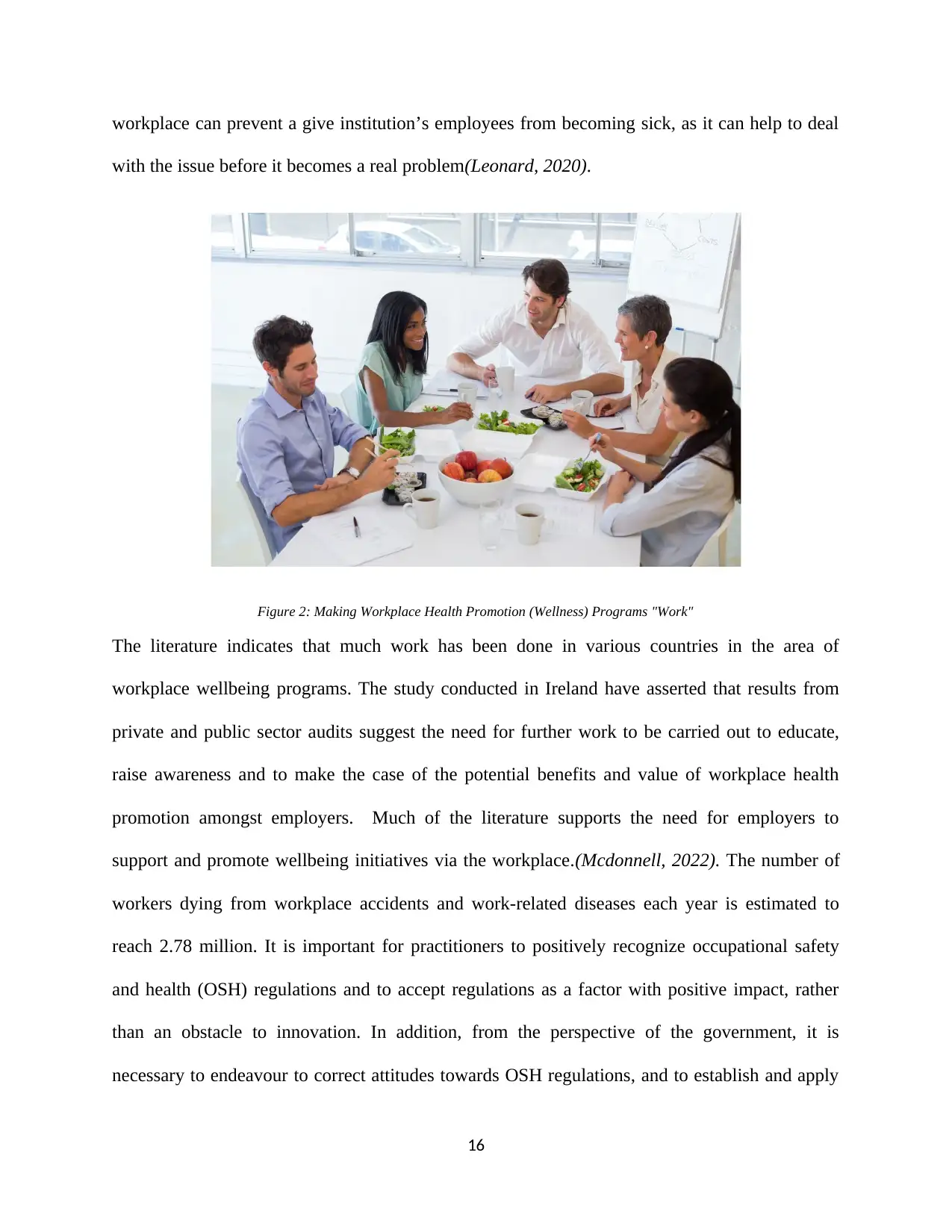
workplace can prevent a give institution’s employees from becoming sick, as it can help to deal
with the issue before it becomes a real problem(Leonard, 2020).
Figure 2: Making Workplace Health Promotion (Wellness) Programs "Work"
The literature indicates that much work has been done in various countries in the area of
workplace wellbeing programs. The study conducted in Ireland have asserted that results from
private and public sector audits suggest the need for further work to be carried out to educate,
raise awareness and to make the case of the potential benefits and value of workplace health
promotion amongst employers. Much of the literature supports the need for employers to
support and promote wellbeing initiatives via the workplace.(Mcdonnell, 2022). The number of
workers dying from workplace accidents and work-related diseases each year is estimated to
reach 2.78 million. It is important for practitioners to positively recognize occupational safety
and health (OSH) regulations and to accept regulations as a factor with positive impact, rather
than an obstacle to innovation. In addition, from the perspective of the government, it is
necessary to endeavour to correct attitudes towards OSH regulations, and to establish and apply
16
with the issue before it becomes a real problem(Leonard, 2020).
Figure 2: Making Workplace Health Promotion (Wellness) Programs "Work"
The literature indicates that much work has been done in various countries in the area of
workplace wellbeing programs. The study conducted in Ireland have asserted that results from
private and public sector audits suggest the need for further work to be carried out to educate,
raise awareness and to make the case of the potential benefits and value of workplace health
promotion amongst employers. Much of the literature supports the need for employers to
support and promote wellbeing initiatives via the workplace.(Mcdonnell, 2022). The number of
workers dying from workplace accidents and work-related diseases each year is estimated to
reach 2.78 million. It is important for practitioners to positively recognize occupational safety
and health (OSH) regulations and to accept regulations as a factor with positive impact, rather
than an obstacle to innovation. In addition, from the perspective of the government, it is
necessary to endeavour to correct attitudes towards OSH regulations, and to establish and apply
16
Secure Best Marks with AI Grader
Need help grading? Try our AI Grader for instant feedback on your assignments.
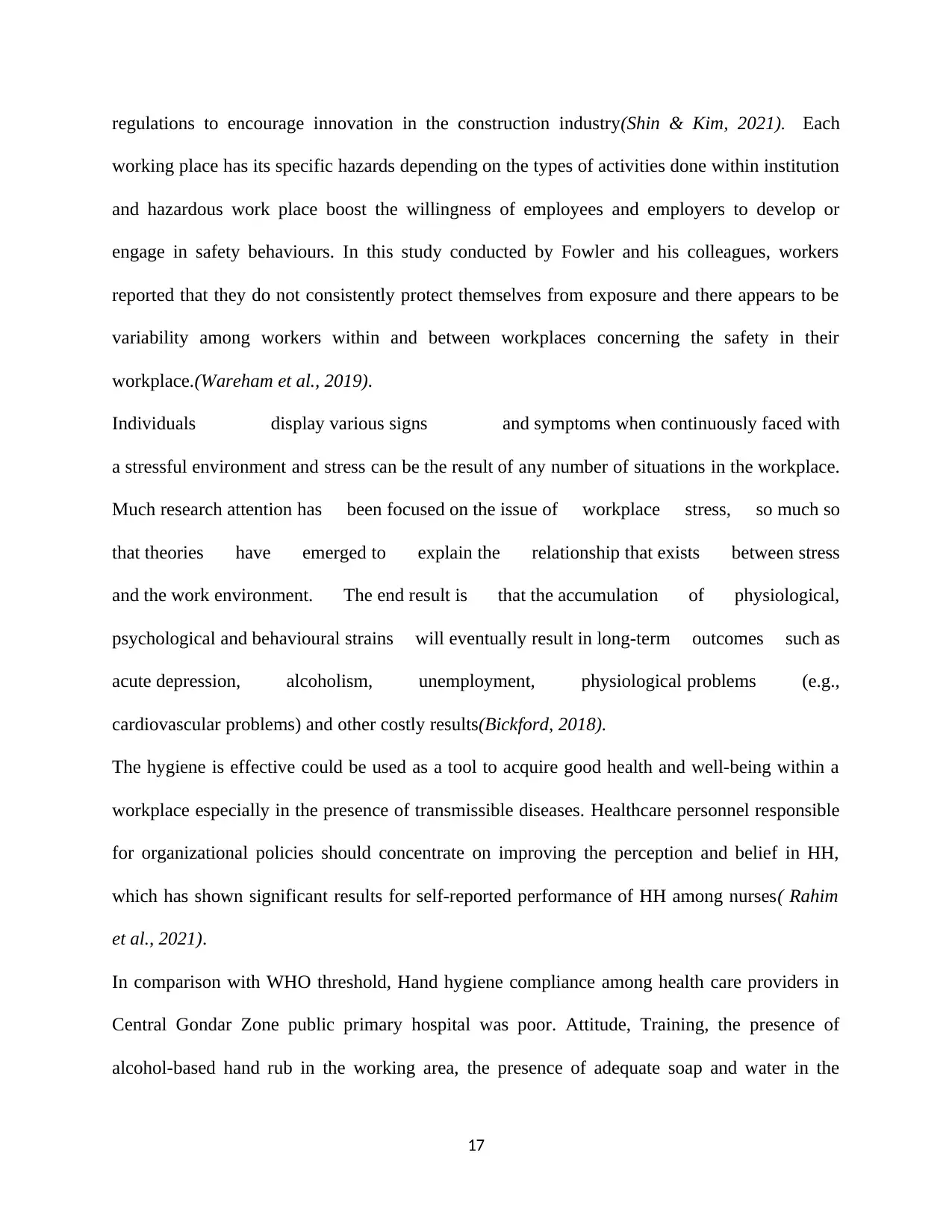
regulations to encourage innovation in the construction industry(Shin & Kim, 2021). Each
working place has its specific hazards depending on the types of activities done within institution
and hazardous work place boost the willingness of employees and employers to develop or
engage in safety behaviours. In this study conducted by Fowler and his colleagues, workers
reported that they do not consistently protect themselves from exposure and there appears to be
variability among workers within and between workplaces concerning the safety in their
workplace.(Wareham et al., 2019).
Individuals display various signs and symptoms when continuously faced with
a stressful environment and stress can be the result of any number of situations in the workplace.
Much research attention has been focused on the issue of workplace stress, so much so
that theories have emerged to explain the relationship that exists between stress
and the work environment. The end result is that the accumulation of physiological,
psychological and behavioural strains will eventually result in long-term outcomes such as
acute depression, alcoholism, unemployment, physiological problems (e.g.,
cardiovascular problems) and other costly results(Bickford, 2018).
The hygiene is effective could be used as a tool to acquire good health and well-being within a
workplace especially in the presence of transmissible diseases. Healthcare personnel responsible
for organizational policies should concentrate on improving the perception and belief in HH,
which has shown significant results for self-reported performance of HH among nurses( Rahim
et al., 2021).
In comparison with WHO threshold, Hand hygiene compliance among health care providers in
Central Gondar Zone public primary hospital was poor. Attitude, Training, the presence of
alcohol-based hand rub in the working area, the presence of adequate soap and water in the
17
working place has its specific hazards depending on the types of activities done within institution
and hazardous work place boost the willingness of employees and employers to develop or
engage in safety behaviours. In this study conducted by Fowler and his colleagues, workers
reported that they do not consistently protect themselves from exposure and there appears to be
variability among workers within and between workplaces concerning the safety in their
workplace.(Wareham et al., 2019).
Individuals display various signs and symptoms when continuously faced with
a stressful environment and stress can be the result of any number of situations in the workplace.
Much research attention has been focused on the issue of workplace stress, so much so
that theories have emerged to explain the relationship that exists between stress
and the work environment. The end result is that the accumulation of physiological,
psychological and behavioural strains will eventually result in long-term outcomes such as
acute depression, alcoholism, unemployment, physiological problems (e.g.,
cardiovascular problems) and other costly results(Bickford, 2018).
The hygiene is effective could be used as a tool to acquire good health and well-being within a
workplace especially in the presence of transmissible diseases. Healthcare personnel responsible
for organizational policies should concentrate on improving the perception and belief in HH,
which has shown significant results for self-reported performance of HH among nurses( Rahim
et al., 2021).
In comparison with WHO threshold, Hand hygiene compliance among health care providers in
Central Gondar Zone public primary hospital was poor. Attitude, Training, the presence of
alcohol-based hand rub in the working area, the presence of adequate soap and water in the
17

working area were significantly associated with hand hygiene compliance. The best method for
preventing healthcare associated infections and creating an environment free from infections is
the implementation of five moments of hand hygiene(Engdaw et al., 2019). The five critical
moments are; before touching a patient, before clean/aseptic procedure, after body fluid exposure
risk, after touching a patient, and after touching a patient’s surroundings. In addition to requiring
the health care environment to be free from infections, health care professionals have to be
trained about proper hand hygiene techniques and hand hygiene facilities and products should be
provided by the government or the owners of private health institutions(MoH, 2019).
Center of Disease Control and prevention (CDC) offers tools, information, and other resources to
help employers to develop and put in place evidence-based health and safety programs at their
work sites to reduce health risks and improve quality of workers’ life and created the Workplace
Health Resource Center (WHRC) to help employers use the Workplace Health Model and find
credible information for starting or expanding workplace health programs(CDC et al., 2020).
2.0.1 Workplace Health Model
The workplace is an important setting for health promotion, health protection and disease
prevention programs. Workplace health modal states that employers have a responsibility of
providing a safe and hazard-free workplace and they also have abundant opportunities to
promote individual health and foster a healthy work environment their employees. Maintaining a
healthier workforce can lower direct costs such as insurance premiums and worker’s
compensation claims and it can also positively impact many indirect costs such as absenteeism
and worker productivity. When employers engage in a variety of workplace health programs, the
supportive environments and safety is ensured and health can emerge(CDC et al., 2020).
18
preventing healthcare associated infections and creating an environment free from infections is
the implementation of five moments of hand hygiene(Engdaw et al., 2019). The five critical
moments are; before touching a patient, before clean/aseptic procedure, after body fluid exposure
risk, after touching a patient, and after touching a patient’s surroundings. In addition to requiring
the health care environment to be free from infections, health care professionals have to be
trained about proper hand hygiene techniques and hand hygiene facilities and products should be
provided by the government or the owners of private health institutions(MoH, 2019).
Center of Disease Control and prevention (CDC) offers tools, information, and other resources to
help employers to develop and put in place evidence-based health and safety programs at their
work sites to reduce health risks and improve quality of workers’ life and created the Workplace
Health Resource Center (WHRC) to help employers use the Workplace Health Model and find
credible information for starting or expanding workplace health programs(CDC et al., 2020).
2.0.1 Workplace Health Model
The workplace is an important setting for health promotion, health protection and disease
prevention programs. Workplace health modal states that employers have a responsibility of
providing a safe and hazard-free workplace and they also have abundant opportunities to
promote individual health and foster a healthy work environment their employees. Maintaining a
healthier workforce can lower direct costs such as insurance premiums and worker’s
compensation claims and it can also positively impact many indirect costs such as absenteeism
and worker productivity. When employers engage in a variety of workplace health programs, the
supportive environments and safety is ensured and health can emerge(CDC et al., 2020).
18
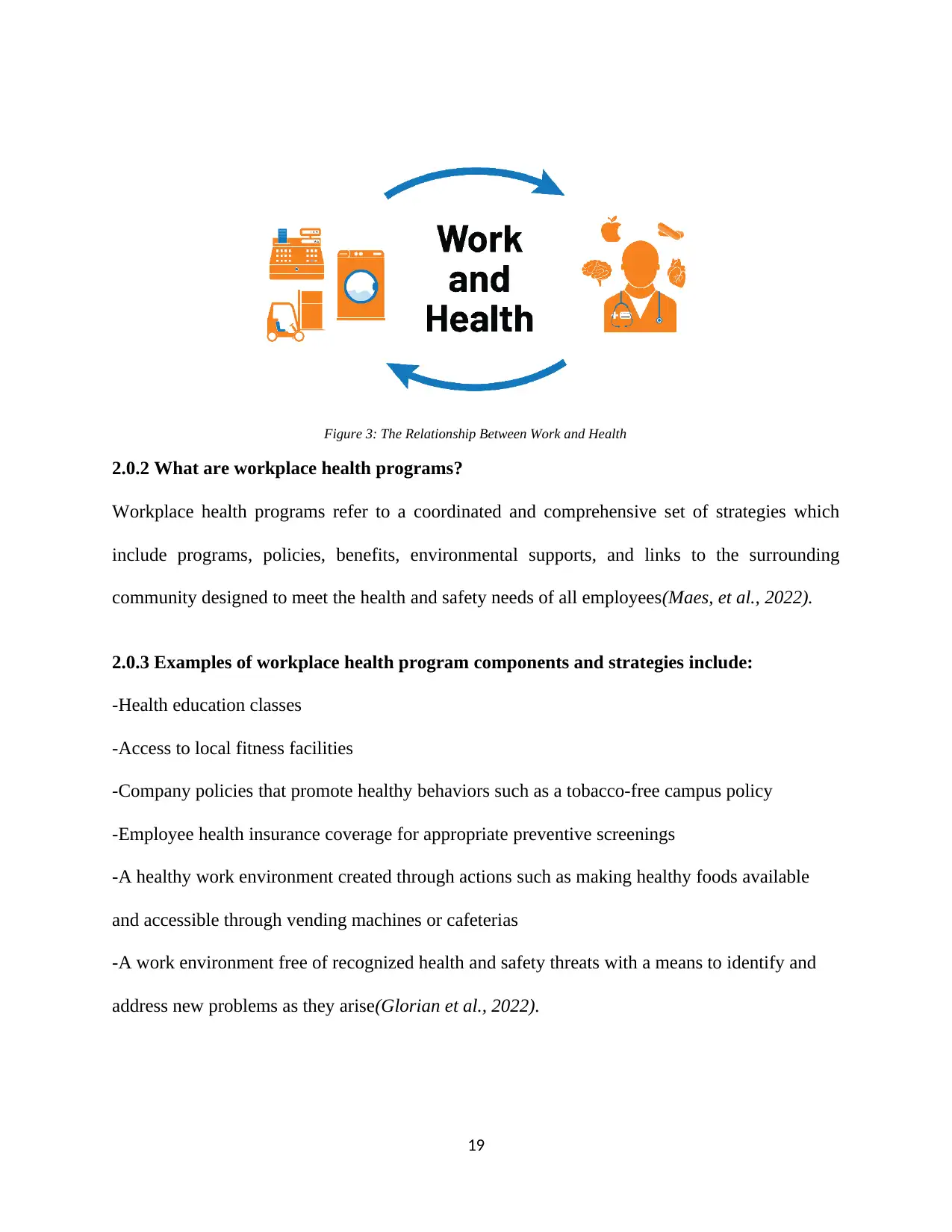
Figure 3: The Relationship Between Work and Health
2.0.2 What are workplace health programs?
Workplace health programs refer to a coordinated and comprehensive set of strategies which
include programs, policies, benefits, environmental supports, and links to the surrounding
community designed to meet the health and safety needs of all employees(Maes, et al., 2022).
2.0.3 Examples of workplace health program components and strategies include:
-Health education classes
-Access to local fitness facilities
-Company policies that promote healthy behaviors such as a tobacco-free campus policy
-Employee health insurance coverage for appropriate preventive screenings
-A healthy work environment created through actions such as making healthy foods available
and accessible through vending machines or cafeterias
-A work environment free of recognized health and safety threats with a means to identify and
address new problems as they arise(Glorian et al., 2022).
19
2.0.2 What are workplace health programs?
Workplace health programs refer to a coordinated and comprehensive set of strategies which
include programs, policies, benefits, environmental supports, and links to the surrounding
community designed to meet the health and safety needs of all employees(Maes, et al., 2022).
2.0.3 Examples of workplace health program components and strategies include:
-Health education classes
-Access to local fitness facilities
-Company policies that promote healthy behaviors such as a tobacco-free campus policy
-Employee health insurance coverage for appropriate preventive screenings
-A healthy work environment created through actions such as making healthy foods available
and accessible through vending machines or cafeterias
-A work environment free of recognized health and safety threats with a means to identify and
address new problems as they arise(Glorian et al., 2022).
19
Paraphrase This Document
Need a fresh take? Get an instant paraphrase of this document with our AI Paraphraser
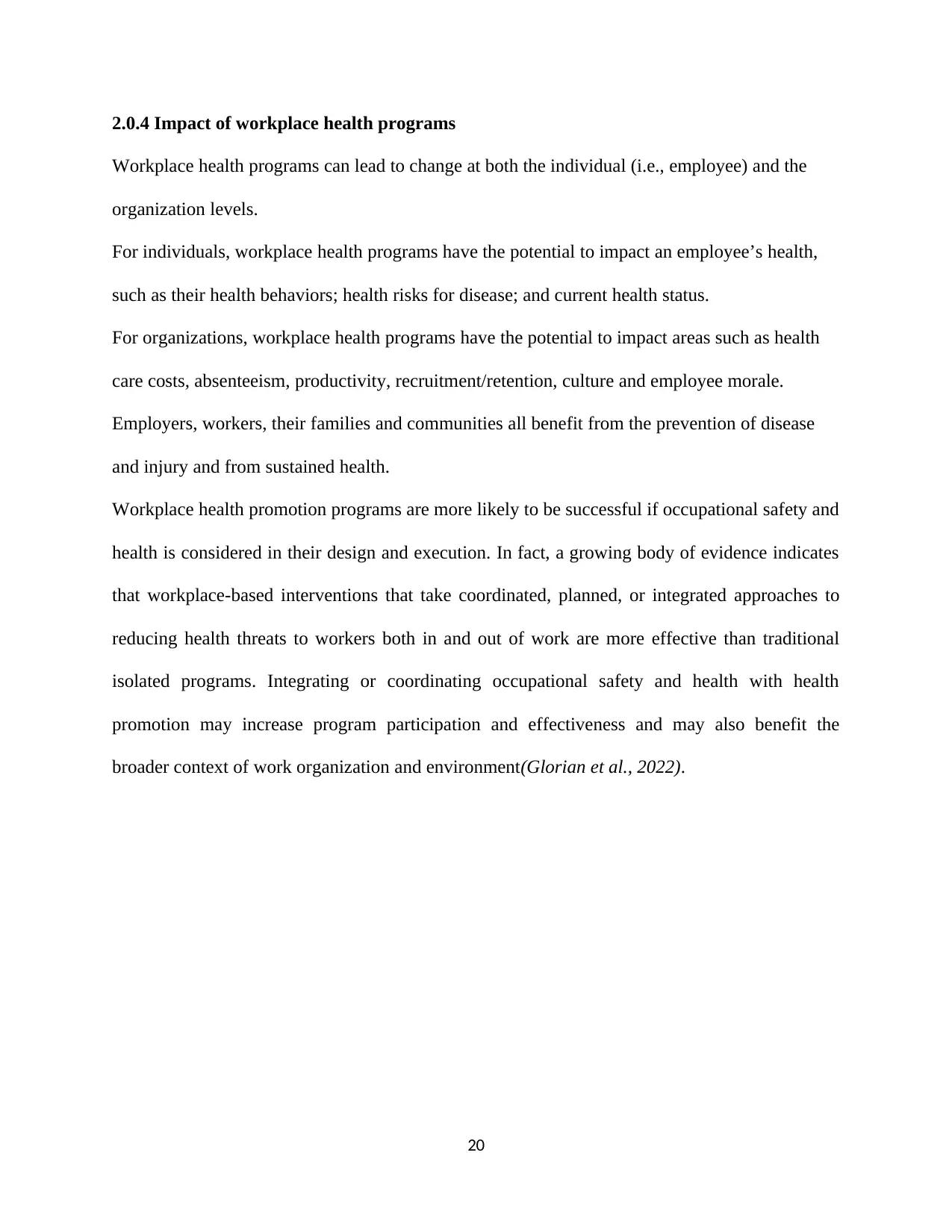
2.0.4 Impact of workplace health programs
Workplace health programs can lead to change at both the individual (i.e., employee) and the
organization levels.
For individuals, workplace health programs have the potential to impact an employee’s health,
such as their health behaviors; health risks for disease; and current health status.
For organizations, workplace health programs have the potential to impact areas such as health
care costs, absenteeism, productivity, recruitment/retention, culture and employee morale.
Employers, workers, their families and communities all benefit from the prevention of disease
and injury and from sustained health.
Workplace health promotion programs are more likely to be successful if occupational safety and
health is considered in their design and execution. In fact, a growing body of evidence indicates
that workplace-based interventions that take coordinated, planned, or integrated approaches to
reducing health threats to workers both in and out of work are more effective than traditional
isolated programs. Integrating or coordinating occupational safety and health with health
promotion may increase program participation and effectiveness and may also benefit the
broader context of work organization and environment(Glorian et al., 2022).
20
Workplace health programs can lead to change at both the individual (i.e., employee) and the
organization levels.
For individuals, workplace health programs have the potential to impact an employee’s health,
such as their health behaviors; health risks for disease; and current health status.
For organizations, workplace health programs have the potential to impact areas such as health
care costs, absenteeism, productivity, recruitment/retention, culture and employee morale.
Employers, workers, their families and communities all benefit from the prevention of disease
and injury and from sustained health.
Workplace health promotion programs are more likely to be successful if occupational safety and
health is considered in their design and execution. In fact, a growing body of evidence indicates
that workplace-based interventions that take coordinated, planned, or integrated approaches to
reducing health threats to workers both in and out of work are more effective than traditional
isolated programs. Integrating or coordinating occupational safety and health with health
promotion may increase program participation and effectiveness and may also benefit the
broader context of work organization and environment(Glorian et al., 2022).
20
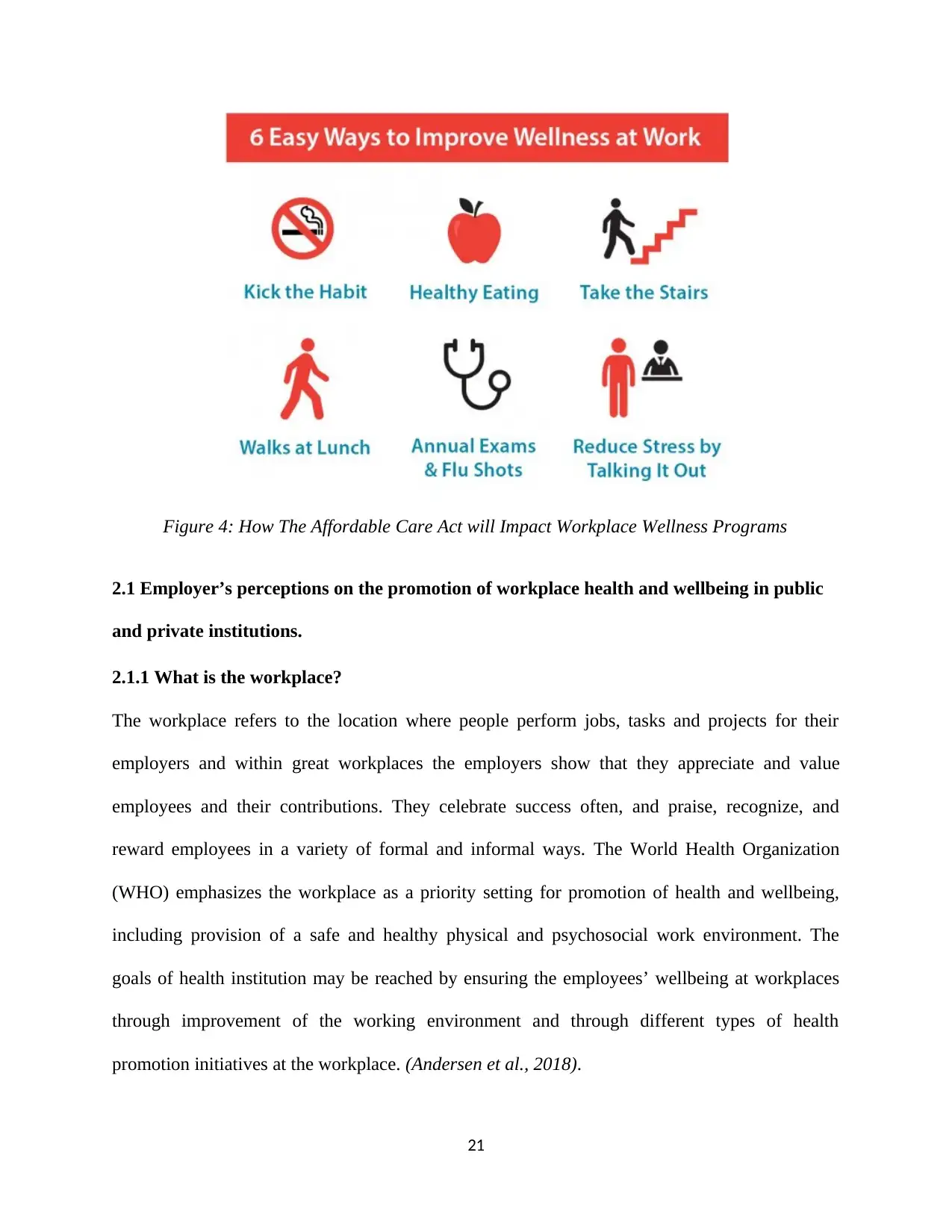
Figure 4: How The Affordable Care Act will Impact Workplace Wellness Programs
2.1 Employer’s perceptions on the promotion of workplace health and wellbeing in public
and private institutions.
2.1.1 What is the workplace?
The workplace refers to the location where people perform jobs, tasks and projects for their
employers and within great workplaces the employers show that they appreciate and value
employees and their contributions. They celebrate success often, and praise, recognize, and
reward employees in a variety of formal and informal ways. The World Health Organization
(WHO) emphasizes the workplace as a priority setting for promotion of health and wellbeing,
including provision of a safe and healthy physical and psychosocial work environment. The
goals of health institution may be reached by ensuring the employees’ wellbeing at workplaces
through improvement of the working environment and through different types of health
promotion initiatives at the workplace. (Andersen et al., 2018).
21
2.1 Employer’s perceptions on the promotion of workplace health and wellbeing in public
and private institutions.
2.1.1 What is the workplace?
The workplace refers to the location where people perform jobs, tasks and projects for their
employers and within great workplaces the employers show that they appreciate and value
employees and their contributions. They celebrate success often, and praise, recognize, and
reward employees in a variety of formal and informal ways. The World Health Organization
(WHO) emphasizes the workplace as a priority setting for promotion of health and wellbeing,
including provision of a safe and healthy physical and psychosocial work environment. The
goals of health institution may be reached by ensuring the employees’ wellbeing at workplaces
through improvement of the working environment and through different types of health
promotion initiatives at the workplace. (Andersen et al., 2018).
21
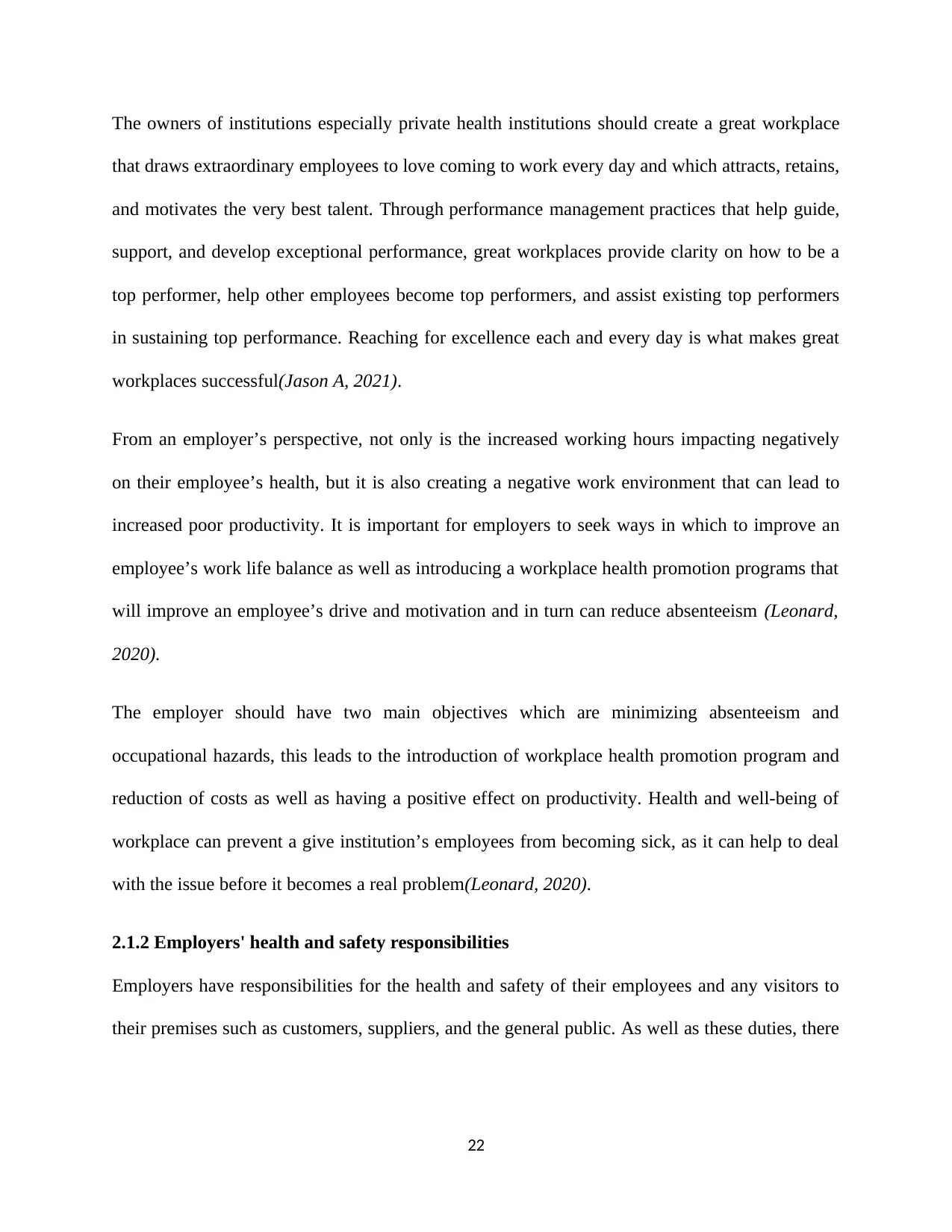
The owners of institutions especially private health institutions should create a great workplace
that draws extraordinary employees to love coming to work every day and which attracts, retains,
and motivates the very best talent. Through performance management practices that help guide,
support, and develop exceptional performance, great workplaces provide clarity on how to be a
top performer, help other employees become top performers, and assist existing top performers
in sustaining top performance. Reaching for excellence each and every day is what makes great
workplaces successful(Jason A, 2021).
From an employer’s perspective, not only is the increased working hours impacting negatively
on their employee’s health, but it is also creating a negative work environment that can lead to
increased poor productivity. It is important for employers to seek ways in which to improve an
employee’s work life balance as well as introducing a workplace health promotion programs that
will improve an employee’s drive and motivation and in turn can reduce absenteeism (Leonard,
2020).
The employer should have two main objectives which are minimizing absenteeism and
occupational hazards, this leads to the introduction of workplace health promotion program and
reduction of costs as well as having a positive effect on productivity. Health and well-being of
workplace can prevent a give institution’s employees from becoming sick, as it can help to deal
with the issue before it becomes a real problem(Leonard, 2020).
2.1.2 Employers' health and safety responsibilities
Employers have responsibilities for the health and safety of their employees and any visitors to
their premises such as customers, suppliers, and the general public. As well as these duties, there
22
that draws extraordinary employees to love coming to work every day and which attracts, retains,
and motivates the very best talent. Through performance management practices that help guide,
support, and develop exceptional performance, great workplaces provide clarity on how to be a
top performer, help other employees become top performers, and assist existing top performers
in sustaining top performance. Reaching for excellence each and every day is what makes great
workplaces successful(Jason A, 2021).
From an employer’s perspective, not only is the increased working hours impacting negatively
on their employee’s health, but it is also creating a negative work environment that can lead to
increased poor productivity. It is important for employers to seek ways in which to improve an
employee’s work life balance as well as introducing a workplace health promotion programs that
will improve an employee’s drive and motivation and in turn can reduce absenteeism (Leonard,
2020).
The employer should have two main objectives which are minimizing absenteeism and
occupational hazards, this leads to the introduction of workplace health promotion program and
reduction of costs as well as having a positive effect on productivity. Health and well-being of
workplace can prevent a give institution’s employees from becoming sick, as it can help to deal
with the issue before it becomes a real problem(Leonard, 2020).
2.1.2 Employers' health and safety responsibilities
Employers have responsibilities for the health and safety of their employees and any visitors to
their premises such as customers, suppliers, and the general public. As well as these duties, there
22
Secure Best Marks with AI Grader
Need help grading? Try our AI Grader for instant feedback on your assignments.
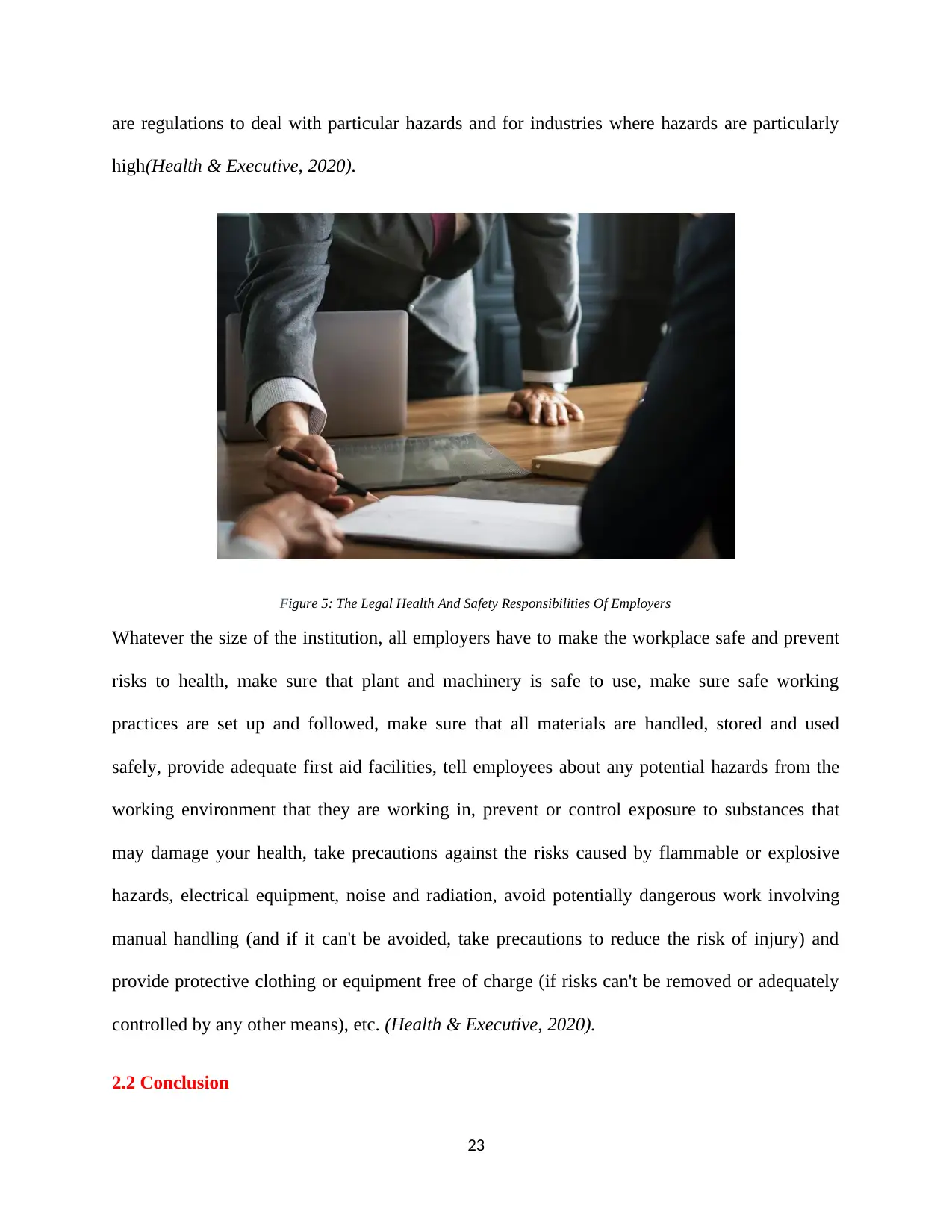
are regulations to deal with particular hazards and for industries where hazards are particularly
high(Health & Executive, 2020).
Figure 5: The Legal Health And Safety Responsibilities Of Employers
Whatever the size of the institution, all employers have to make the workplace safe and prevent
risks to health, make sure that plant and machinery is safe to use, make sure safe working
practices are set up and followed, make sure that all materials are handled, stored and used
safely, provide adequate first aid facilities, tell employees about any potential hazards from the
working environment that they are working in, prevent or control exposure to substances that
may damage your health, take precautions against the risks caused by flammable or explosive
hazards, electrical equipment, noise and radiation, avoid potentially dangerous work involving
manual handling (and if it can't be avoided, take precautions to reduce the risk of injury) and
provide protective clothing or equipment free of charge (if risks can't be removed or adequately
controlled by any other means), etc. (Health & Executive, 2020).
2.2 Conclusion
23
high(Health & Executive, 2020).
Figure 5: The Legal Health And Safety Responsibilities Of Employers
Whatever the size of the institution, all employers have to make the workplace safe and prevent
risks to health, make sure that plant and machinery is safe to use, make sure safe working
practices are set up and followed, make sure that all materials are handled, stored and used
safely, provide adequate first aid facilities, tell employees about any potential hazards from the
working environment that they are working in, prevent or control exposure to substances that
may damage your health, take precautions against the risks caused by flammable or explosive
hazards, electrical equipment, noise and radiation, avoid potentially dangerous work involving
manual handling (and if it can't be avoided, take precautions to reduce the risk of injury) and
provide protective clothing or equipment free of charge (if risks can't be removed or adequately
controlled by any other means), etc. (Health & Executive, 2020).
2.2 Conclusion
23
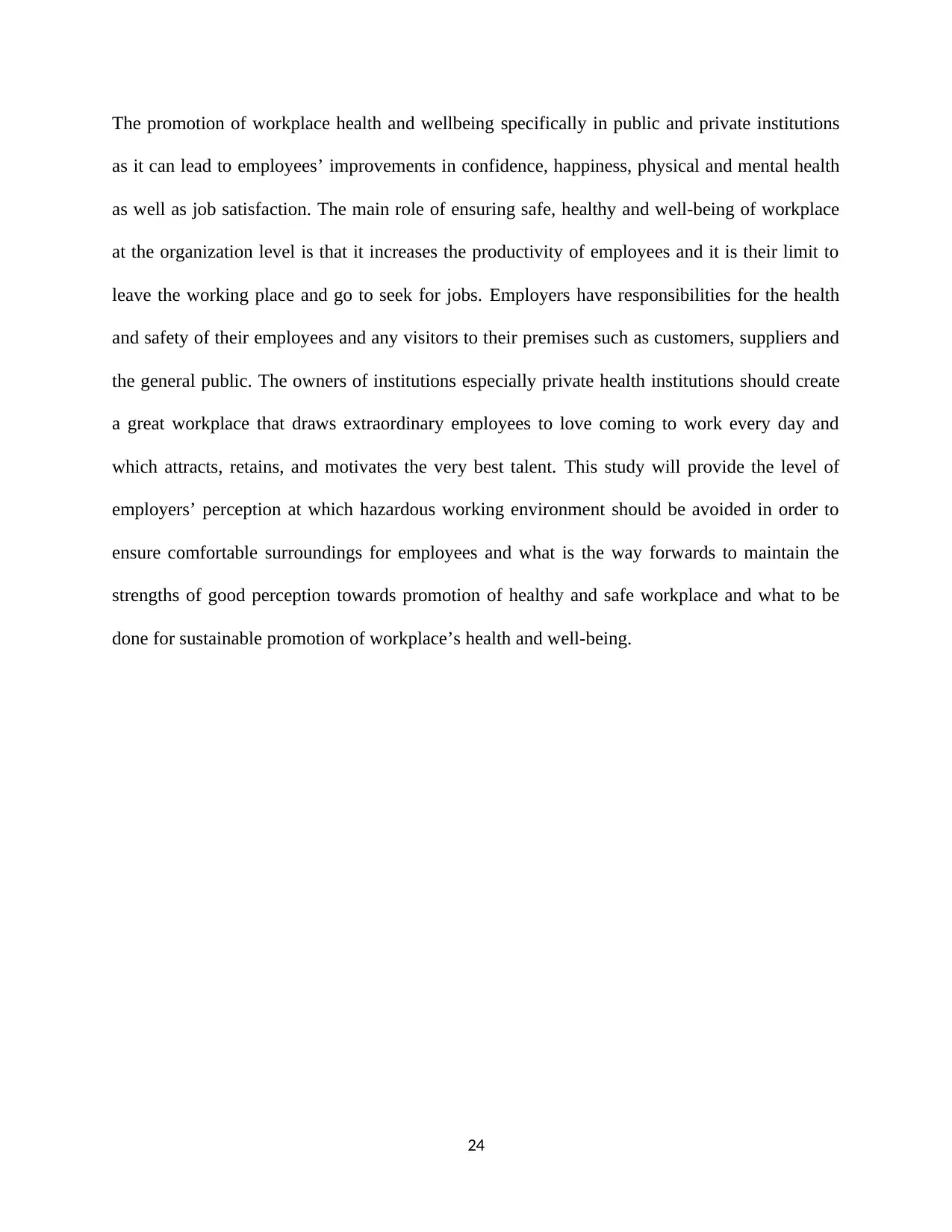
The promotion of workplace health and wellbeing specifically in public and private institutions
as it can lead to employees’ improvements in confidence, happiness, physical and mental health
as well as job satisfaction. The main role of ensuring safe, healthy and well-being of workplace
at the organization level is that it increases the productivity of employees and it is their limit to
leave the working place and go to seek for jobs. Employers have responsibilities for the health
and safety of their employees and any visitors to their premises such as customers, suppliers and
the general public. The owners of institutions especially private health institutions should create
a great workplace that draws extraordinary employees to love coming to work every day and
which attracts, retains, and motivates the very best talent. This study will provide the level of
employers’ perception at which hazardous working environment should be avoided in order to
ensure comfortable surroundings for employees and what is the way forwards to maintain the
strengths of good perception towards promotion of healthy and safe workplace and what to be
done for sustainable promotion of workplace’s health and well-being.
24
as it can lead to employees’ improvements in confidence, happiness, physical and mental health
as well as job satisfaction. The main role of ensuring safe, healthy and well-being of workplace
at the organization level is that it increases the productivity of employees and it is their limit to
leave the working place and go to seek for jobs. Employers have responsibilities for the health
and safety of their employees and any visitors to their premises such as customers, suppliers and
the general public. The owners of institutions especially private health institutions should create
a great workplace that draws extraordinary employees to love coming to work every day and
which attracts, retains, and motivates the very best talent. This study will provide the level of
employers’ perception at which hazardous working environment should be avoided in order to
ensure comfortable surroundings for employees and what is the way forwards to maintain the
strengths of good perception towards promotion of healthy and safe workplace and what to be
done for sustainable promotion of workplace’s health and well-being.
24
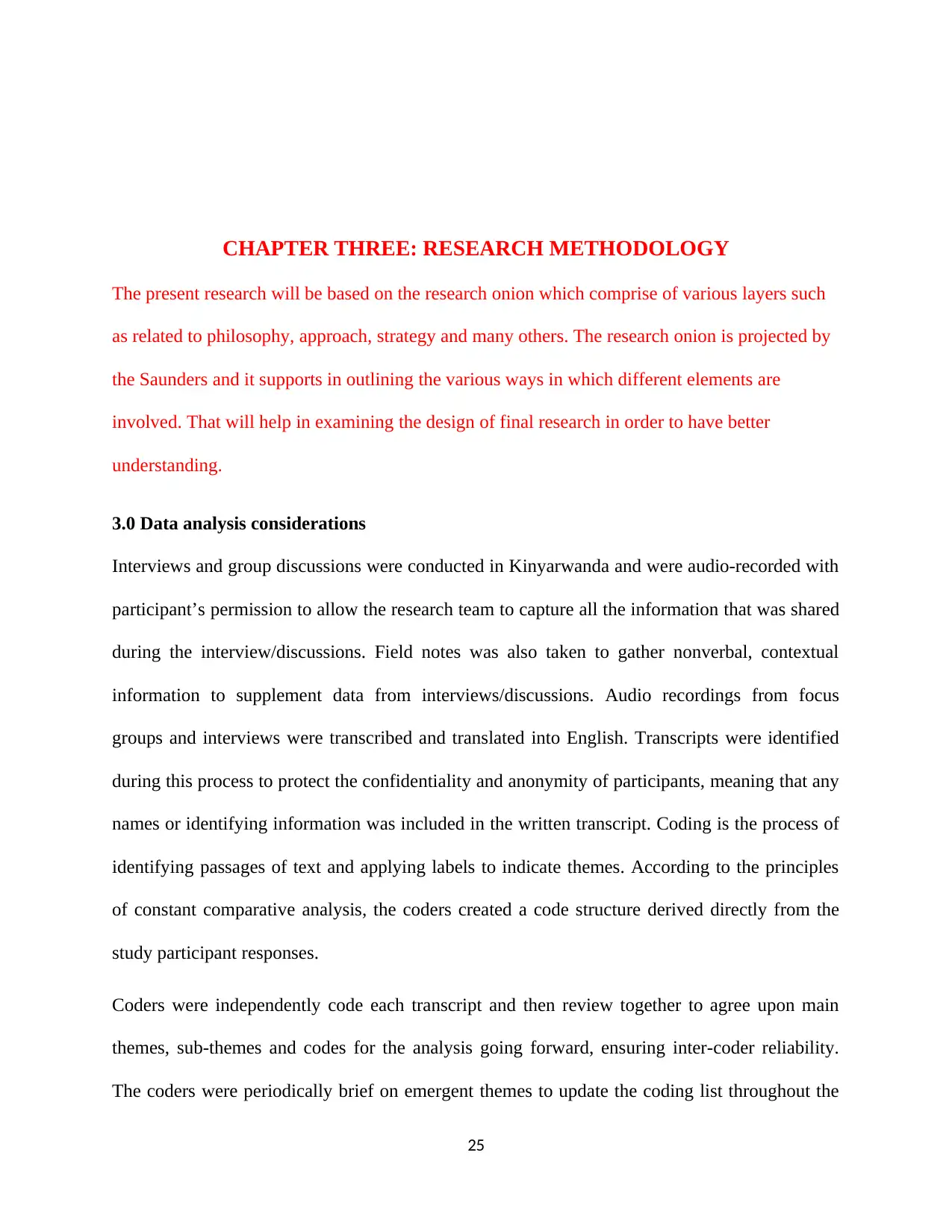
CHAPTER THREE: RESEARCH METHODOLOGY
The present research will be based on the research onion which comprise of various layers such
as related to philosophy, approach, strategy and many others. The research onion is projected by
the Saunders and it supports in outlining the various ways in which different elements are
involved. That will help in examining the design of final research in order to have better
understanding.
3.0 Data analysis considerations
Interviews and group discussions were conducted in Kinyarwanda and were audio-recorded with
participant’s permission to allow the research team to capture all the information that was shared
during the interview/discussions. Field notes was also taken to gather nonverbal, contextual
information to supplement data from interviews/discussions. Audio recordings from focus
groups and interviews were transcribed and translated into English. Transcripts were identified
during this process to protect the confidentiality and anonymity of participants, meaning that any
names or identifying information was included in the written transcript. Coding is the process of
identifying passages of text and applying labels to indicate themes. According to the principles
of constant comparative analysis, the coders created a code structure derived directly from the
study participant responses.
Coders were independently code each transcript and then review together to agree upon main
themes, sub-themes and codes for the analysis going forward, ensuring inter-coder reliability.
The coders were periodically brief on emergent themes to update the coding list throughout the
25
The present research will be based on the research onion which comprise of various layers such
as related to philosophy, approach, strategy and many others. The research onion is projected by
the Saunders and it supports in outlining the various ways in which different elements are
involved. That will help in examining the design of final research in order to have better
understanding.
3.0 Data analysis considerations
Interviews and group discussions were conducted in Kinyarwanda and were audio-recorded with
participant’s permission to allow the research team to capture all the information that was shared
during the interview/discussions. Field notes was also taken to gather nonverbal, contextual
information to supplement data from interviews/discussions. Audio recordings from focus
groups and interviews were transcribed and translated into English. Transcripts were identified
during this process to protect the confidentiality and anonymity of participants, meaning that any
names or identifying information was included in the written transcript. Coding is the process of
identifying passages of text and applying labels to indicate themes. According to the principles
of constant comparative analysis, the coders created a code structure derived directly from the
study participant responses.
Coders were independently code each transcript and then review together to agree upon main
themes, sub-themes and codes for the analysis going forward, ensuring inter-coder reliability.
The coders were periodically brief on emergent themes to update the coding list throughout the
25
Paraphrase This Document
Need a fresh take? Get an instant paraphrase of this document with our AI Paraphraser
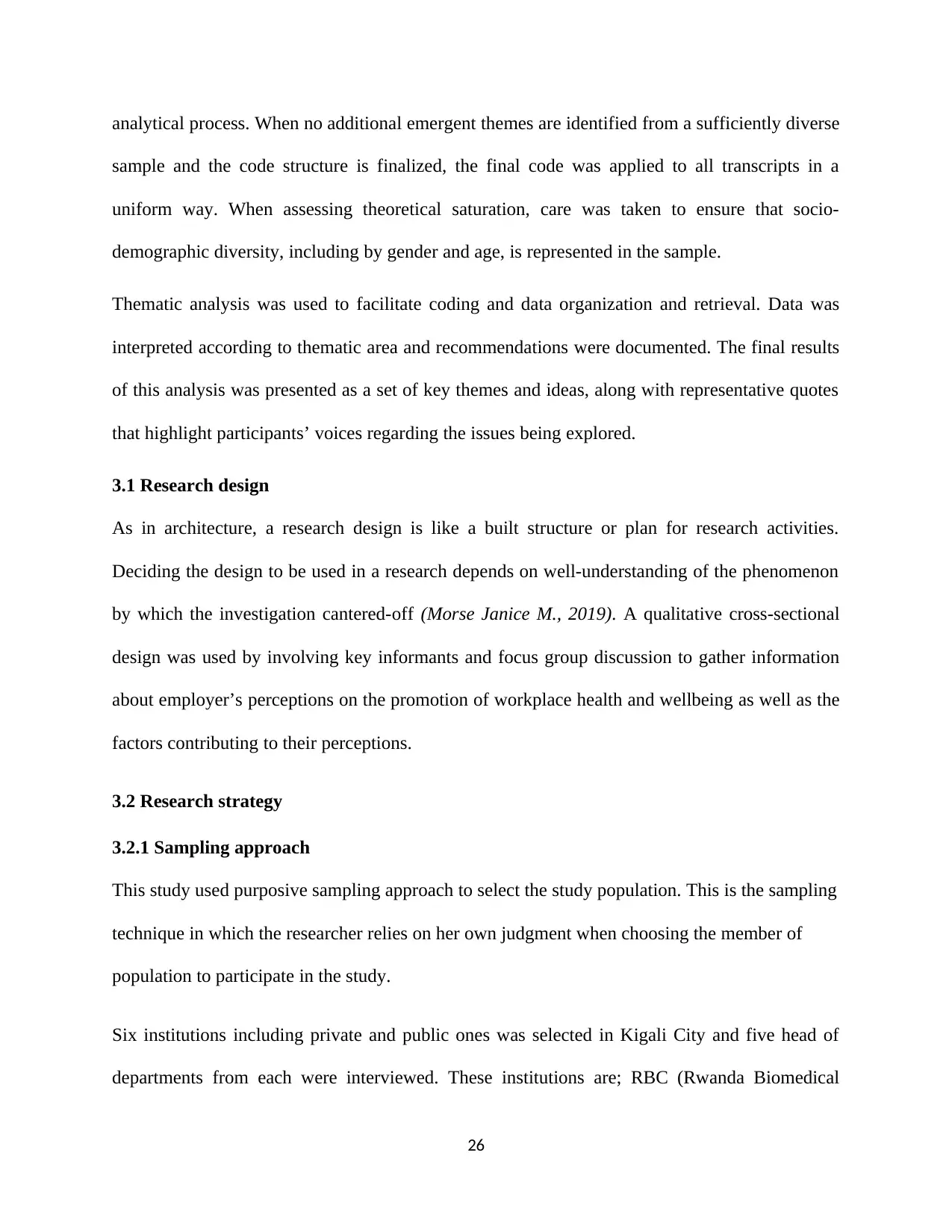
analytical process. When no additional emergent themes are identified from a sufficiently diverse
sample and the code structure is finalized, the final code was applied to all transcripts in a
uniform way. When assessing theoretical saturation, care was taken to ensure that socio-
demographic diversity, including by gender and age, is represented in the sample.
Thematic analysis was used to facilitate coding and data organization and retrieval. Data was
interpreted according to thematic area and recommendations were documented. The final results
of this analysis was presented as a set of key themes and ideas, along with representative quotes
that highlight participants’ voices regarding the issues being explored.
3.1 Research design
As in architecture, a research design is like a built structure or plan for research activities.
Deciding the design to be used in a research depends on well-understanding of the phenomenon
by which the investigation cantered-off (Morse Janice M., 2019). A qualitative cross-sectional
design was used by involving key informants and focus group discussion to gather information
about employer’s perceptions on the promotion of workplace health and wellbeing as well as the
factors contributing to their perceptions.
3.2 Research strategy
3.2.1 Sampling approach
This study used purposive sampling approach to select the study population. This is the sampling
technique in which the researcher relies on her own judgment when choosing the member of
population to participate in the study.
Six institutions including private and public ones was selected in Kigali City and five head of
departments from each were interviewed. These institutions are; RBC (Rwanda Biomedical
26
sample and the code structure is finalized, the final code was applied to all transcripts in a
uniform way. When assessing theoretical saturation, care was taken to ensure that socio-
demographic diversity, including by gender and age, is represented in the sample.
Thematic analysis was used to facilitate coding and data organization and retrieval. Data was
interpreted according to thematic area and recommendations were documented. The final results
of this analysis was presented as a set of key themes and ideas, along with representative quotes
that highlight participants’ voices regarding the issues being explored.
3.1 Research design
As in architecture, a research design is like a built structure or plan for research activities.
Deciding the design to be used in a research depends on well-understanding of the phenomenon
by which the investigation cantered-off (Morse Janice M., 2019). A qualitative cross-sectional
design was used by involving key informants and focus group discussion to gather information
about employer’s perceptions on the promotion of workplace health and wellbeing as well as the
factors contributing to their perceptions.
3.2 Research strategy
3.2.1 Sampling approach
This study used purposive sampling approach to select the study population. This is the sampling
technique in which the researcher relies on her own judgment when choosing the member of
population to participate in the study.
Six institutions including private and public ones was selected in Kigali City and five head of
departments from each were interviewed. These institutions are; RBC (Rwanda Biomedical
26
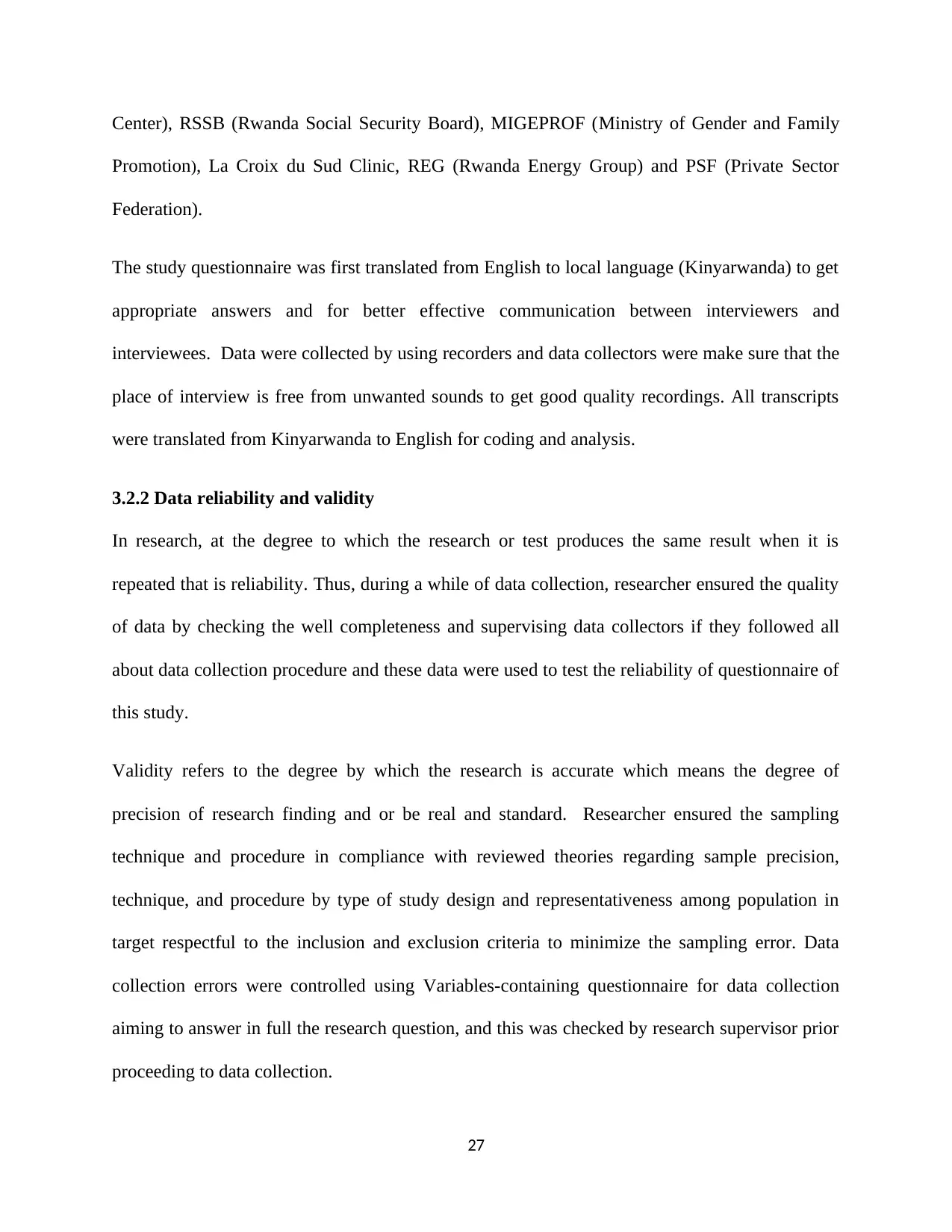
Center), RSSB (Rwanda Social Security Board), MIGEPROF (Ministry of Gender and Family
Promotion), La Croix du Sud Clinic, REG (Rwanda Energy Group) and PSF (Private Sector
Federation).
The study questionnaire was first translated from English to local language (Kinyarwanda) to get
appropriate answers and for better effective communication between interviewers and
interviewees. Data were collected by using recorders and data collectors were make sure that the
place of interview is free from unwanted sounds to get good quality recordings. All transcripts
were translated from Kinyarwanda to English for coding and analysis.
3.2.2 Data reliability and validity
In research, at the degree to which the research or test produces the same result when it is
repeated that is reliability. Thus, during a while of data collection, researcher ensured the quality
of data by checking the well completeness and supervising data collectors if they followed all
about data collection procedure and these data were used to test the reliability of questionnaire of
this study.
Validity refers to the degree by which the research is accurate which means the degree of
precision of research finding and or be real and standard. Researcher ensured the sampling
technique and procedure in compliance with reviewed theories regarding sample precision,
technique, and procedure by type of study design and representativeness among population in
target respectful to the inclusion and exclusion criteria to minimize the sampling error. Data
collection errors were controlled using Variables-containing questionnaire for data collection
aiming to answer in full the research question, and this was checked by research supervisor prior
proceeding to data collection.
27
Promotion), La Croix du Sud Clinic, REG (Rwanda Energy Group) and PSF (Private Sector
Federation).
The study questionnaire was first translated from English to local language (Kinyarwanda) to get
appropriate answers and for better effective communication between interviewers and
interviewees. Data were collected by using recorders and data collectors were make sure that the
place of interview is free from unwanted sounds to get good quality recordings. All transcripts
were translated from Kinyarwanda to English for coding and analysis.
3.2.2 Data reliability and validity
In research, at the degree to which the research or test produces the same result when it is
repeated that is reliability. Thus, during a while of data collection, researcher ensured the quality
of data by checking the well completeness and supervising data collectors if they followed all
about data collection procedure and these data were used to test the reliability of questionnaire of
this study.
Validity refers to the degree by which the research is accurate which means the degree of
precision of research finding and or be real and standard. Researcher ensured the sampling
technique and procedure in compliance with reviewed theories regarding sample precision,
technique, and procedure by type of study design and representativeness among population in
target respectful to the inclusion and exclusion criteria to minimize the sampling error. Data
collection errors were controlled using Variables-containing questionnaire for data collection
aiming to answer in full the research question, and this was checked by research supervisor prior
proceeding to data collection.
27
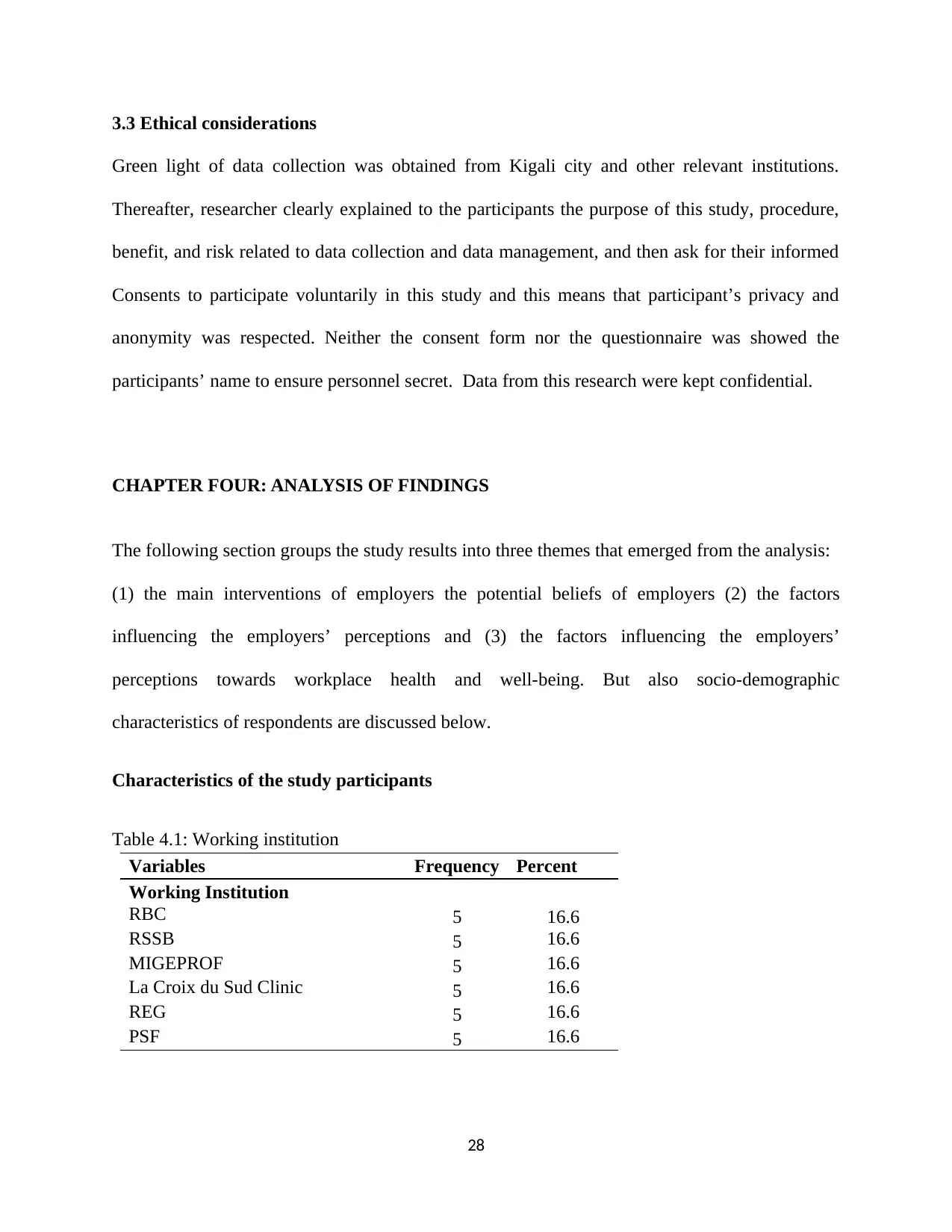
3.3 Ethical considerations
Green light of data collection was obtained from Kigali city and other relevant institutions.
Thereafter, researcher clearly explained to the participants the purpose of this study, procedure,
benefit, and risk related to data collection and data management, and then ask for their informed
Consents to participate voluntarily in this study and this means that participant’s privacy and
anonymity was respected. Neither the consent form nor the questionnaire was showed the
participants’ name to ensure personnel secret. Data from this research were kept confidential.
CHAPTER FOUR: ANALYSIS OF FINDINGS
The following section groups the study results into three themes that emerged from the analysis:
(1) the main interventions of employers the potential beliefs of employers (2) the factors
influencing the employers’ perceptions and (3) the factors influencing the employers’
perceptions towards workplace health and well-being. But also socio-demographic
characteristics of respondents are discussed below.
Characteristics of the study participants
Table 4.1: Working institution
Variables Frequency Percent
Working Institution
RBC 5 16.6
RSSB 5 16.6
MIGEPROF 5 16.6
La Croix du Sud Clinic 5 16.6
REG 5 16.6
PSF 5 16.6
28
Green light of data collection was obtained from Kigali city and other relevant institutions.
Thereafter, researcher clearly explained to the participants the purpose of this study, procedure,
benefit, and risk related to data collection and data management, and then ask for their informed
Consents to participate voluntarily in this study and this means that participant’s privacy and
anonymity was respected. Neither the consent form nor the questionnaire was showed the
participants’ name to ensure personnel secret. Data from this research were kept confidential.
CHAPTER FOUR: ANALYSIS OF FINDINGS
The following section groups the study results into three themes that emerged from the analysis:
(1) the main interventions of employers the potential beliefs of employers (2) the factors
influencing the employers’ perceptions and (3) the factors influencing the employers’
perceptions towards workplace health and well-being. But also socio-demographic
characteristics of respondents are discussed below.
Characteristics of the study participants
Table 4.1: Working institution
Variables Frequency Percent
Working Institution
RBC 5 16.6
RSSB 5 16.6
MIGEPROF 5 16.6
La Croix du Sud Clinic 5 16.6
REG 5 16.6
PSF 5 16.6
28
Secure Best Marks with AI Grader
Need help grading? Try our AI Grader for instant feedback on your assignments.
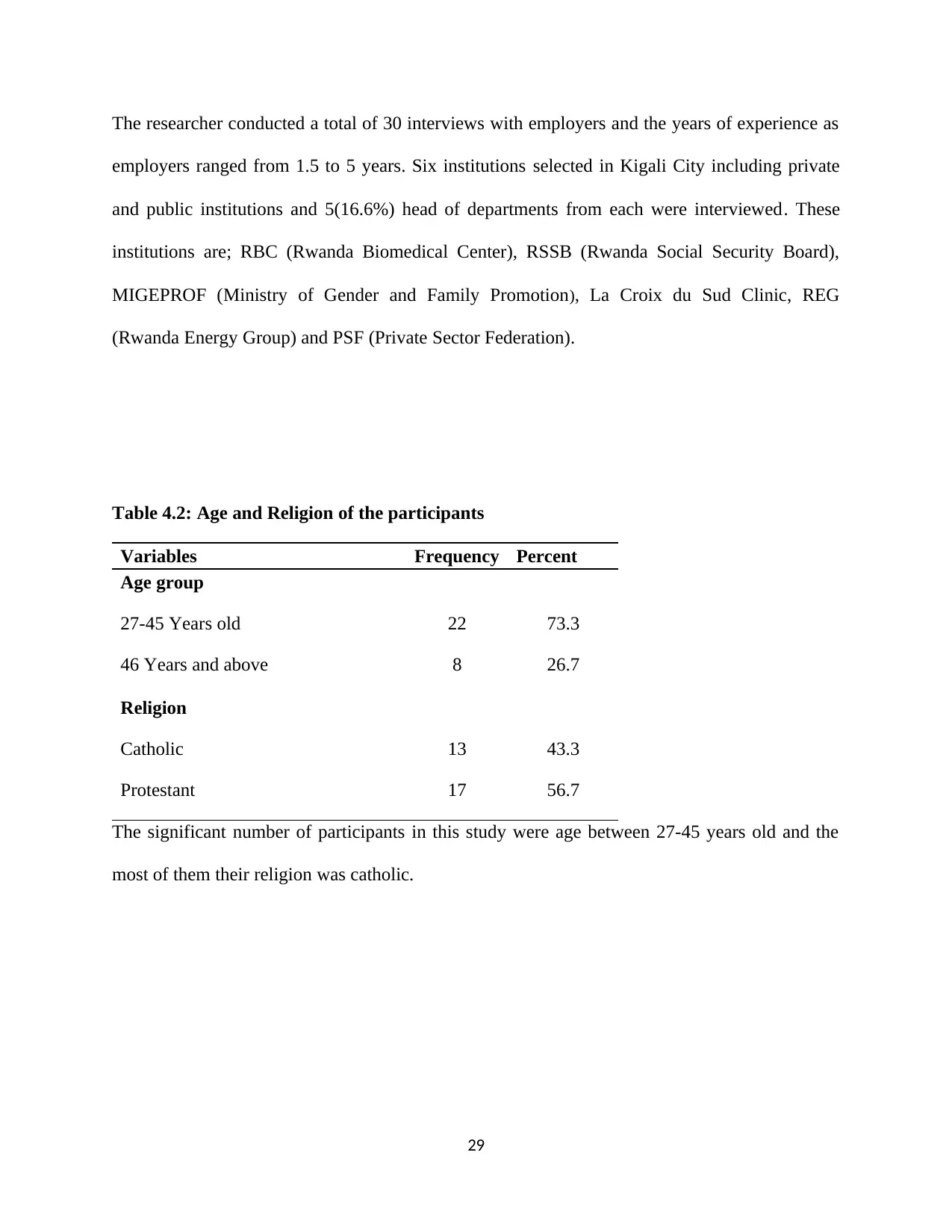
The researcher conducted a total of 30 interviews with employers and the years of experience as
employers ranged from 1.5 to 5 years. Six institutions selected in Kigali City including private
and public institutions and 5(16.6%) head of departments from each were interviewed. These
institutions are; RBC (Rwanda Biomedical Center), RSSB (Rwanda Social Security Board),
MIGEPROF (Ministry of Gender and Family Promotion), La Croix du Sud Clinic, REG
(Rwanda Energy Group) and PSF (Private Sector Federation).
Table 4.2: Age and Religion of the participants
Variables Frequency Percent
Age group
27-45 Years old 22 73.3
46 Years and above 8 26.7
Religion
Catholic 13 43.3
Protestant 17 56.7
The significant number of participants in this study were age between 27-45 years old and the
most of them their religion was catholic.
29
employers ranged from 1.5 to 5 years. Six institutions selected in Kigali City including private
and public institutions and 5(16.6%) head of departments from each were interviewed. These
institutions are; RBC (Rwanda Biomedical Center), RSSB (Rwanda Social Security Board),
MIGEPROF (Ministry of Gender and Family Promotion), La Croix du Sud Clinic, REG
(Rwanda Energy Group) and PSF (Private Sector Federation).
Table 4.2: Age and Religion of the participants
Variables Frequency Percent
Age group
27-45 Years old 22 73.3
46 Years and above 8 26.7
Religion
Catholic 13 43.3
Protestant 17 56.7
The significant number of participants in this study were age between 27-45 years old and the
most of them their religion was catholic.
29
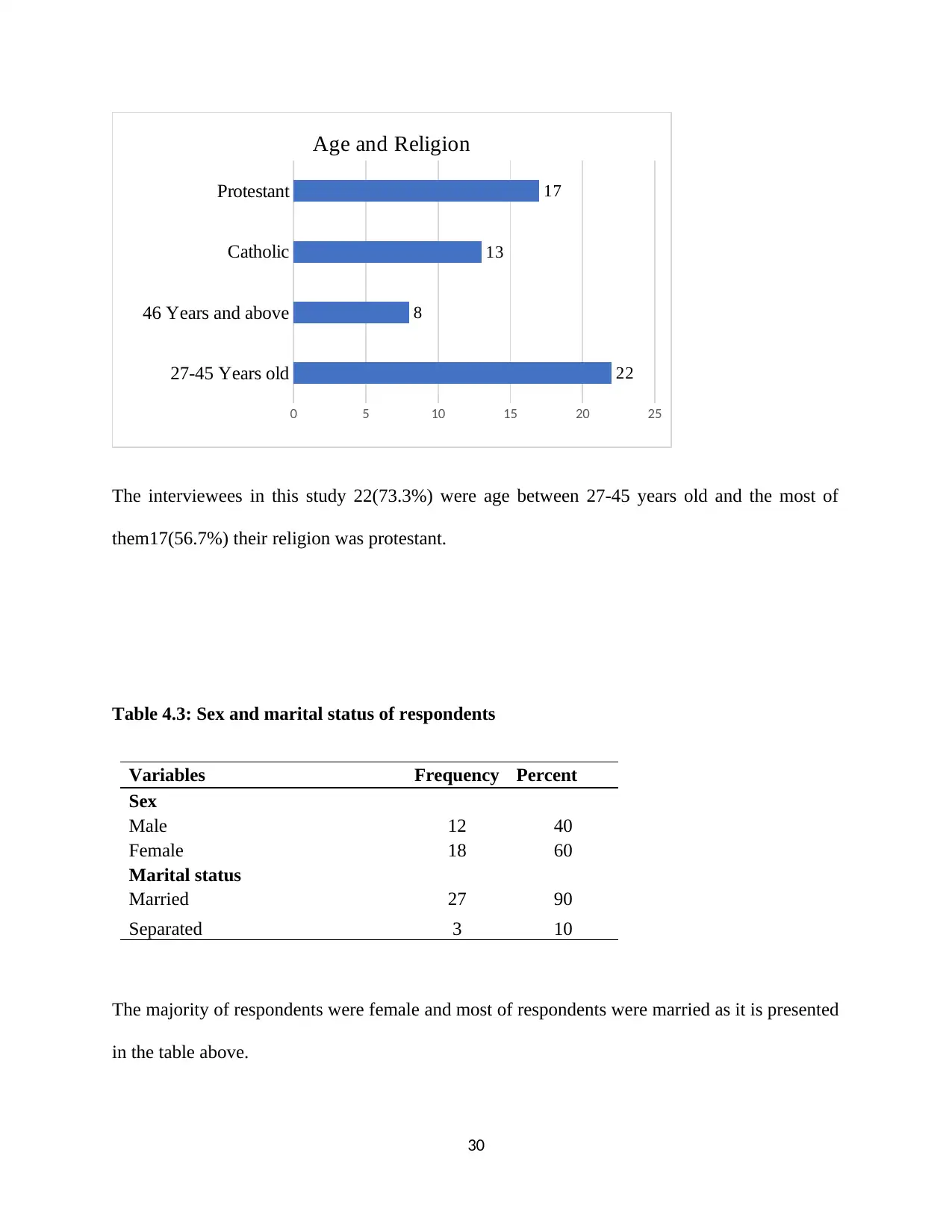
27-45 Years old
46 Years and above
Catholic
Protestant
0 5 10 15 20 25
22
8
13
17
Age and Religion
The interviewees in this study 22(73.3%) were age between 27-45 years old and the most of
them17(56.7%) their religion was protestant.
Table 4.3: Sex and marital status of respondents
Variables Frequency Percent
Sex
Male 12 40
Female 18 60
Marital status
Married 27 90
Separated 3 10
The majority of respondents were female and most of respondents were married as it is presented
in the table above.
30
46 Years and above
Catholic
Protestant
0 5 10 15 20 25
22
8
13
17
Age and Religion
The interviewees in this study 22(73.3%) were age between 27-45 years old and the most of
them17(56.7%) their religion was protestant.
Table 4.3: Sex and marital status of respondents
Variables Frequency Percent
Sex
Male 12 40
Female 18 60
Marital status
Married 27 90
Separated 3 10
The majority of respondents were female and most of respondents were married as it is presented
in the table above.
30
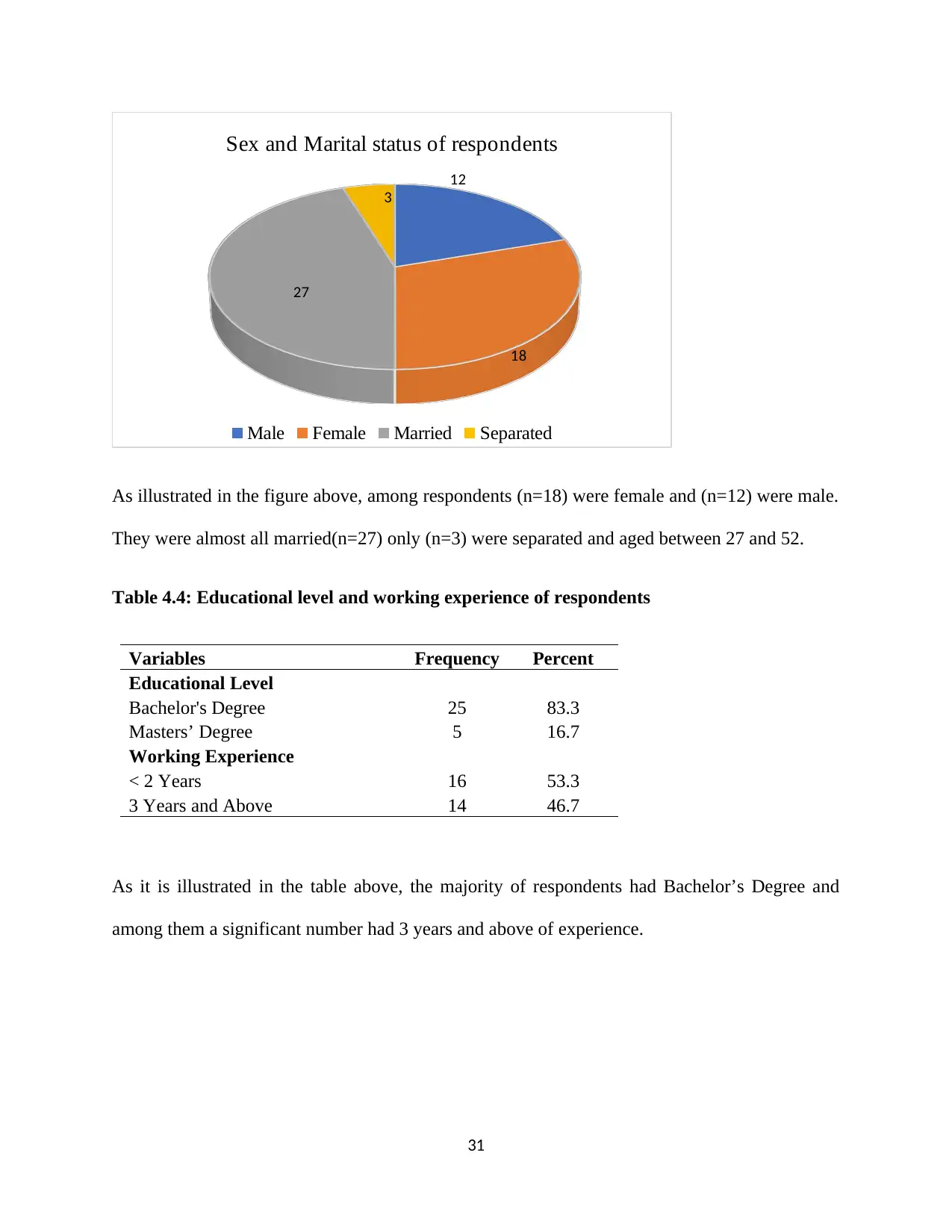
12
18
27
3
Sex and Marital status of respondents
Male Female Married Separated
As illustrated in the figure above, among respondents (n=18) were female and (n=12) were male.
They were almost all married(n=27) only (n=3) were separated and aged between 27 and 52.
Table 4.4: Educational level and working experience of respondents
Variables Frequency Percent
Educational Level
Bachelor's Degree 25 83.3
Masters’ Degree 5 16.7
Working Experience
< 2 Years 16 53.3
3 Years and Above 14 46.7
As it is illustrated in the table above, the majority of respondents had Bachelor’s Degree and
among them a significant number had 3 years and above of experience.
31
18
27
3
Sex and Marital status of respondents
Male Female Married Separated
As illustrated in the figure above, among respondents (n=18) were female and (n=12) were male.
They were almost all married(n=27) only (n=3) were separated and aged between 27 and 52.
Table 4.4: Educational level and working experience of respondents
Variables Frequency Percent
Educational Level
Bachelor's Degree 25 83.3
Masters’ Degree 5 16.7
Working Experience
< 2 Years 16 53.3
3 Years and Above 14 46.7
As it is illustrated in the table above, the majority of respondents had Bachelor’s Degree and
among them a significant number had 3 years and above of experience.
31
Paraphrase This Document
Need a fresh take? Get an instant paraphrase of this document with our AI Paraphraser
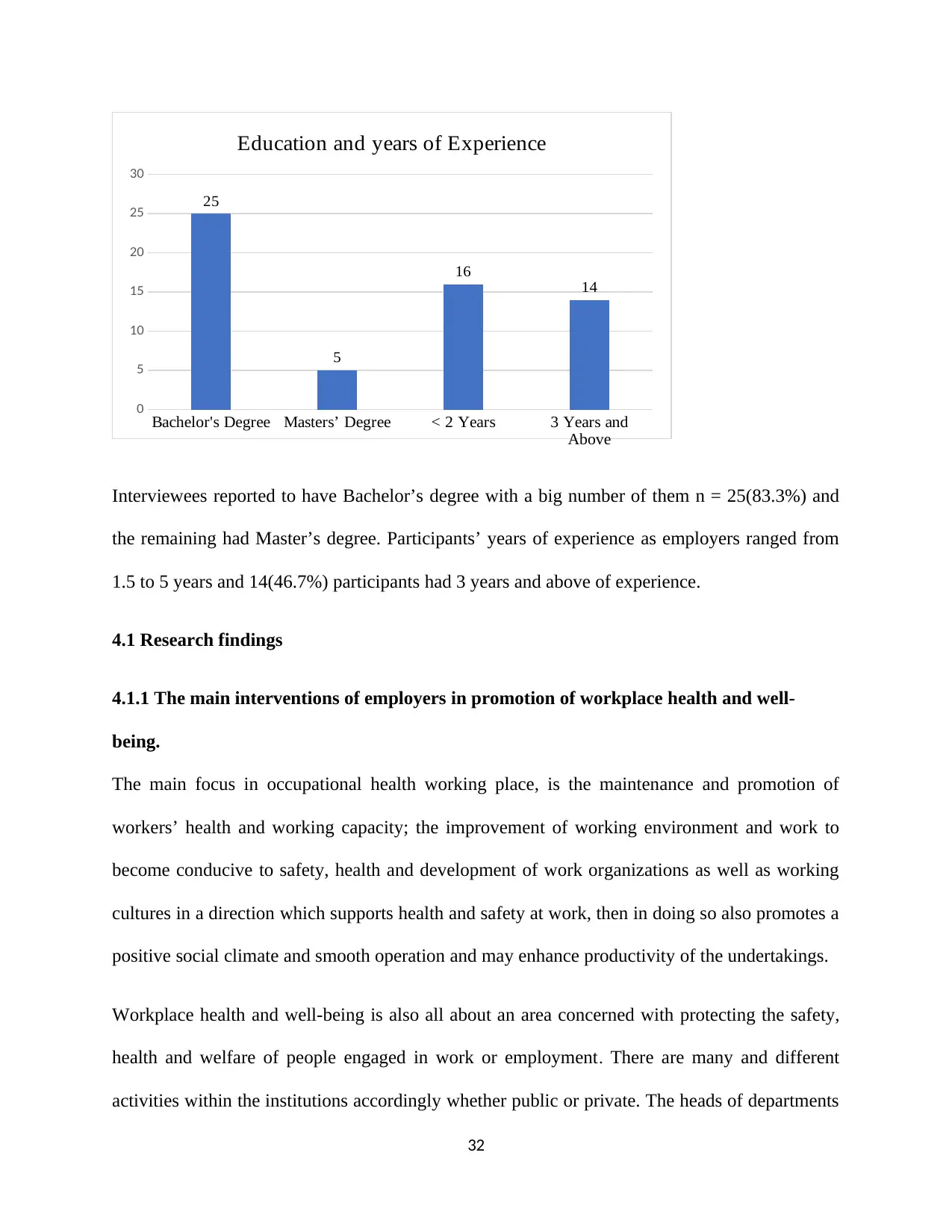
Bachelor's Degree Masters’ Degree < 2 Years 3 Years and
Above
0
5
10
15
20
25
30
25
5
16
14
Education and years of Experience
Interviewees reported to have Bachelor’s degree with a big number of them n = 25(83.3%) and
the remaining had Master’s degree. Participants’ years of experience as employers ranged from
1.5 to 5 years and 14(46.7%) participants had 3 years and above of experience.
4.1 Research findings
4.1.1 The main interventions of employers in promotion of workplace health and well-
being.
The main focus in occupational health working place, is the maintenance and promotion of
workers’ health and working capacity; the improvement of working environment and work to
become conducive to safety, health and development of work organizations as well as working
cultures in a direction which supports health and safety at work, then in doing so also promotes a
positive social climate and smooth operation and may enhance productivity of the undertakings.
Workplace health and well-being is also all about an area concerned with protecting the safety,
health and welfare of people engaged in work or employment. There are many and different
activities within the institutions accordingly whether public or private. The heads of departments
32
Above
0
5
10
15
20
25
30
25
5
16
14
Education and years of Experience
Interviewees reported to have Bachelor’s degree with a big number of them n = 25(83.3%) and
the remaining had Master’s degree. Participants’ years of experience as employers ranged from
1.5 to 5 years and 14(46.7%) participants had 3 years and above of experience.
4.1 Research findings
4.1.1 The main interventions of employers in promotion of workplace health and well-
being.
The main focus in occupational health working place, is the maintenance and promotion of
workers’ health and working capacity; the improvement of working environment and work to
become conducive to safety, health and development of work organizations as well as working
cultures in a direction which supports health and safety at work, then in doing so also promotes a
positive social climate and smooth operation and may enhance productivity of the undertakings.
Workplace health and well-being is also all about an area concerned with protecting the safety,
health and welfare of people engaged in work or employment. There are many and different
activities within the institutions accordingly whether public or private. The heads of departments
32
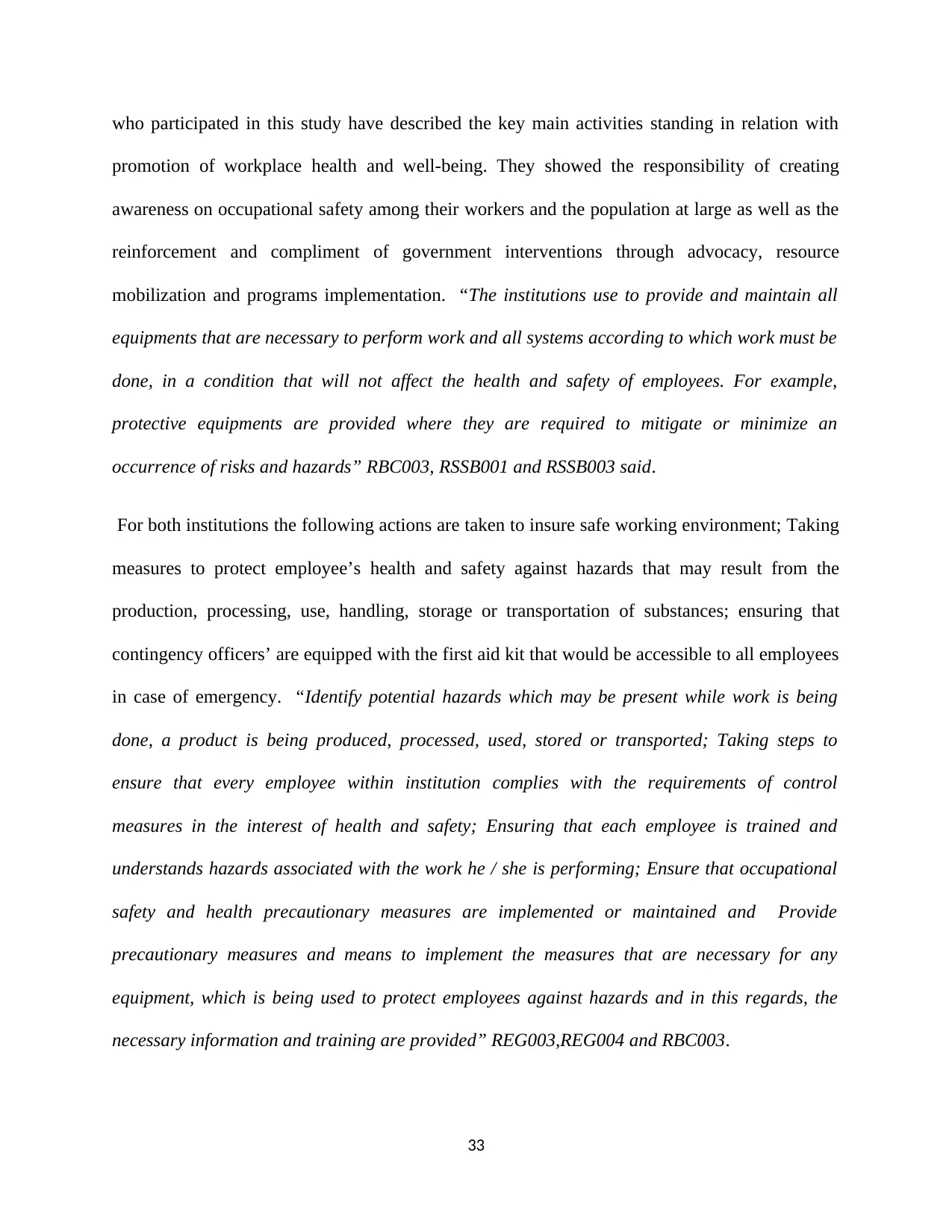
who participated in this study have described the key main activities standing in relation with
promotion of workplace health and well-being. They showed the responsibility of creating
awareness on occupational safety among their workers and the population at large as well as the
reinforcement and compliment of government interventions through advocacy, resource
mobilization and programs implementation. “The institutions use to provide and maintain all
equipments that are necessary to perform work and all systems according to which work must be
done, in a condition that will not affect the health and safety of employees. For example,
protective equipments are provided where they are required to mitigate or minimize an
occurrence of risks and hazards” RBC003, RSSB001 and RSSB003 said.
For both institutions the following actions are taken to insure safe working environment; Taking
measures to protect employee’s health and safety against hazards that may result from the
production, processing, use, handling, storage or transportation of substances; ensuring that
contingency officers’ are equipped with the first aid kit that would be accessible to all employees
in case of emergency. “Identify potential hazards which may be present while work is being
done, a product is being produced, processed, used, stored or transported; Taking steps to
ensure that every employee within institution complies with the requirements of control
measures in the interest of health and safety; Ensuring that each employee is trained and
understands hazards associated with the work he / she is performing; Ensure that occupational
safety and health precautionary measures are implemented or maintained and Provide
precautionary measures and means to implement the measures that are necessary for any
equipment, which is being used to protect employees against hazards and in this regards, the
necessary information and training are provided” REG003,REG004 and RBC003.
33
promotion of workplace health and well-being. They showed the responsibility of creating
awareness on occupational safety among their workers and the population at large as well as the
reinforcement and compliment of government interventions through advocacy, resource
mobilization and programs implementation. “The institutions use to provide and maintain all
equipments that are necessary to perform work and all systems according to which work must be
done, in a condition that will not affect the health and safety of employees. For example,
protective equipments are provided where they are required to mitigate or minimize an
occurrence of risks and hazards” RBC003, RSSB001 and RSSB003 said.
For both institutions the following actions are taken to insure safe working environment; Taking
measures to protect employee’s health and safety against hazards that may result from the
production, processing, use, handling, storage or transportation of substances; ensuring that
contingency officers’ are equipped with the first aid kit that would be accessible to all employees
in case of emergency. “Identify potential hazards which may be present while work is being
done, a product is being produced, processed, used, stored or transported; Taking steps to
ensure that every employee within institution complies with the requirements of control
measures in the interest of health and safety; Ensuring that each employee is trained and
understands hazards associated with the work he / she is performing; Ensure that occupational
safety and health precautionary measures are implemented or maintained and Provide
precautionary measures and means to implement the measures that are necessary for any
equipment, which is being used to protect employees against hazards and in this regards, the
necessary information and training are provided” REG003,REG004 and RBC003.
33
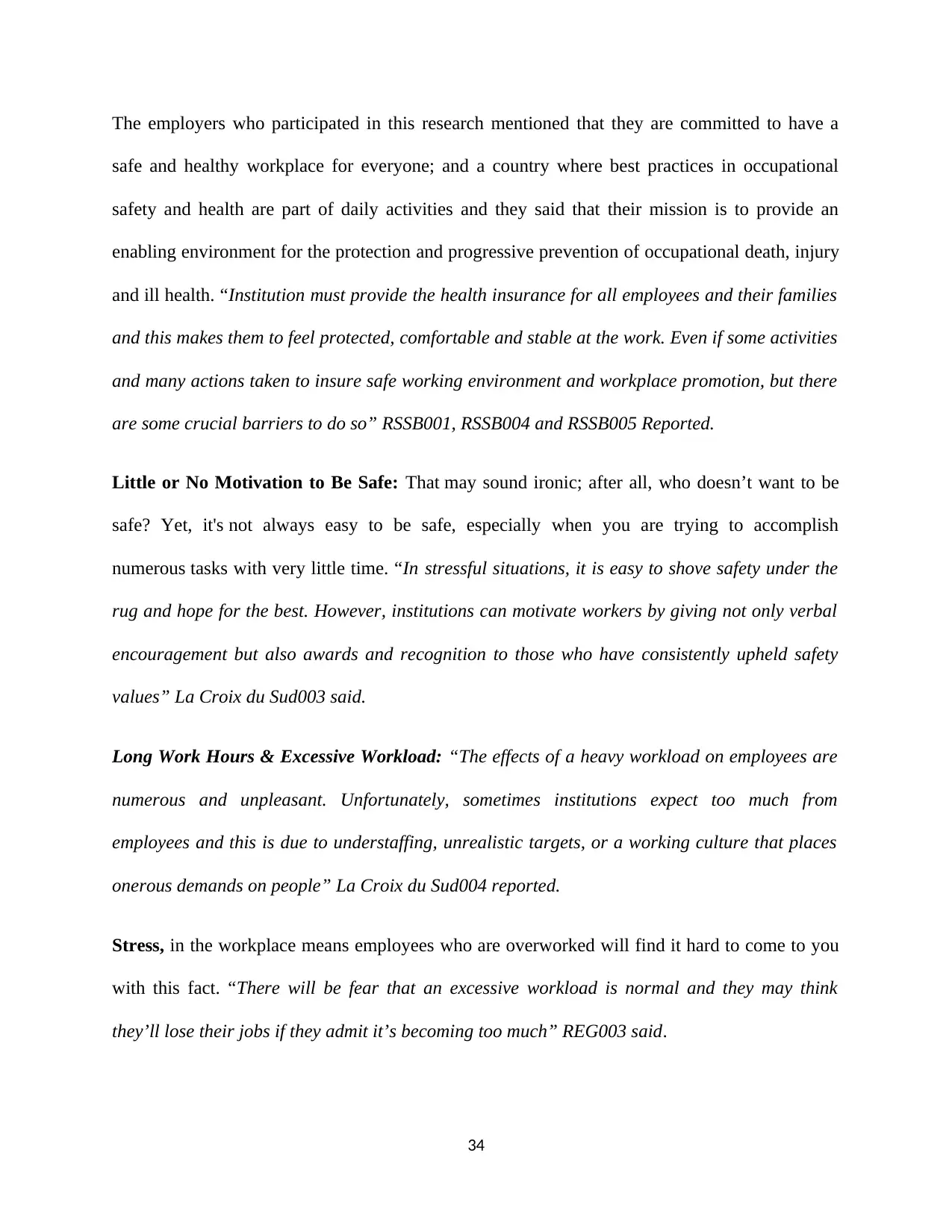
The employers who participated in this research mentioned that they are committed to have a
safe and healthy workplace for everyone; and a country where best practices in occupational
safety and health are part of daily activities and they said that their mission is to provide an
enabling environment for the protection and progressive prevention of occupational death, injury
and ill health. “Institution must provide the health insurance for all employees and their families
and this makes them to feel protected, comfortable and stable at the work. Even if some activities
and many actions taken to insure safe working environment and workplace promotion, but there
are some crucial barriers to do so” RSSB001, RSSB004 and RSSB005 Reported.
Little or No Motivation to Be Safe: That may sound ironic; after all, who doesn’t want to be
safe? Yet, it's not always easy to be safe, especially when you are trying to accomplish
numerous tasks with very little time. “In stressful situations, it is easy to shove safety under the
rug and hope for the best. However, institutions can motivate workers by giving not only verbal
encouragement but also awards and recognition to those who have consistently upheld safety
values” La Croix du Sud003 said.
Long Work Hours & Excessive Workload: “The effects of a heavy workload on employees are
numerous and unpleasant. Unfortunately, sometimes institutions expect too much from
employees and this is due to understaffing, unrealistic targets, or a working culture that places
onerous demands on people” La Croix du Sud004 reported.
Stress, in the workplace means employees who are overworked will find it hard to come to you
with this fact. “There will be fear that an excessive workload is normal and they may think
they’ll lose their jobs if they admit it’s becoming too much” REG003 said.
34
safe and healthy workplace for everyone; and a country where best practices in occupational
safety and health are part of daily activities and they said that their mission is to provide an
enabling environment for the protection and progressive prevention of occupational death, injury
and ill health. “Institution must provide the health insurance for all employees and their families
and this makes them to feel protected, comfortable and stable at the work. Even if some activities
and many actions taken to insure safe working environment and workplace promotion, but there
are some crucial barriers to do so” RSSB001, RSSB004 and RSSB005 Reported.
Little or No Motivation to Be Safe: That may sound ironic; after all, who doesn’t want to be
safe? Yet, it's not always easy to be safe, especially when you are trying to accomplish
numerous tasks with very little time. “In stressful situations, it is easy to shove safety under the
rug and hope for the best. However, institutions can motivate workers by giving not only verbal
encouragement but also awards and recognition to those who have consistently upheld safety
values” La Croix du Sud003 said.
Long Work Hours & Excessive Workload: “The effects of a heavy workload on employees are
numerous and unpleasant. Unfortunately, sometimes institutions expect too much from
employees and this is due to understaffing, unrealistic targets, or a working culture that places
onerous demands on people” La Croix du Sud004 reported.
Stress, in the workplace means employees who are overworked will find it hard to come to you
with this fact. “There will be fear that an excessive workload is normal and they may think
they’ll lose their jobs if they admit it’s becoming too much” REG003 said.
34
Secure Best Marks with AI Grader
Need help grading? Try our AI Grader for instant feedback on your assignments.
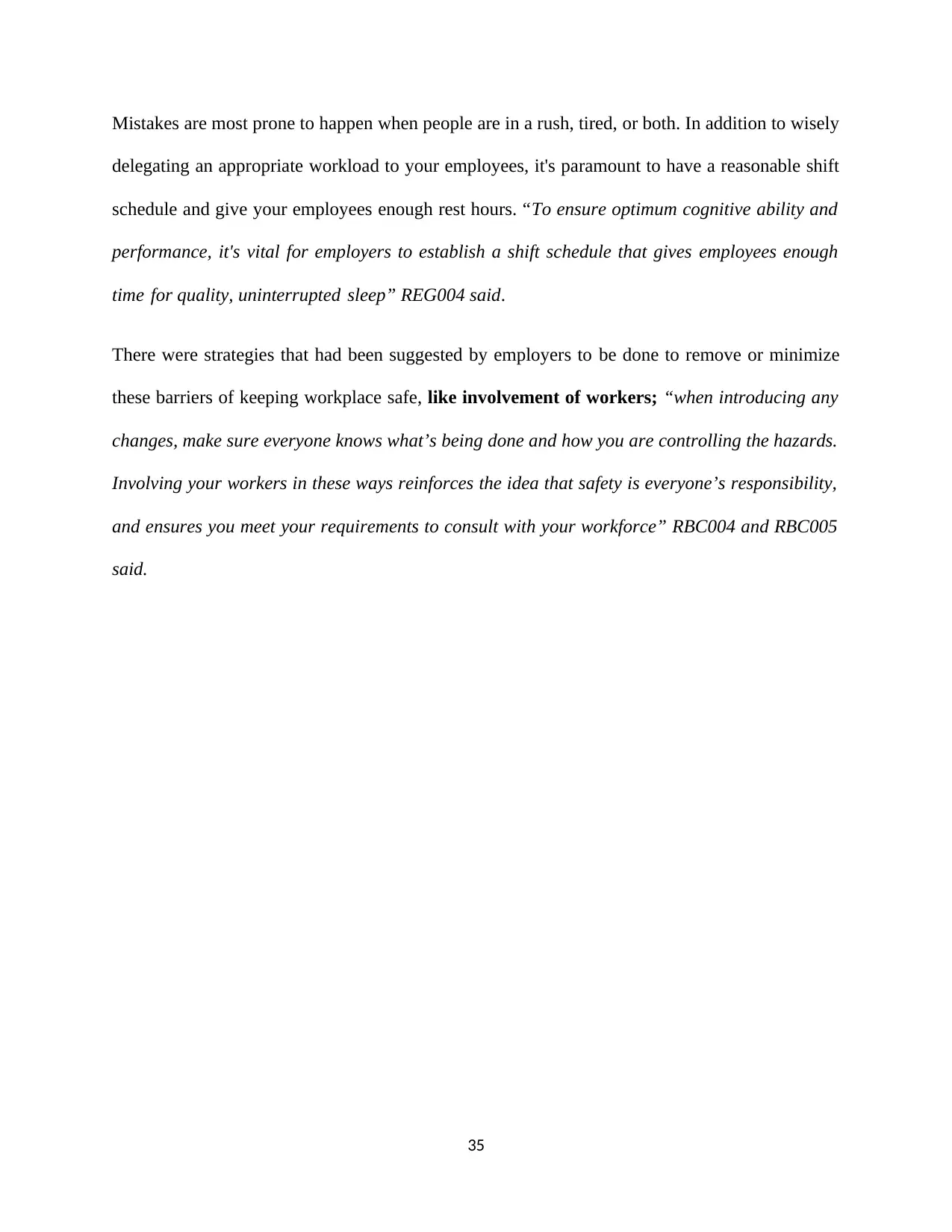
Mistakes are most prone to happen when people are in a rush, tired, or both. In addition to wisely
delegating an appropriate workload to your employees, it's paramount to have a reasonable shift
schedule and give your employees enough rest hours. “To ensure optimum cognitive ability and
performance, it's vital for employers to establish a shift schedule that gives employees enough
time for quality, uninterrupted sleep” REG004 said.
There were strategies that had been suggested by employers to be done to remove or minimize
these barriers of keeping workplace safe, like involvement of workers; “when introducing any
changes, make sure everyone knows what’s being done and how you are controlling the hazards.
Involving your workers in these ways reinforces the idea that safety is everyone’s responsibility,
and ensures you meet your requirements to consult with your workforce” RBC004 and RBC005
said.
35
delegating an appropriate workload to your employees, it's paramount to have a reasonable shift
schedule and give your employees enough rest hours. “To ensure optimum cognitive ability and
performance, it's vital for employers to establish a shift schedule that gives employees enough
time for quality, uninterrupted sleep” REG004 said.
There were strategies that had been suggested by employers to be done to remove or minimize
these barriers of keeping workplace safe, like involvement of workers; “when introducing any
changes, make sure everyone knows what’s being done and how you are controlling the hazards.
Involving your workers in these ways reinforces the idea that safety is everyone’s responsibility,
and ensures you meet your requirements to consult with your workforce” RBC004 and RBC005
said.
35
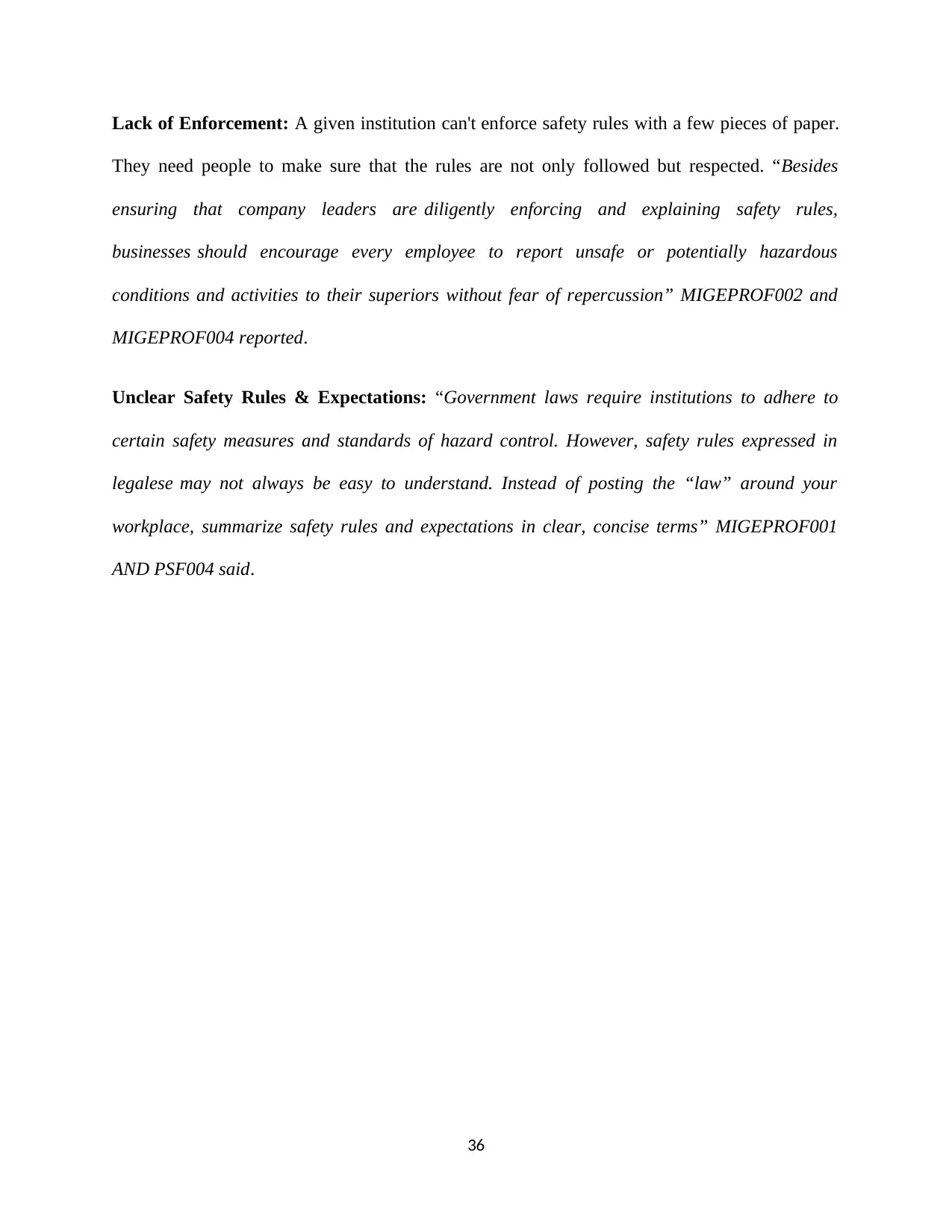
Lack of Enforcement: A given institution can't enforce safety rules with a few pieces of paper.
They need people to make sure that the rules are not only followed but respected. “Besides
ensuring that company leaders are diligently enforcing and explaining safety rules,
businesses should encourage every employee to report unsafe or potentially hazardous
conditions and activities to their superiors without fear of repercussion” MIGEPROF002 and
MIGEPROF004 reported.
Unclear Safety Rules & Expectations: “Government laws require institutions to adhere to
certain safety measures and standards of hazard control. However, safety rules expressed in
legalese may not always be easy to understand. Instead of posting the “law” around your
workplace, summarize safety rules and expectations in clear, concise terms” MIGEPROF001
AND PSF004 said.
36
They need people to make sure that the rules are not only followed but respected. “Besides
ensuring that company leaders are diligently enforcing and explaining safety rules,
businesses should encourage every employee to report unsafe or potentially hazardous
conditions and activities to their superiors without fear of repercussion” MIGEPROF002 and
MIGEPROF004 reported.
Unclear Safety Rules & Expectations: “Government laws require institutions to adhere to
certain safety measures and standards of hazard control. However, safety rules expressed in
legalese may not always be easy to understand. Instead of posting the “law” around your
workplace, summarize safety rules and expectations in clear, concise terms” MIGEPROF001
AND PSF004 said.
36
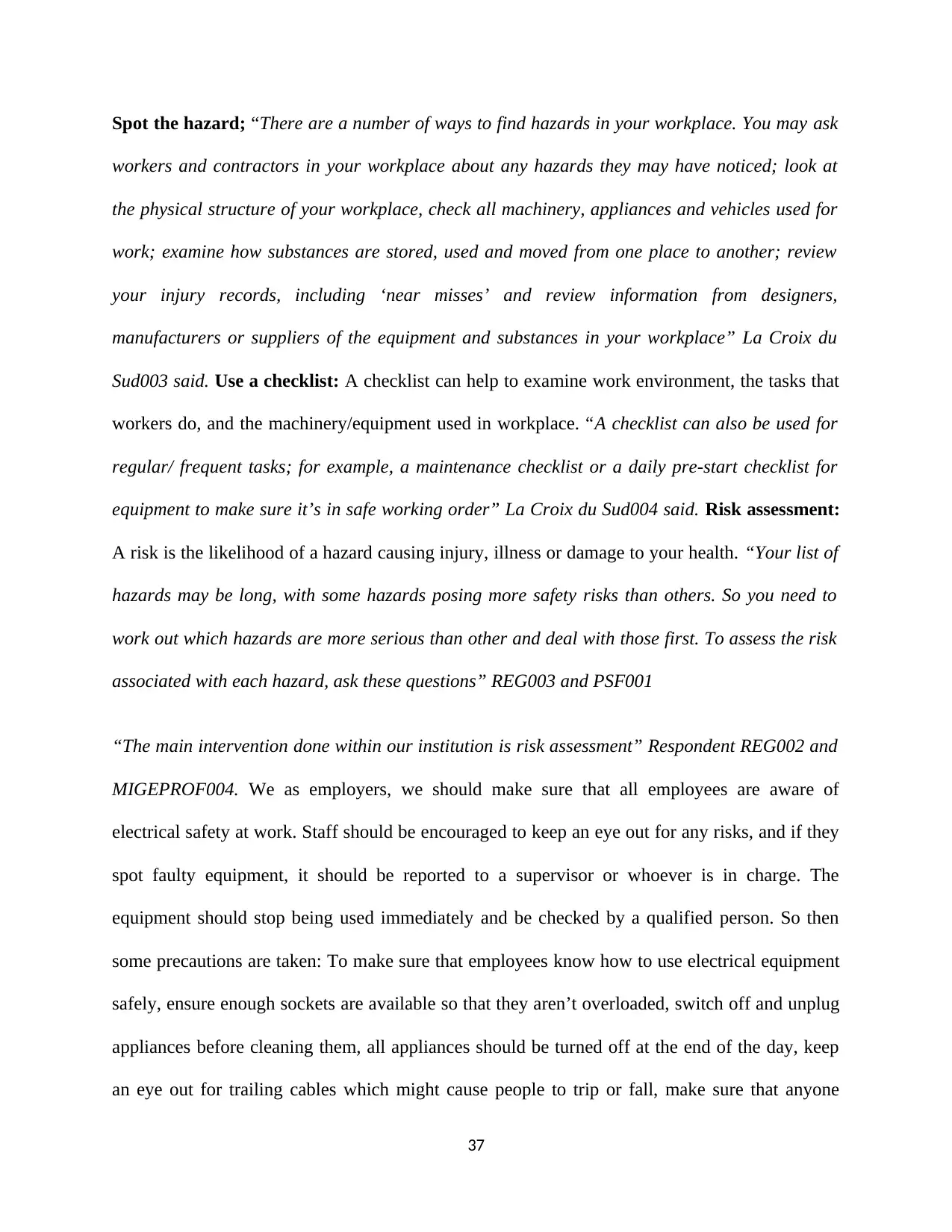
Spot the hazard; “There are a number of ways to find hazards in your workplace. You may ask
workers and contractors in your workplace about any hazards they may have noticed; look at
the physical structure of your workplace, check all machinery, appliances and vehicles used for
work; examine how substances are stored, used and moved from one place to another; review
your injury records, including ‘near misses’ and review information from designers,
manufacturers or suppliers of the equipment and substances in your workplace” La Croix du
Sud003 said. Use a checklist: A checklist can help to examine work environment, the tasks that
workers do, and the machinery/equipment used in workplace. “A checklist can also be used for
regular/ frequent tasks; for example, a maintenance checklist or a daily pre-start checklist for
equipment to make sure it’s in safe working order” La Croix du Sud004 said. Risk assessment:
A risk is the likelihood of a hazard causing injury, illness or damage to your health. “Your list of
hazards may be long, with some hazards posing more safety risks than others. So you need to
work out which hazards are more serious than other and deal with those first. To assess the risk
associated with each hazard, ask these questions” REG003 and PSF001
“The main intervention done within our institution is risk assessment” Respondent REG002 and
MIGEPROF004. We as employers, we should make sure that all employees are aware of
electrical safety at work. Staff should be encouraged to keep an eye out for any risks, and if they
spot faulty equipment, it should be reported to a supervisor or whoever is in charge. The
equipment should stop being used immediately and be checked by a qualified person. So then
some precautions are taken: To make sure that employees know how to use electrical equipment
safely, ensure enough sockets are available so that they aren’t overloaded, switch off and unplug
appliances before cleaning them, all appliances should be turned off at the end of the day, keep
an eye out for trailing cables which might cause people to trip or fall, make sure that anyone
37
workers and contractors in your workplace about any hazards they may have noticed; look at
the physical structure of your workplace, check all machinery, appliances and vehicles used for
work; examine how substances are stored, used and moved from one place to another; review
your injury records, including ‘near misses’ and review information from designers,
manufacturers or suppliers of the equipment and substances in your workplace” La Croix du
Sud003 said. Use a checklist: A checklist can help to examine work environment, the tasks that
workers do, and the machinery/equipment used in workplace. “A checklist can also be used for
regular/ frequent tasks; for example, a maintenance checklist or a daily pre-start checklist for
equipment to make sure it’s in safe working order” La Croix du Sud004 said. Risk assessment:
A risk is the likelihood of a hazard causing injury, illness or damage to your health. “Your list of
hazards may be long, with some hazards posing more safety risks than others. So you need to
work out which hazards are more serious than other and deal with those first. To assess the risk
associated with each hazard, ask these questions” REG003 and PSF001
“The main intervention done within our institution is risk assessment” Respondent REG002 and
MIGEPROF004. We as employers, we should make sure that all employees are aware of
electrical safety at work. Staff should be encouraged to keep an eye out for any risks, and if they
spot faulty equipment, it should be reported to a supervisor or whoever is in charge. The
equipment should stop being used immediately and be checked by a qualified person. So then
some precautions are taken: To make sure that employees know how to use electrical equipment
safely, ensure enough sockets are available so that they aren’t overloaded, switch off and unplug
appliances before cleaning them, all appliances should be turned off at the end of the day, keep
an eye out for trailing cables which might cause people to trip or fall, make sure that anyone
37
Paraphrase This Document
Need a fresh take? Get an instant paraphrase of this document with our AI Paraphraser
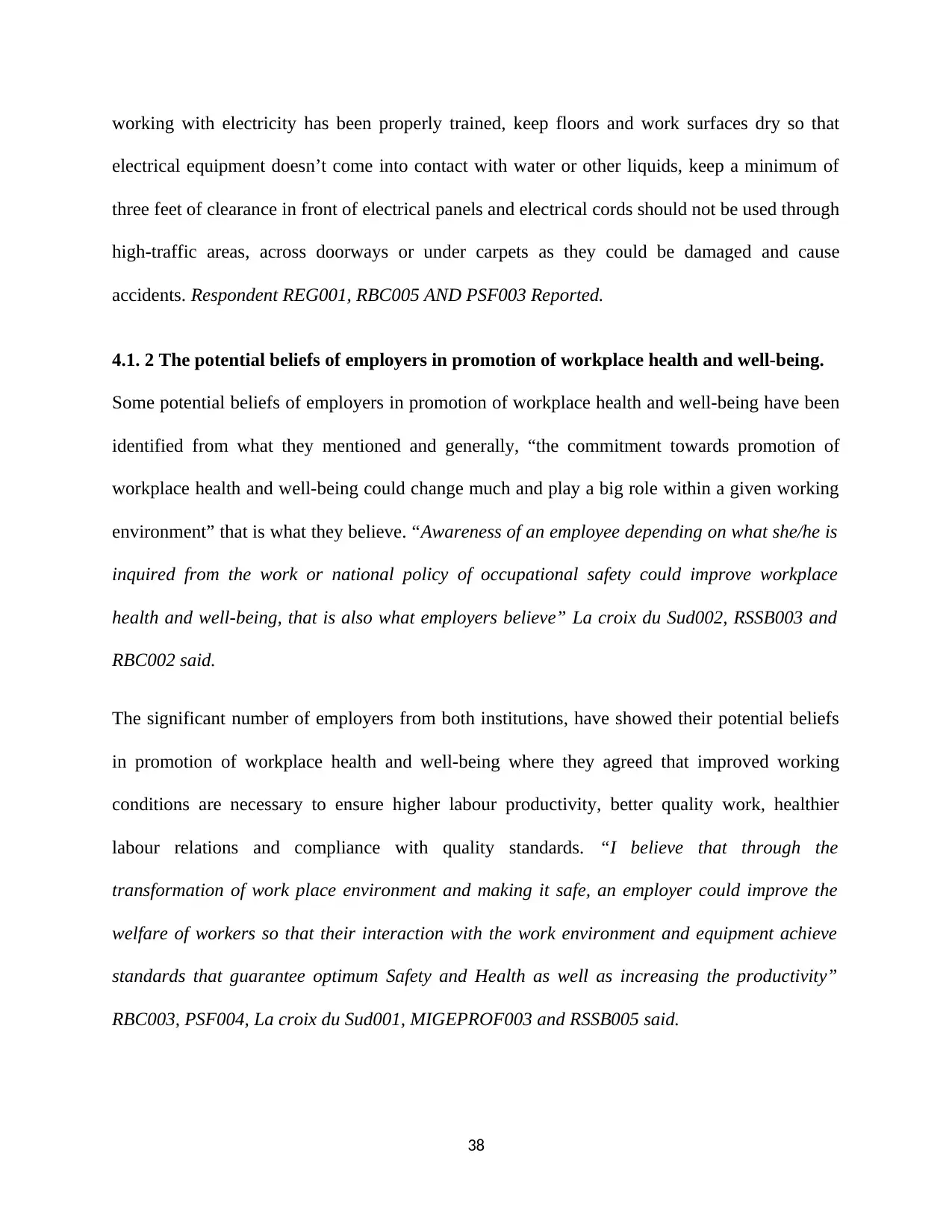
working with electricity has been properly trained, keep floors and work surfaces dry so that
electrical equipment doesn’t come into contact with water or other liquids, keep a minimum of
three feet of clearance in front of electrical panels and electrical cords should not be used through
high-traffic areas, across doorways or under carpets as they could be damaged and cause
accidents. Respondent REG001, RBC005 AND PSF003 Reported.
4.1. 2 The potential beliefs of employers in promotion of workplace health and well-being.
Some potential beliefs of employers in promotion of workplace health and well-being have been
identified from what they mentioned and generally, “the commitment towards promotion of
workplace health and well-being could change much and play a big role within a given working
environment” that is what they believe. “Awareness of an employee depending on what she/he is
inquired from the work or national policy of occupational safety could improve workplace
health and well-being, that is also what employers believe” La croix du Sud002, RSSB003 and
RBC002 said.
The significant number of employers from both institutions, have showed their potential beliefs
in promotion of workplace health and well-being where they agreed that improved working
conditions are necessary to ensure higher labour productivity, better quality work, healthier
labour relations and compliance with quality standards. “I believe that through the
transformation of work place environment and making it safe, an employer could improve the
welfare of workers so that their interaction with the work environment and equipment achieve
standards that guarantee optimum Safety and Health as well as increasing the productivity”
RBC003, PSF004, La croix du Sud001, MIGEPROF003 and RSSB005 said.
38
electrical equipment doesn’t come into contact with water or other liquids, keep a minimum of
three feet of clearance in front of electrical panels and electrical cords should not be used through
high-traffic areas, across doorways or under carpets as they could be damaged and cause
accidents. Respondent REG001, RBC005 AND PSF003 Reported.
4.1. 2 The potential beliefs of employers in promotion of workplace health and well-being.
Some potential beliefs of employers in promotion of workplace health and well-being have been
identified from what they mentioned and generally, “the commitment towards promotion of
workplace health and well-being could change much and play a big role within a given working
environment” that is what they believe. “Awareness of an employee depending on what she/he is
inquired from the work or national policy of occupational safety could improve workplace
health and well-being, that is also what employers believe” La croix du Sud002, RSSB003 and
RBC002 said.
The significant number of employers from both institutions, have showed their potential beliefs
in promotion of workplace health and well-being where they agreed that improved working
conditions are necessary to ensure higher labour productivity, better quality work, healthier
labour relations and compliance with quality standards. “I believe that through the
transformation of work place environment and making it safe, an employer could improve the
welfare of workers so that their interaction with the work environment and equipment achieve
standards that guarantee optimum Safety and Health as well as increasing the productivity”
RBC003, PSF004, La croix du Sud001, MIGEPROF003 and RSSB005 said.
38
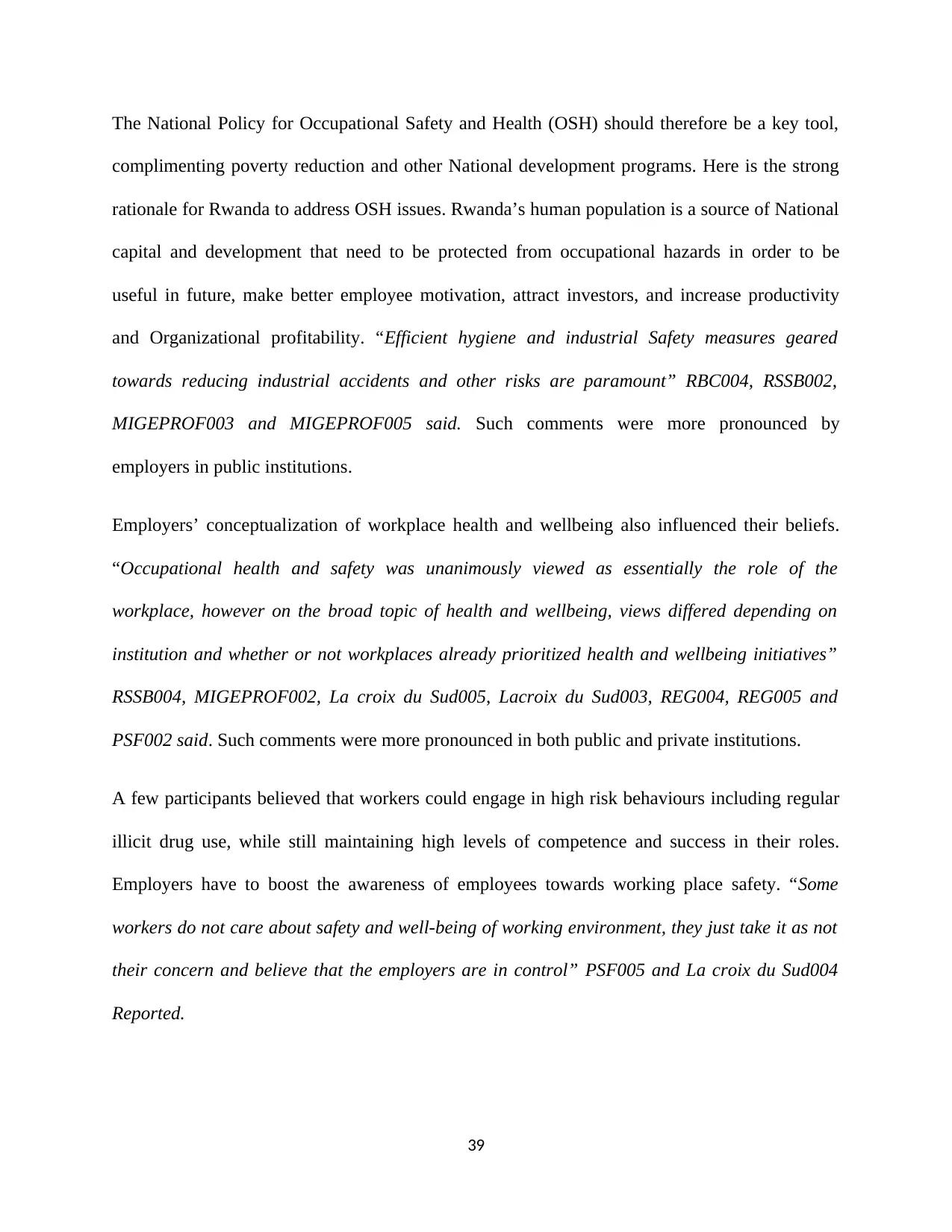
The National Policy for Occupational Safety and Health (OSH) should therefore be a key tool,
complimenting poverty reduction and other National development programs. Here is the strong
rationale for Rwanda to address OSH issues. Rwanda’s human population is a source of National
capital and development that need to be protected from occupational hazards in order to be
useful in future, make better employee motivation, attract investors, and increase productivity
and Organizational profitability. “Efficient hygiene and industrial Safety measures geared
towards reducing industrial accidents and other risks are paramount” RBC004, RSSB002,
MIGEPROF003 and MIGEPROF005 said. Such comments were more pronounced by
employers in public institutions.
Employers’ conceptualization of workplace health and wellbeing also influenced their beliefs.
“Occupational health and safety was unanimously viewed as essentially the role of the
workplace, however on the broad topic of health and wellbeing, views differed depending on
institution and whether or not workplaces already prioritized health and wellbeing initiatives”
RSSB004, MIGEPROF002, La croix du Sud005, Lacroix du Sud003, REG004, REG005 and
PSF002 said. Such comments were more pronounced in both public and private institutions.
A few participants believed that workers could engage in high risk behaviours including regular
illicit drug use, while still maintaining high levels of competence and success in their roles.
Employers have to boost the awareness of employees towards working place safety. “Some
workers do not care about safety and well-being of working environment, they just take it as not
their concern and believe that the employers are in control” PSF005 and La croix du Sud004
Reported.
39
complimenting poverty reduction and other National development programs. Here is the strong
rationale for Rwanda to address OSH issues. Rwanda’s human population is a source of National
capital and development that need to be protected from occupational hazards in order to be
useful in future, make better employee motivation, attract investors, and increase productivity
and Organizational profitability. “Efficient hygiene and industrial Safety measures geared
towards reducing industrial accidents and other risks are paramount” RBC004, RSSB002,
MIGEPROF003 and MIGEPROF005 said. Such comments were more pronounced by
employers in public institutions.
Employers’ conceptualization of workplace health and wellbeing also influenced their beliefs.
“Occupational health and safety was unanimously viewed as essentially the role of the
workplace, however on the broad topic of health and wellbeing, views differed depending on
institution and whether or not workplaces already prioritized health and wellbeing initiatives”
RSSB004, MIGEPROF002, La croix du Sud005, Lacroix du Sud003, REG004, REG005 and
PSF002 said. Such comments were more pronounced in both public and private institutions.
A few participants believed that workers could engage in high risk behaviours including regular
illicit drug use, while still maintaining high levels of competence and success in their roles.
Employers have to boost the awareness of employees towards working place safety. “Some
workers do not care about safety and well-being of working environment, they just take it as not
their concern and believe that the employers are in control” PSF005 and La croix du Sud004
Reported.
39
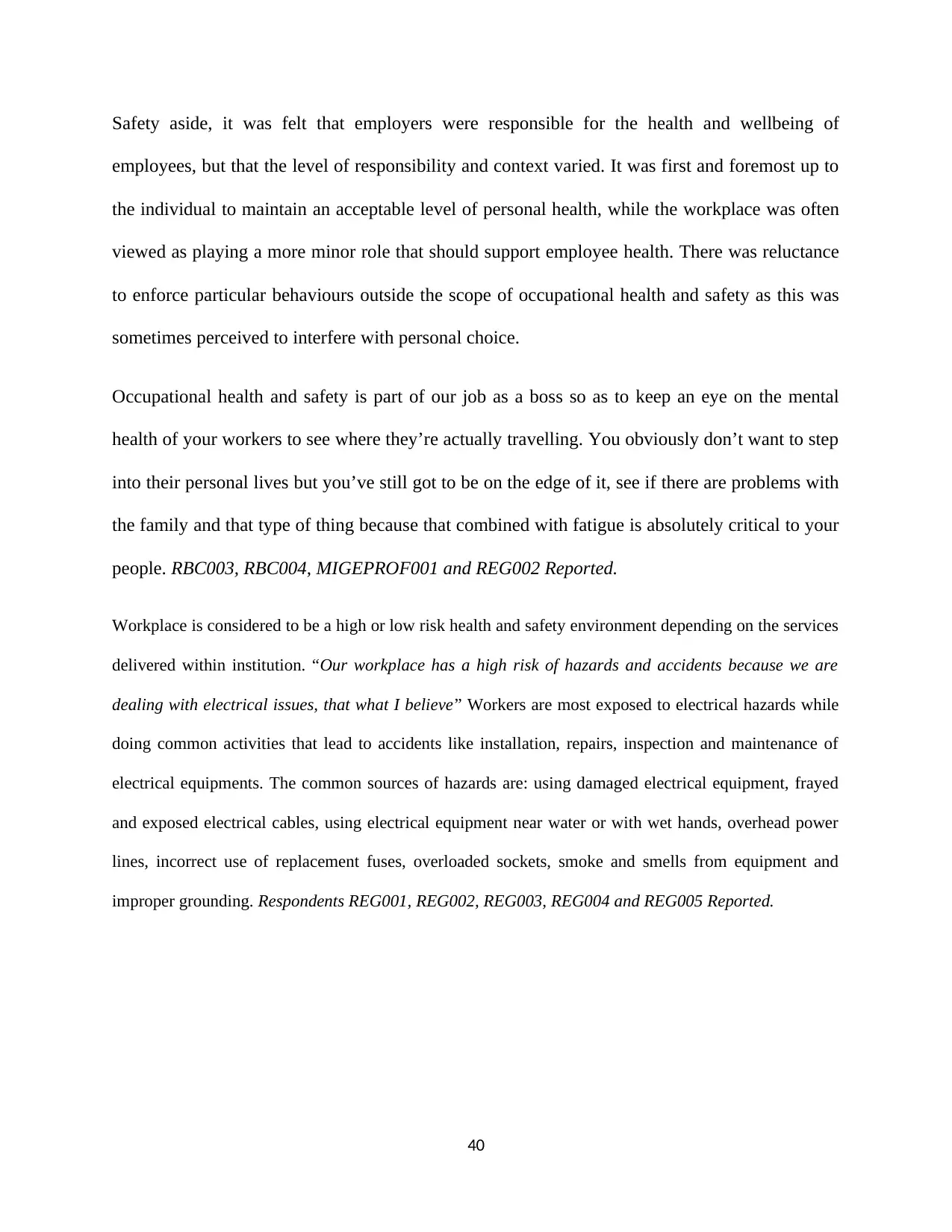
Safety aside, it was felt that employers were responsible for the health and wellbeing of
employees, but that the level of responsibility and context varied. It was first and foremost up to
the individual to maintain an acceptable level of personal health, while the workplace was often
viewed as playing a more minor role that should support employee health. There was reluctance
to enforce particular behaviours outside the scope of occupational health and safety as this was
sometimes perceived to interfere with personal choice.
Occupational health and safety is part of our job as a boss so as to keep an eye on the mental
health of your workers to see where they’re actually travelling. You obviously don’t want to step
into their personal lives but you’ve still got to be on the edge of it, see if there are problems with
the family and that type of thing because that combined with fatigue is absolutely critical to your
people. RBC003, RBC004, MIGEPROF001 and REG002 Reported.
Workplace is considered to be a high or low risk health and safety environment depending on the services
delivered within institution. “Our workplace has a high risk of hazards and accidents because we are
dealing with electrical issues, that what I believe” Workers are most exposed to electrical hazards while
doing common activities that lead to accidents like installation, repairs, inspection and maintenance of
electrical equipments. The common sources of hazards are: using damaged electrical equipment, frayed
and exposed electrical cables, using electrical equipment near water or with wet hands, overhead power
lines, incorrect use of replacement fuses, overloaded sockets, smoke and smells from equipment and
improper grounding. Respondents REG001, REG002, REG003, REG004 and REG005 Reported.
40
employees, but that the level of responsibility and context varied. It was first and foremost up to
the individual to maintain an acceptable level of personal health, while the workplace was often
viewed as playing a more minor role that should support employee health. There was reluctance
to enforce particular behaviours outside the scope of occupational health and safety as this was
sometimes perceived to interfere with personal choice.
Occupational health and safety is part of our job as a boss so as to keep an eye on the mental
health of your workers to see where they’re actually travelling. You obviously don’t want to step
into their personal lives but you’ve still got to be on the edge of it, see if there are problems with
the family and that type of thing because that combined with fatigue is absolutely critical to your
people. RBC003, RBC004, MIGEPROF001 and REG002 Reported.
Workplace is considered to be a high or low risk health and safety environment depending on the services
delivered within institution. “Our workplace has a high risk of hazards and accidents because we are
dealing with electrical issues, that what I believe” Workers are most exposed to electrical hazards while
doing common activities that lead to accidents like installation, repairs, inspection and maintenance of
electrical equipments. The common sources of hazards are: using damaged electrical equipment, frayed
and exposed electrical cables, using electrical equipment near water or with wet hands, overhead power
lines, incorrect use of replacement fuses, overloaded sockets, smoke and smells from equipment and
improper grounding. Respondents REG001, REG002, REG003, REG004 and REG005 Reported.
40
Secure Best Marks with AI Grader
Need help grading? Try our AI Grader for instant feedback on your assignments.
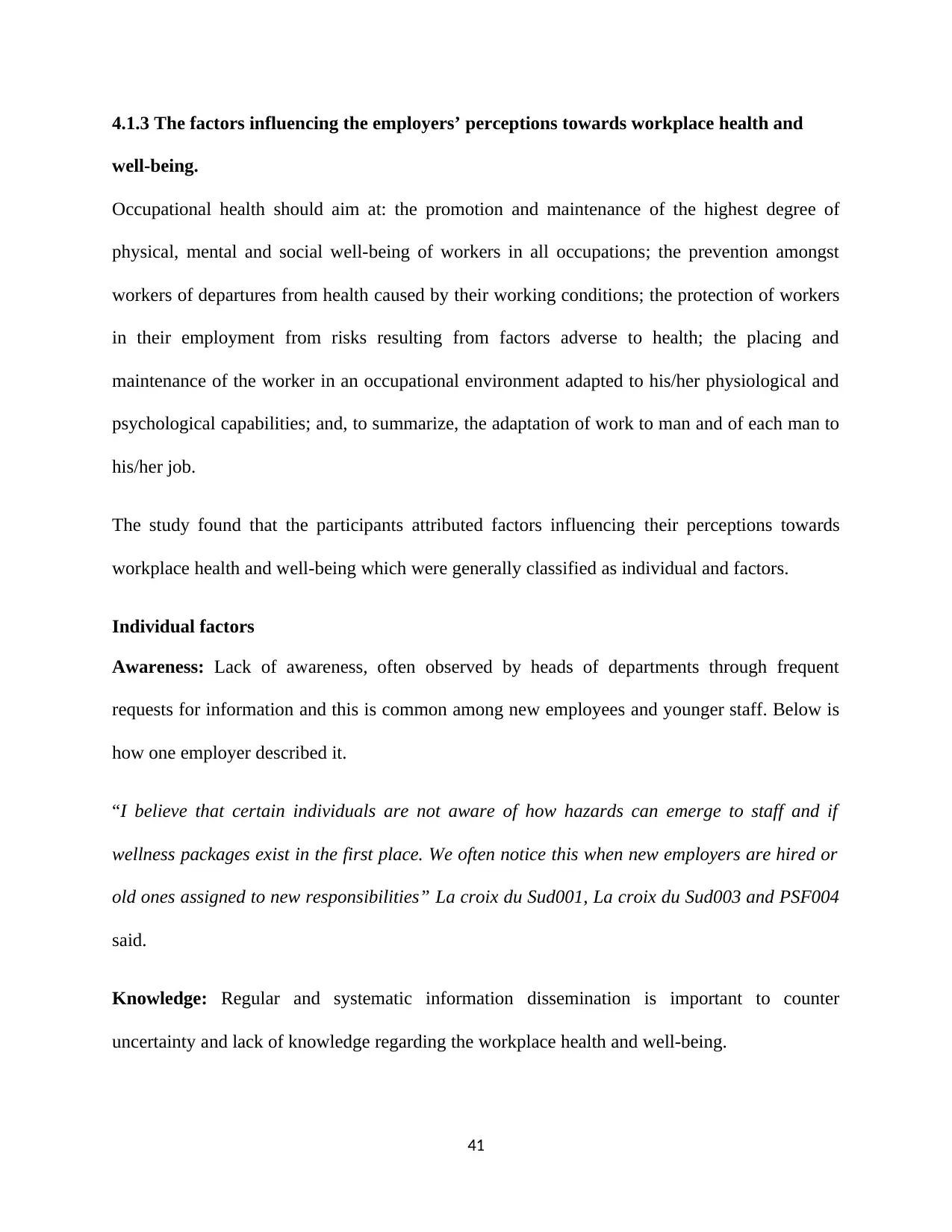
4.1.3 The factors influencing the employers’ perceptions towards workplace health and
well-being.
Occupational health should aim at: the promotion and maintenance of the highest degree of
physical, mental and social well-being of workers in all occupations; the prevention amongst
workers of departures from health caused by their working conditions; the protection of workers
in their employment from risks resulting from factors adverse to health; the placing and
maintenance of the worker in an occupational environment adapted to his/her physiological and
psychological capabilities; and, to summarize, the adaptation of work to man and of each man to
his/her job.
The study found that the participants attributed factors influencing their perceptions towards
workplace health and well-being which were generally classified as individual and factors.
Individual factors
Awareness: Lack of awareness, often observed by heads of departments through frequent
requests for information and this is common among new employees and younger staff. Below is
how one employer described it.
“I believe that certain individuals are not aware of how hazards can emerge to staff and if
wellness packages exist in the first place. We often notice this when new employers are hired or
old ones assigned to new responsibilities” La croix du Sud001, La croix du Sud003 and PSF004
said.
Knowledge: Regular and systematic information dissemination is important to counter
uncertainty and lack of knowledge regarding the workplace health and well-being.
41
well-being.
Occupational health should aim at: the promotion and maintenance of the highest degree of
physical, mental and social well-being of workers in all occupations; the prevention amongst
workers of departures from health caused by their working conditions; the protection of workers
in their employment from risks resulting from factors adverse to health; the placing and
maintenance of the worker in an occupational environment adapted to his/her physiological and
psychological capabilities; and, to summarize, the adaptation of work to man and of each man to
his/her job.
The study found that the participants attributed factors influencing their perceptions towards
workplace health and well-being which were generally classified as individual and factors.
Individual factors
Awareness: Lack of awareness, often observed by heads of departments through frequent
requests for information and this is common among new employees and younger staff. Below is
how one employer described it.
“I believe that certain individuals are not aware of how hazards can emerge to staff and if
wellness packages exist in the first place. We often notice this when new employers are hired or
old ones assigned to new responsibilities” La croix du Sud001, La croix du Sud003 and PSF004
said.
Knowledge: Regular and systematic information dissemination is important to counter
uncertainty and lack of knowledge regarding the workplace health and well-being.
41
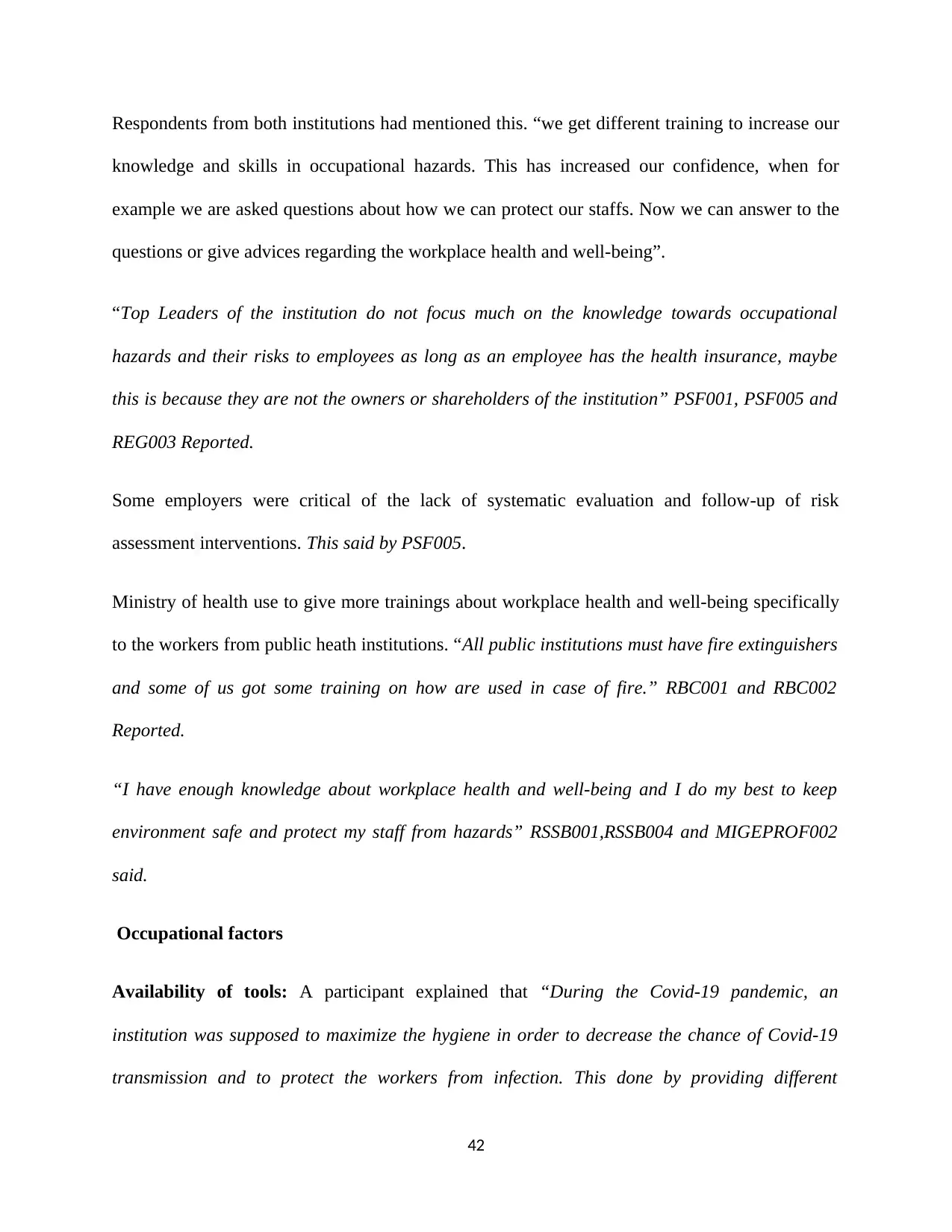
Respondents from both institutions had mentioned this. “we get different training to increase our
knowledge and skills in occupational hazards. This has increased our confidence, when for
example we are asked questions about how we can protect our staffs. Now we can answer to the
questions or give advices regarding the workplace health and well-being”.
“Top Leaders of the institution do not focus much on the knowledge towards occupational
hazards and their risks to employees as long as an employee has the health insurance, maybe
this is because they are not the owners or shareholders of the institution” PSF001, PSF005 and
REG003 Reported.
Some employers were critical of the lack of systematic evaluation and follow-up of risk
assessment interventions. This said by PSF005.
Ministry of health use to give more trainings about workplace health and well-being specifically
to the workers from public heath institutions. “All public institutions must have fire extinguishers
and some of us got some training on how are used in case of fire.” RBC001 and RBC002
Reported.
“I have enough knowledge about workplace health and well-being and I do my best to keep
environment safe and protect my staff from hazards” RSSB001,RSSB004 and MIGEPROF002
said.
Occupational factors
Availability of tools: A participant explained that “During the Covid-19 pandemic, an
institution was supposed to maximize the hygiene in order to decrease the chance of Covid-19
transmission and to protect the workers from infection. This done by providing different
42
knowledge and skills in occupational hazards. This has increased our confidence, when for
example we are asked questions about how we can protect our staffs. Now we can answer to the
questions or give advices regarding the workplace health and well-being”.
“Top Leaders of the institution do not focus much on the knowledge towards occupational
hazards and their risks to employees as long as an employee has the health insurance, maybe
this is because they are not the owners or shareholders of the institution” PSF001, PSF005 and
REG003 Reported.
Some employers were critical of the lack of systematic evaluation and follow-up of risk
assessment interventions. This said by PSF005.
Ministry of health use to give more trainings about workplace health and well-being specifically
to the workers from public heath institutions. “All public institutions must have fire extinguishers
and some of us got some training on how are used in case of fire.” RBC001 and RBC002
Reported.
“I have enough knowledge about workplace health and well-being and I do my best to keep
environment safe and protect my staff from hazards” RSSB001,RSSB004 and MIGEPROF002
said.
Occupational factors
Availability of tools: A participant explained that “During the Covid-19 pandemic, an
institution was supposed to maximize the hygiene in order to decrease the chance of Covid-19
transmission and to protect the workers from infection. This done by providing different
42

materials like face masks, gloves, cleaning utensils, increased handwashing stations with clean
water and soap, hand sanitizers at the entrances and in the offices and so on” RBC001,
RBC002, RBC003, RBC005 and La croix du Sud004 Reported.
Rules and regulations: “I as the head of department, I have to make sure that the workers who
are allocated to different places to the fieldwork, have the full package including first aid
toolbox and within the period of Covid-19 ere was an addition of PPEs including face masks,
gloves, and hand sanitizer. This was the one of the rule of the institution to be followed by the
staffs but us leaders, we should make a close follow-up” RBC001, RBC002, RBC004, REG001,
REG002, and REG005 Reported.
Financial issues: Financial performance seems to be associated with employers’ perceptions
towards workplace health and well-being, as was demonstrated in this study. Better financial
performance and better employers’ perceptions towards workplace health and well-being may
reinforce one another in a positive and cyclical spiral, which makes the case that it is important
to achieve good workplace health and well-being practices also from the point of view of
financial performance. “Only a few respondents in this study stated that their institutions had a
specific budget item for costs concerning safe working environment” PSF002 and La croix du
Sud005 Reported.
The main limitation in this study was the exclusion of employees as they were the ones who
benefit more by working in healthy and safe working environment. The employees would be
involved in this study to whitening whether within an institution there were interventions of
employers in promotion of workplace health and well-being, and even in identifying potential hazards
43
water and soap, hand sanitizers at the entrances and in the offices and so on” RBC001,
RBC002, RBC003, RBC005 and La croix du Sud004 Reported.
Rules and regulations: “I as the head of department, I have to make sure that the workers who
are allocated to different places to the fieldwork, have the full package including first aid
toolbox and within the period of Covid-19 ere was an addition of PPEs including face masks,
gloves, and hand sanitizer. This was the one of the rule of the institution to be followed by the
staffs but us leaders, we should make a close follow-up” RBC001, RBC002, RBC004, REG001,
REG002, and REG005 Reported.
Financial issues: Financial performance seems to be associated with employers’ perceptions
towards workplace health and well-being, as was demonstrated in this study. Better financial
performance and better employers’ perceptions towards workplace health and well-being may
reinforce one another in a positive and cyclical spiral, which makes the case that it is important
to achieve good workplace health and well-being practices also from the point of view of
financial performance. “Only a few respondents in this study stated that their institutions had a
specific budget item for costs concerning safe working environment” PSF002 and La croix du
Sud005 Reported.
The main limitation in this study was the exclusion of employees as they were the ones who
benefit more by working in healthy and safe working environment. The employees would be
involved in this study to whitening whether within an institution there were interventions of
employers in promotion of workplace health and well-being, and even in identifying potential hazards
43
Paraphrase This Document
Need a fresh take? Get an instant paraphrase of this document with our AI Paraphraser
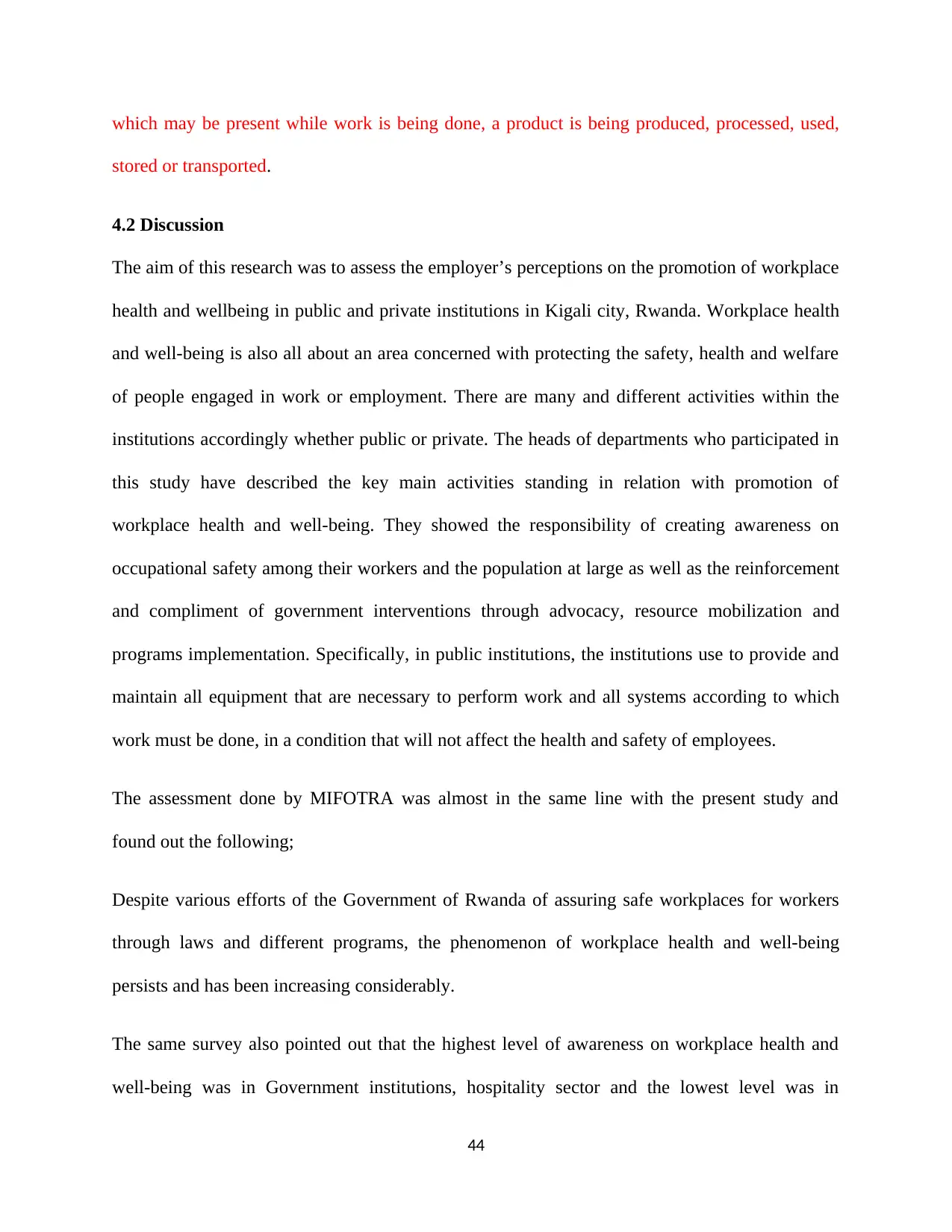
which may be present while work is being done, a product is being produced, processed, used,
stored or transported.
4.2 Discussion
The aim of this research was to assess the employer’s perceptions on the promotion of workplace
health and wellbeing in public and private institutions in Kigali city, Rwanda. Workplace health
and well-being is also all about an area concerned with protecting the safety, health and welfare
of people engaged in work or employment. There are many and different activities within the
institutions accordingly whether public or private. The heads of departments who participated in
this study have described the key main activities standing in relation with promotion of
workplace health and well-being. They showed the responsibility of creating awareness on
occupational safety among their workers and the population at large as well as the reinforcement
and compliment of government interventions through advocacy, resource mobilization and
programs implementation. Specifically, in public institutions, the institutions use to provide and
maintain all equipment that are necessary to perform work and all systems according to which
work must be done, in a condition that will not affect the health and safety of employees.
The assessment done by MIFOTRA was almost in the same line with the present study and
found out the following;
Despite various efforts of the Government of Rwanda of assuring safe workplaces for workers
through laws and different programs, the phenomenon of workplace health and well-being
persists and has been increasing considerably.
The same survey also pointed out that the highest level of awareness on workplace health and
well-being was in Government institutions, hospitality sector and the lowest level was in
44
stored or transported.
4.2 Discussion
The aim of this research was to assess the employer’s perceptions on the promotion of workplace
health and wellbeing in public and private institutions in Kigali city, Rwanda. Workplace health
and well-being is also all about an area concerned with protecting the safety, health and welfare
of people engaged in work or employment. There are many and different activities within the
institutions accordingly whether public or private. The heads of departments who participated in
this study have described the key main activities standing in relation with promotion of
workplace health and well-being. They showed the responsibility of creating awareness on
occupational safety among their workers and the population at large as well as the reinforcement
and compliment of government interventions through advocacy, resource mobilization and
programs implementation. Specifically, in public institutions, the institutions use to provide and
maintain all equipment that are necessary to perform work and all systems according to which
work must be done, in a condition that will not affect the health and safety of employees.
The assessment done by MIFOTRA was almost in the same line with the present study and
found out the following;
Despite various efforts of the Government of Rwanda of assuring safe workplaces for workers
through laws and different programs, the phenomenon of workplace health and well-being
persists and has been increasing considerably.
The same survey also pointed out that the highest level of awareness on workplace health and
well-being was in Government institutions, hospitality sector and the lowest level was in
44
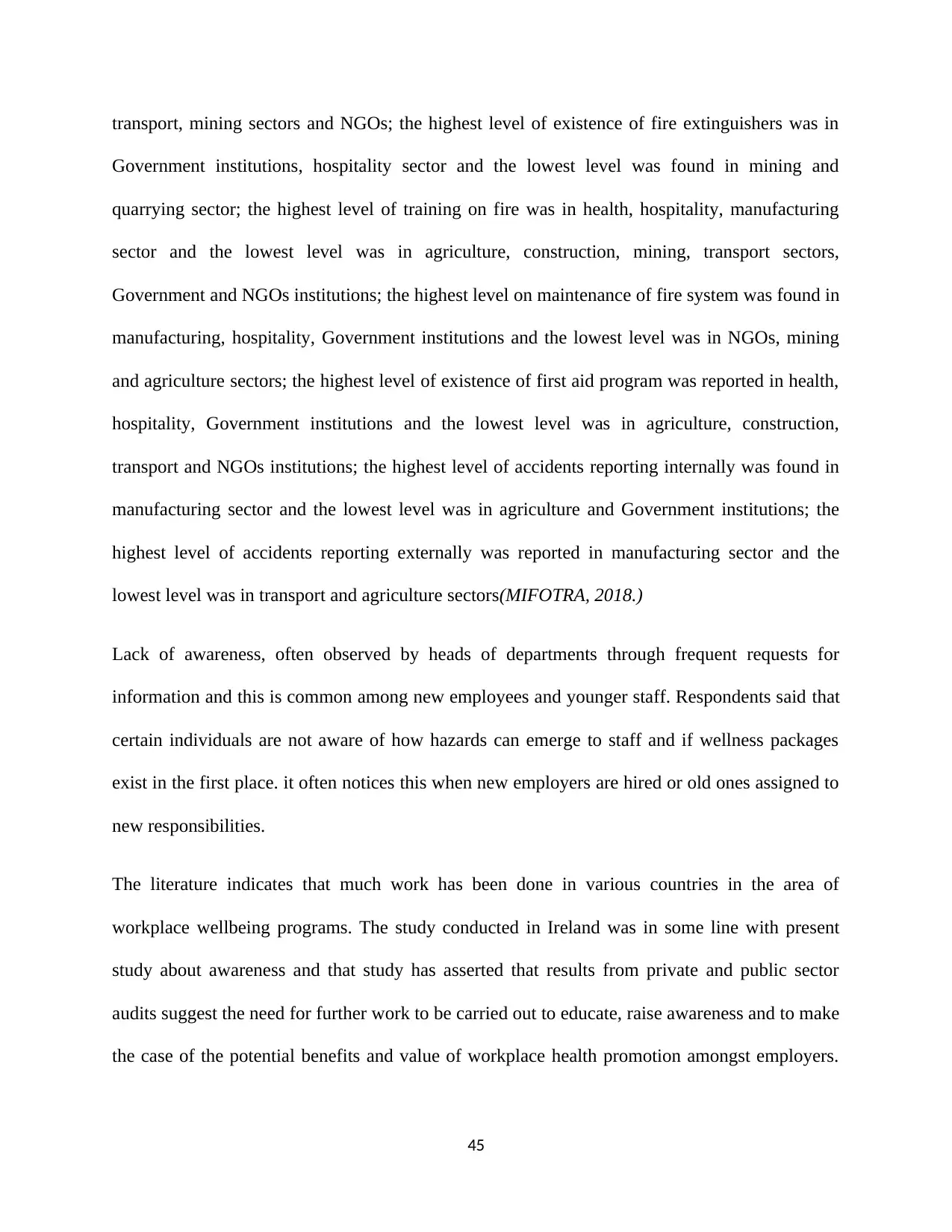
transport, mining sectors and NGOs; the highest level of existence of fire extinguishers was in
Government institutions, hospitality sector and the lowest level was found in mining and
quarrying sector; the highest level of training on fire was in health, hospitality, manufacturing
sector and the lowest level was in agriculture, construction, mining, transport sectors,
Government and NGOs institutions; the highest level on maintenance of fire system was found in
manufacturing, hospitality, Government institutions and the lowest level was in NGOs, mining
and agriculture sectors; the highest level of existence of first aid program was reported in health,
hospitality, Government institutions and the lowest level was in agriculture, construction,
transport and NGOs institutions; the highest level of accidents reporting internally was found in
manufacturing sector and the lowest level was in agriculture and Government institutions; the
highest level of accidents reporting externally was reported in manufacturing sector and the
lowest level was in transport and agriculture sectors(MIFOTRA, 2018.)
Lack of awareness, often observed by heads of departments through frequent requests for
information and this is common among new employees and younger staff. Respondents said that
certain individuals are not aware of how hazards can emerge to staff and if wellness packages
exist in the first place. it often notices this when new employers are hired or old ones assigned to
new responsibilities.
The literature indicates that much work has been done in various countries in the area of
workplace wellbeing programs. The study conducted in Ireland was in some line with present
study about awareness and that study has asserted that results from private and public sector
audits suggest the need for further work to be carried out to educate, raise awareness and to make
the case of the potential benefits and value of workplace health promotion amongst employers.
45
Government institutions, hospitality sector and the lowest level was found in mining and
quarrying sector; the highest level of training on fire was in health, hospitality, manufacturing
sector and the lowest level was in agriculture, construction, mining, transport sectors,
Government and NGOs institutions; the highest level on maintenance of fire system was found in
manufacturing, hospitality, Government institutions and the lowest level was in NGOs, mining
and agriculture sectors; the highest level of existence of first aid program was reported in health,
hospitality, Government institutions and the lowest level was in agriculture, construction,
transport and NGOs institutions; the highest level of accidents reporting internally was found in
manufacturing sector and the lowest level was in agriculture and Government institutions; the
highest level of accidents reporting externally was reported in manufacturing sector and the
lowest level was in transport and agriculture sectors(MIFOTRA, 2018.)
Lack of awareness, often observed by heads of departments through frequent requests for
information and this is common among new employees and younger staff. Respondents said that
certain individuals are not aware of how hazards can emerge to staff and if wellness packages
exist in the first place. it often notices this when new employers are hired or old ones assigned to
new responsibilities.
The literature indicates that much work has been done in various countries in the area of
workplace wellbeing programs. The study conducted in Ireland was in some line with present
study about awareness and that study has asserted that results from private and public sector
audits suggest the need for further work to be carried out to educate, raise awareness and to make
the case of the potential benefits and value of workplace health promotion amongst employers.
45

Much of the literature supports the need for employers to support and promote wellbeing
initiatives via the workplace.(Mcdonnell, 2022).
The impact of job and organizational features on employees’ well-being was well proven in the
study conducted in Poland which was assessing the work life balance as a factor influencing
well-being. The principal characteristics of a job have been widely shown to be associated with
employee well-being. A job that is psychologically “good” scores well on at least some of these
futures: opportunity for personal control, opportunity for skill use and acquisition, externally-
generated goals, variety, environmental clarity, contact with others, availability of money,
physical security, valued social position, supportive supervision, career outlook and
equity(Kinga, et al., 2022). However, the study conducted by Beers and Greaves was assessing
employers’ perception on health and safety of young workers was not in the some line with
current study where it has revealed that younger workers are more likely to experience more
occupational accidents in comparison with adult workers depending on the department that are
working in(Daniel, et al., 2021).
46
initiatives via the workplace.(Mcdonnell, 2022).
The impact of job and organizational features on employees’ well-being was well proven in the
study conducted in Poland which was assessing the work life balance as a factor influencing
well-being. The principal characteristics of a job have been widely shown to be associated with
employee well-being. A job that is psychologically “good” scores well on at least some of these
futures: opportunity for personal control, opportunity for skill use and acquisition, externally-
generated goals, variety, environmental clarity, contact with others, availability of money,
physical security, valued social position, supportive supervision, career outlook and
equity(Kinga, et al., 2022). However, the study conducted by Beers and Greaves was assessing
employers’ perception on health and safety of young workers was not in the some line with
current study where it has revealed that younger workers are more likely to experience more
occupational accidents in comparison with adult workers depending on the department that are
working in(Daniel, et al., 2021).
46
Secure Best Marks with AI Grader
Need help grading? Try our AI Grader for instant feedback on your assignments.
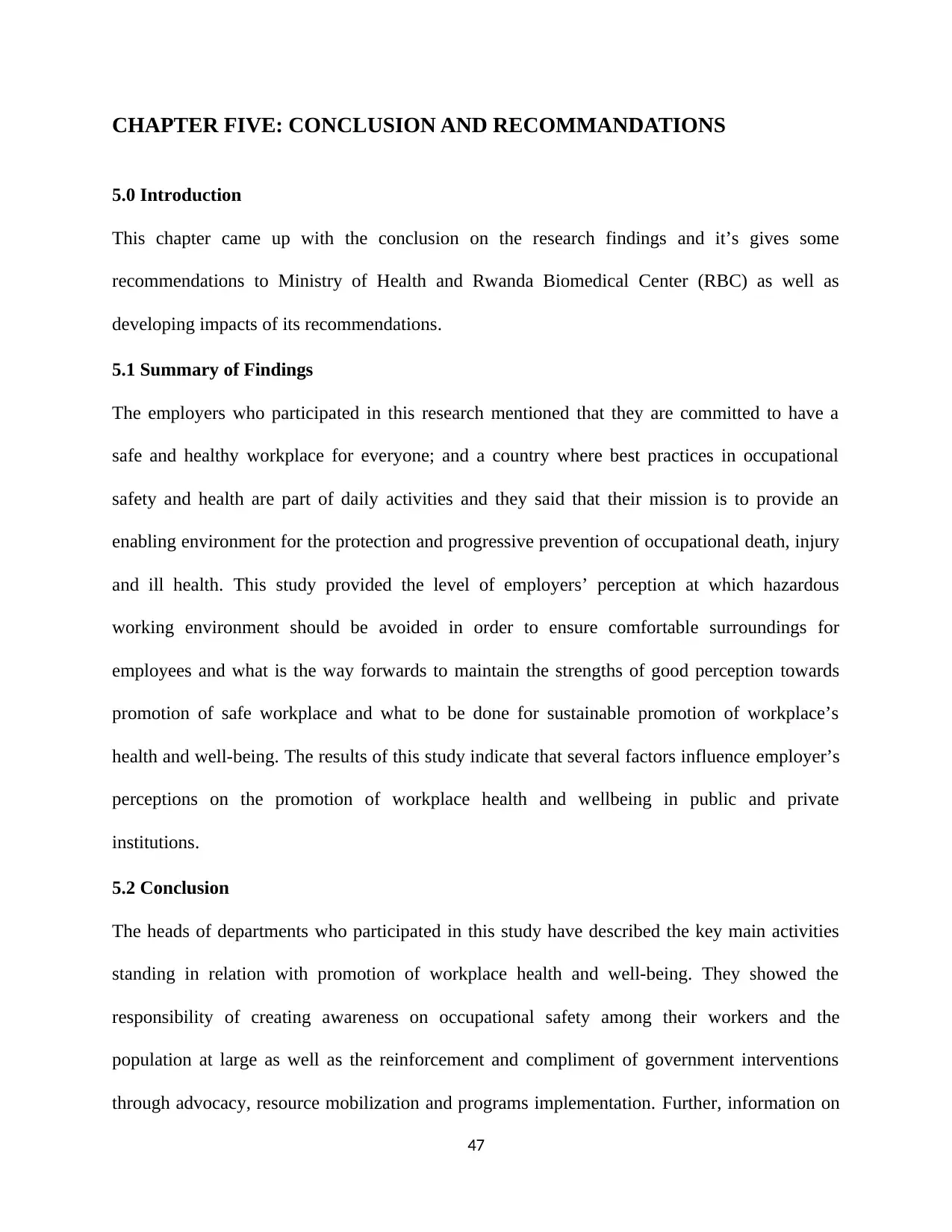
CHAPTER FIVE: CONCLUSION AND RECOMMANDATIONS
5.0 Introduction
This chapter came up with the conclusion on the research findings and it’s gives some
recommendations to Ministry of Health and Rwanda Biomedical Center (RBC) as well as
developing impacts of its recommendations.
5.1 Summary of Findings
The employers who participated in this research mentioned that they are committed to have a
safe and healthy workplace for everyone; and a country where best practices in occupational
safety and health are part of daily activities and they said that their mission is to provide an
enabling environment for the protection and progressive prevention of occupational death, injury
and ill health. This study provided the level of employers’ perception at which hazardous
working environment should be avoided in order to ensure comfortable surroundings for
employees and what is the way forwards to maintain the strengths of good perception towards
promotion of safe workplace and what to be done for sustainable promotion of workplace’s
health and well-being. The results of this study indicate that several factors influence employer’s
perceptions on the promotion of workplace health and wellbeing in public and private
institutions.
5.2 Conclusion
The heads of departments who participated in this study have described the key main activities
standing in relation with promotion of workplace health and well-being. They showed the
responsibility of creating awareness on occupational safety among their workers and the
population at large as well as the reinforcement and compliment of government interventions
through advocacy, resource mobilization and programs implementation. Further, information on
47
5.0 Introduction
This chapter came up with the conclusion on the research findings and it’s gives some
recommendations to Ministry of Health and Rwanda Biomedical Center (RBC) as well as
developing impacts of its recommendations.
5.1 Summary of Findings
The employers who participated in this research mentioned that they are committed to have a
safe and healthy workplace for everyone; and a country where best practices in occupational
safety and health are part of daily activities and they said that their mission is to provide an
enabling environment for the protection and progressive prevention of occupational death, injury
and ill health. This study provided the level of employers’ perception at which hazardous
working environment should be avoided in order to ensure comfortable surroundings for
employees and what is the way forwards to maintain the strengths of good perception towards
promotion of safe workplace and what to be done for sustainable promotion of workplace’s
health and well-being. The results of this study indicate that several factors influence employer’s
perceptions on the promotion of workplace health and wellbeing in public and private
institutions.
5.2 Conclusion
The heads of departments who participated in this study have described the key main activities
standing in relation with promotion of workplace health and well-being. They showed the
responsibility of creating awareness on occupational safety among their workers and the
population at large as well as the reinforcement and compliment of government interventions
through advocacy, resource mobilization and programs implementation. Further, information on
47

the potential benefits of the promotion of workplace health and wellbeing aligned with
perceptions relating to healthy and unhealthy workers may be necessary to contextualize
information provided. The results of this study indicate that several factors influence employer’s
perceptions on the promotion of workplace health and wellbeing in public and private
institutions. When it comes to influencing employees’ health and wellbeing beyond the scope of
occupational health and safety, a multifaceted approach involving education about what
workplace health and wellbeing encapsulates is warranted. Finally, different workplace
circumstances must be given consideration when designing initiatives and interventions.
5.3 Recommendations
To include an education campaign providing information about what constitutes health and
wellbeing beyond the scope of occupational health and safety paradigms along with information
on the benefits of workplace health and wellbeing aligned with perceptions relating to healthy
and unhealthy workers.
To consider different workplace circumstances when designing initiatives and interventions
related to occupational health and safety.
To implement a health and safety management within the institution and this should include an
overall policy setting out the commitment, responsibilities allocated to individuals and the
arrangements detailing how the risks will actually be controlled.
To identify and list specific hazards depending on the types of activities done within a given
institution and this will enable workers to know what kind of hazards that they may meet
throughout service delivery.
Managers should educate staff on first-aid procedures and indicate the location of first-aid
equipment. Human resources managers may also conduct emergency evacuation drills in which
48
perceptions relating to healthy and unhealthy workers may be necessary to contextualize
information provided. The results of this study indicate that several factors influence employer’s
perceptions on the promotion of workplace health and wellbeing in public and private
institutions. When it comes to influencing employees’ health and wellbeing beyond the scope of
occupational health and safety, a multifaceted approach involving education about what
workplace health and wellbeing encapsulates is warranted. Finally, different workplace
circumstances must be given consideration when designing initiatives and interventions.
5.3 Recommendations
To include an education campaign providing information about what constitutes health and
wellbeing beyond the scope of occupational health and safety paradigms along with information
on the benefits of workplace health and wellbeing aligned with perceptions relating to healthy
and unhealthy workers.
To consider different workplace circumstances when designing initiatives and interventions
related to occupational health and safety.
To implement a health and safety management within the institution and this should include an
overall policy setting out the commitment, responsibilities allocated to individuals and the
arrangements detailing how the risks will actually be controlled.
To identify and list specific hazards depending on the types of activities done within a given
institution and this will enable workers to know what kind of hazards that they may meet
throughout service delivery.
Managers should educate staff on first-aid procedures and indicate the location of first-aid
equipment. Human resources managers may also conduct emergency evacuation drills in which
48
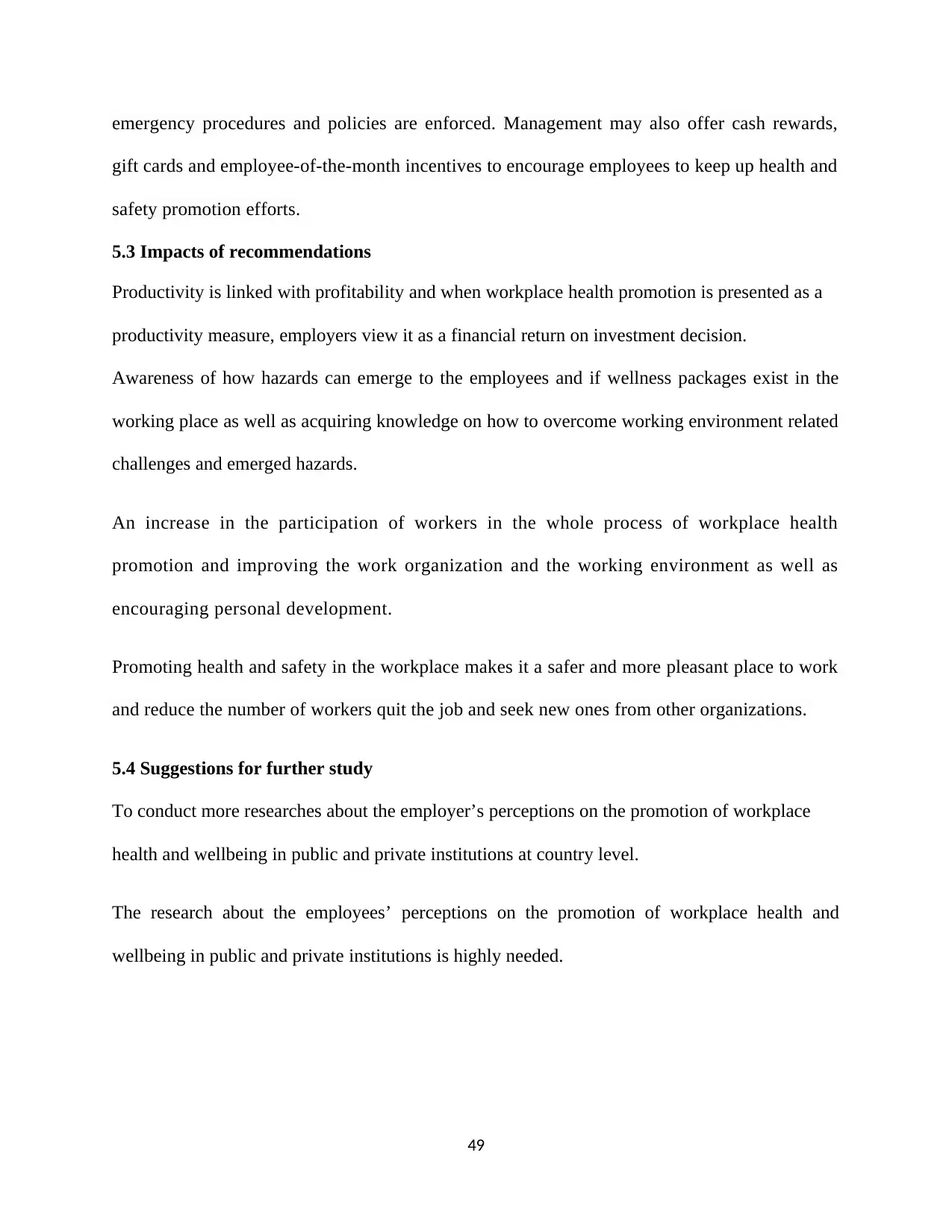
emergency procedures and policies are enforced. Management may also offer cash rewards,
gift cards and employee-of-the-month incentives to encourage employees to keep up health and
safety promotion efforts.
5.3 Impacts of recommendations
Productivity is linked with profitability and when workplace health promotion is presented as a
productivity measure, employers view it as a financial return on investment decision.
Awareness of how hazards can emerge to the employees and if wellness packages exist in the
working place as well as acquiring knowledge on how to overcome working environment related
challenges and emerged hazards.
An increase in the participation of workers in the whole process of workplace health
promotion and improving the work organization and the working environment as well as
encouraging personal development.
Promoting health and safety in the workplace makes it a safer and more pleasant place to work
and reduce the number of workers quit the job and seek new ones from other organizations.
5.4 Suggestions for further study
To conduct more researches about the employer’s perceptions on the promotion of workplace
health and wellbeing in public and private institutions at country level.
The research about the employees’ perceptions on the promotion of workplace health and
wellbeing in public and private institutions is highly needed.
49
gift cards and employee-of-the-month incentives to encourage employees to keep up health and
safety promotion efforts.
5.3 Impacts of recommendations
Productivity is linked with profitability and when workplace health promotion is presented as a
productivity measure, employers view it as a financial return on investment decision.
Awareness of how hazards can emerge to the employees and if wellness packages exist in the
working place as well as acquiring knowledge on how to overcome working environment related
challenges and emerged hazards.
An increase in the participation of workers in the whole process of workplace health
promotion and improving the work organization and the working environment as well as
encouraging personal development.
Promoting health and safety in the workplace makes it a safer and more pleasant place to work
and reduce the number of workers quit the job and seek new ones from other organizations.
5.4 Suggestions for further study
To conduct more researches about the employer’s perceptions on the promotion of workplace
health and wellbeing in public and private institutions at country level.
The research about the employees’ perceptions on the promotion of workplace health and
wellbeing in public and private institutions is highly needed.
49
Paraphrase This Document
Need a fresh take? Get an instant paraphrase of this document with our AI Paraphraser

REFERENCES
Ahmed, M., & Al-surimi, K. (2021). Promoting the role of patients in improving hand hygiene
compliance amongst health care workers. (Cdc), 10–13.
https://doi.org/10.1136/bmjquality.u210787.w4336
Andersen, L. L., Proper, K. I., Punnett, L., Wynne, R., Persson, R., & Wiezer, N. (2018).
Workplace Health Promotion and Wellbeing. Scientific World Journal, 2015(1), 5–6.
https://doi.org/10.1155/2015/606875
Bickford, M. (2018). Stress in the Workplace: A General Overview of the Causes, the Effects,
and the Solutions. Canadian Mental Health Association Newfoundland and Labrador
Division, (August), 1–44.
Centers, T., Control, D., Workplace, C. D. C., Model, H., Health, W., & Model, W. H. (2020).
The CDC Workplace Health Resource Center : An Overview What is the CDC Workplace
Health Resource Center ? (CDC).
Daniel, Beers, H., & Greaves. (2021). Employers’ perceptions of the health and safety of young
workers. Retrieved from www.nationalarchives.gov.uk/doc/open-government-licence/,
Engdaw, G. T., Gebrehiwot, M., & Andualem, Z. (2019). Hand hygiene compliance and
associated factors among health care providers in Central Gondar zone public primary
hospitals , Northwest Ethiopia. 1–7.
Fehér, J., & Reich, M. (2020). Perceived impacts of company workplace health promotion on
employment relationship. Journal of Eastern European and Central Asian Research, 7(3),
238–254. https://doi.org/10.15549/jeecar.v7i3.357
Glorian, Barbeau, E., Stoddard, A. M., Hunt, M. K., Kaphingst, K., & Wallace, L. (2022).
Promoting behavior change among working-class, multiethnic workers: Results of the
50
Ahmed, M., & Al-surimi, K. (2021). Promoting the role of patients in improving hand hygiene
compliance amongst health care workers. (Cdc), 10–13.
https://doi.org/10.1136/bmjquality.u210787.w4336
Andersen, L. L., Proper, K. I., Punnett, L., Wynne, R., Persson, R., & Wiezer, N. (2018).
Workplace Health Promotion and Wellbeing. Scientific World Journal, 2015(1), 5–6.
https://doi.org/10.1155/2015/606875
Bickford, M. (2018). Stress in the Workplace: A General Overview of the Causes, the Effects,
and the Solutions. Canadian Mental Health Association Newfoundland and Labrador
Division, (August), 1–44.
Centers, T., Control, D., Workplace, C. D. C., Model, H., Health, W., & Model, W. H. (2020).
The CDC Workplace Health Resource Center : An Overview What is the CDC Workplace
Health Resource Center ? (CDC).
Daniel, Beers, H., & Greaves. (2021). Employers’ perceptions of the health and safety of young
workers. Retrieved from www.nationalarchives.gov.uk/doc/open-government-licence/,
Engdaw, G. T., Gebrehiwot, M., & Andualem, Z. (2019). Hand hygiene compliance and
associated factors among health care providers in Central Gondar zone public primary
hospitals , Northwest Ethiopia. 1–7.
Fehér, J., & Reich, M. (2020). Perceived impacts of company workplace health promotion on
employment relationship. Journal of Eastern European and Central Asian Research, 7(3),
238–254. https://doi.org/10.15549/jeecar.v7i3.357
Glorian, Barbeau, E., Stoddard, A. M., Hunt, M. K., Kaphingst, K., & Wallace, L. (2022).
Promoting behavior change among working-class, multiethnic workers: Results of the
50

healthy directions - Small business study. American Journal of Public Health, 95(8), 1389–
1395. https://doi.org/10.21/AJPH.2004.038745
Hameed, N. U. F., Oakley, C. T., Bravo, C., Angiolillo, D. J., & Gaudino, M. (2021). Hand
Hygiene Compliance Rate During the COVID-19 Pandemic. 181(7), 1006–1008.
https://doi.org/10.1111/codi.14548
Hazni, M., Rahim, A., Ibrahim, M. I., Noor, S. S., & Fadzil, N. M. (2021). Predictors of Self-
Reported Hand Hygiene Performance among Nurses at Tertiary Care Hospitals in East
Coast Malaysia.
Health, S. and, & Executive. (2020). Workplace health , safety and welfare. A short guide for
managers. A Short Guide for Managers, 1–8. Retrieved from
http://www.hse.gov.uk/pubns/indg244.pdf.
Jason A, C. (2021). The meaning of work. PsycCRITIQUES, 61(2).
https://doi.org/10.1037/a0040046
Joan, B. (2020). WHO Healthy Workplace Framework and Model : Background and Supporting
Literature and Practices. WHO Library Cataloguing-in-Publication Data.
Kinga, Rutkowska, Monika, H. (2022). Work life balance as a factor influencing well-being. 87–
101.
Labour, R. (2021). Tittle: Major occupational ahaealth challenge in Rwanda. American Journal
of Public Health, 88(7), 1037–1041. Https://Doi.Org, 59.
Leonard, D. (2020). Employee Perception of Workplace Health Promotion and its Effects on
Stress-Related Absenteeism in the Workplace Masters of Arts in Human Resource
Management National College of Ireland Submitted to the National College of Ireland ,
August 2016. (August).
51
1395. https://doi.org/10.21/AJPH.2004.038745
Hameed, N. U. F., Oakley, C. T., Bravo, C., Angiolillo, D. J., & Gaudino, M. (2021). Hand
Hygiene Compliance Rate During the COVID-19 Pandemic. 181(7), 1006–1008.
https://doi.org/10.1111/codi.14548
Hazni, M., Rahim, A., Ibrahim, M. I., Noor, S. S., & Fadzil, N. M. (2021). Predictors of Self-
Reported Hand Hygiene Performance among Nurses at Tertiary Care Hospitals in East
Coast Malaysia.
Health, S. and, & Executive. (2020). Workplace health , safety and welfare. A short guide for
managers. A Short Guide for Managers, 1–8. Retrieved from
http://www.hse.gov.uk/pubns/indg244.pdf.
Jason A, C. (2021). The meaning of work. PsycCRITIQUES, 61(2).
https://doi.org/10.1037/a0040046
Joan, B. (2020). WHO Healthy Workplace Framework and Model : Background and Supporting
Literature and Practices. WHO Library Cataloguing-in-Publication Data.
Kinga, Rutkowska, Monika, H. (2022). Work life balance as a factor influencing well-being. 87–
101.
Labour, R. (2021). Tittle: Major occupational ahaealth challenge in Rwanda. American Journal
of Public Health, 88(7), 1037–1041. Https://Doi.Org, 59.
Leonard, D. (2020). Employee Perception of Workplace Health Promotion and its Effects on
Stress-Related Absenteeism in the Workplace Masters of Arts in Human Resource
Management National College of Ireland Submitted to the National College of Ireland ,
August 2016. (August).
51
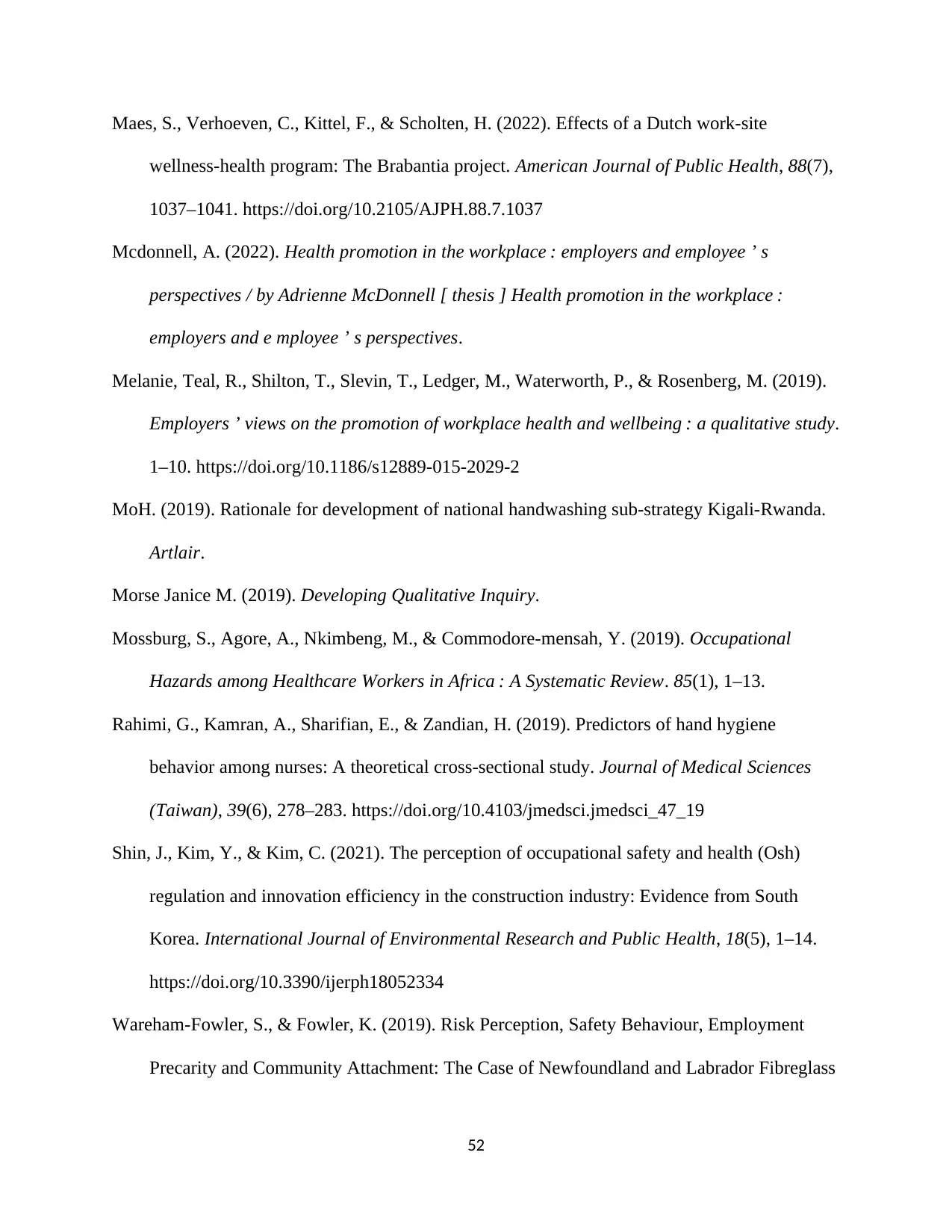
Maes, S., Verhoeven, C., Kittel, F., & Scholten, H. (2022). Effects of a Dutch work-site
wellness-health program: The Brabantia project. American Journal of Public Health, 88(7),
1037–1041. https://doi.org/10.2105/AJPH.88.7.1037
Mcdonnell, A. (2022). Health promotion in the workplace : employers and employee ’ s
perspectives / by Adrienne McDonnell [ thesis ] Health promotion in the workplace :
employers and e mployee ’ s perspectives.
Melanie, Teal, R., Shilton, T., Slevin, T., Ledger, M., Waterworth, P., & Rosenberg, M. (2019).
Employers ’ views on the promotion of workplace health and wellbeing : a qualitative study.
1–10. https://doi.org/10.1186/s12889-015-2029-2
MoH. (2019). Rationale for development of national handwashing sub-strategy Kigali-Rwanda.
Artlair.
Morse Janice M. (2019). Developing Qualitative Inquiry.
Mossburg, S., Agore, A., Nkimbeng, M., & Commodore-mensah, Y. (2019). Occupational
Hazards among Healthcare Workers in Africa : A Systematic Review. 85(1), 1–13.
Rahimi, G., Kamran, A., Sharifian, E., & Zandian, H. (2019). Predictors of hand hygiene
behavior among nurses: A theoretical cross-sectional study. Journal of Medical Sciences
(Taiwan), 39(6), 278–283. https://doi.org/10.4103/jmedsci.jmedsci_47_19
Shin, J., Kim, Y., & Kim, C. (2021). The perception of occupational safety and health (Osh)
regulation and innovation efficiency in the construction industry: Evidence from South
Korea. International Journal of Environmental Research and Public Health, 18(5), 1–14.
https://doi.org/10.3390/ijerph18052334
Wareham-Fowler, S., & Fowler, K. (2019). Risk Perception, Safety Behaviour, Employment
Precarity and Community Attachment: The Case of Newfoundland and Labrador Fibreglass
52
wellness-health program: The Brabantia project. American Journal of Public Health, 88(7),
1037–1041. https://doi.org/10.2105/AJPH.88.7.1037
Mcdonnell, A. (2022). Health promotion in the workplace : employers and employee ’ s
perspectives / by Adrienne McDonnell [ thesis ] Health promotion in the workplace :
employers and e mployee ’ s perspectives.
Melanie, Teal, R., Shilton, T., Slevin, T., Ledger, M., Waterworth, P., & Rosenberg, M. (2019).
Employers ’ views on the promotion of workplace health and wellbeing : a qualitative study.
1–10. https://doi.org/10.1186/s12889-015-2029-2
MoH. (2019). Rationale for development of national handwashing sub-strategy Kigali-Rwanda.
Artlair.
Morse Janice M. (2019). Developing Qualitative Inquiry.
Mossburg, S., Agore, A., Nkimbeng, M., & Commodore-mensah, Y. (2019). Occupational
Hazards among Healthcare Workers in Africa : A Systematic Review. 85(1), 1–13.
Rahimi, G., Kamran, A., Sharifian, E., & Zandian, H. (2019). Predictors of hand hygiene
behavior among nurses: A theoretical cross-sectional study. Journal of Medical Sciences
(Taiwan), 39(6), 278–283. https://doi.org/10.4103/jmedsci.jmedsci_47_19
Shin, J., Kim, Y., & Kim, C. (2021). The perception of occupational safety and health (Osh)
regulation and innovation efficiency in the construction industry: Evidence from South
Korea. International Journal of Environmental Research and Public Health, 18(5), 1–14.
https://doi.org/10.3390/ijerph18052334
Wareham-Fowler, S., & Fowler, K. (2019). Risk Perception, Safety Behaviour, Employment
Precarity and Community Attachment: The Case of Newfoundland and Labrador Fibreglass
52
Secure Best Marks with AI Grader
Need help grading? Try our AI Grader for instant feedback on your assignments.
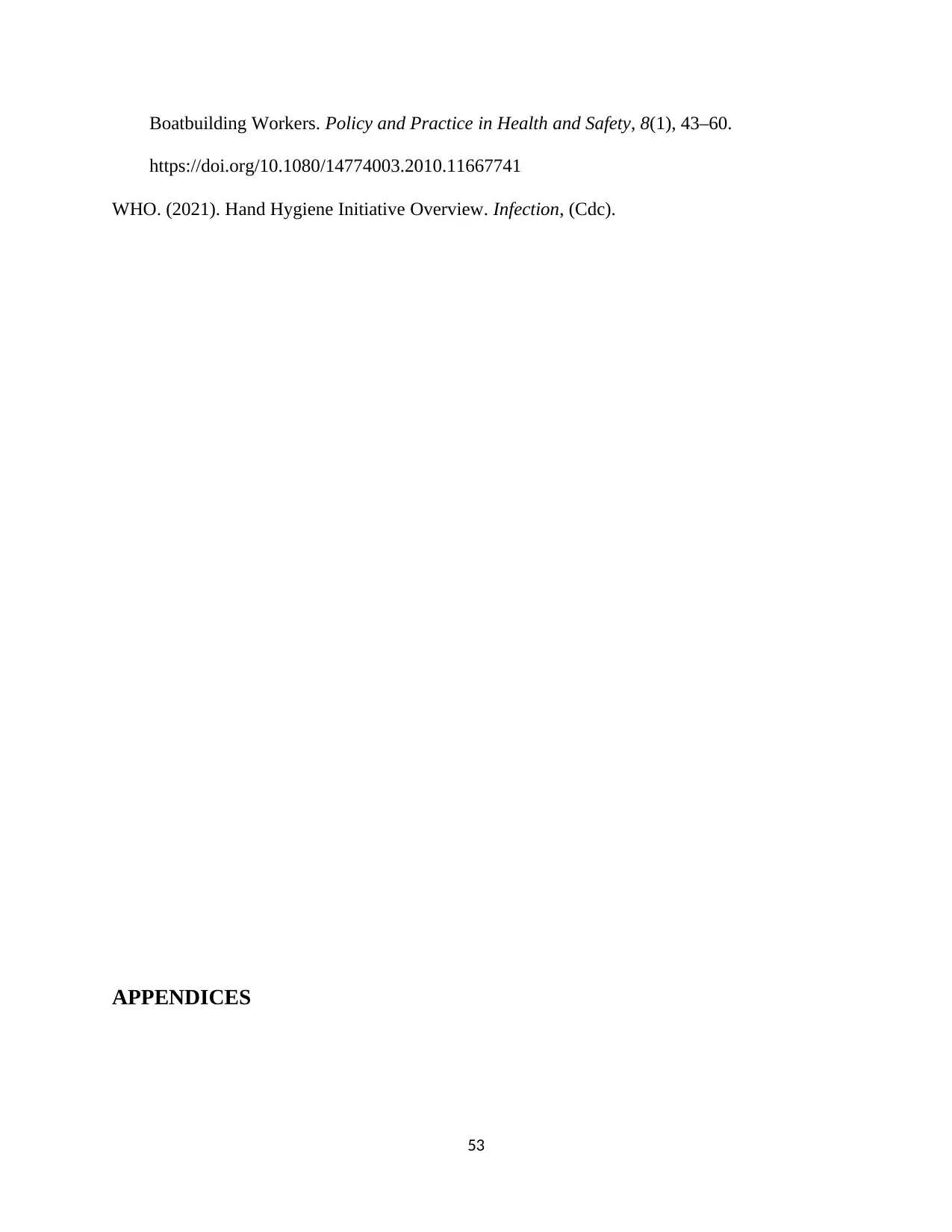
Boatbuilding Workers. Policy and Practice in Health and Safety, 8(1), 43–60.
https://doi.org/10.1080/14774003.2010.11667741
WHO. (2021). Hand Hygiene Initiative Overview. Infection, (Cdc).
APPENDICES
53
https://doi.org/10.1080/14774003.2010.11667741
WHO. (2021). Hand Hygiene Initiative Overview. Infection, (Cdc).
APPENDICES
53
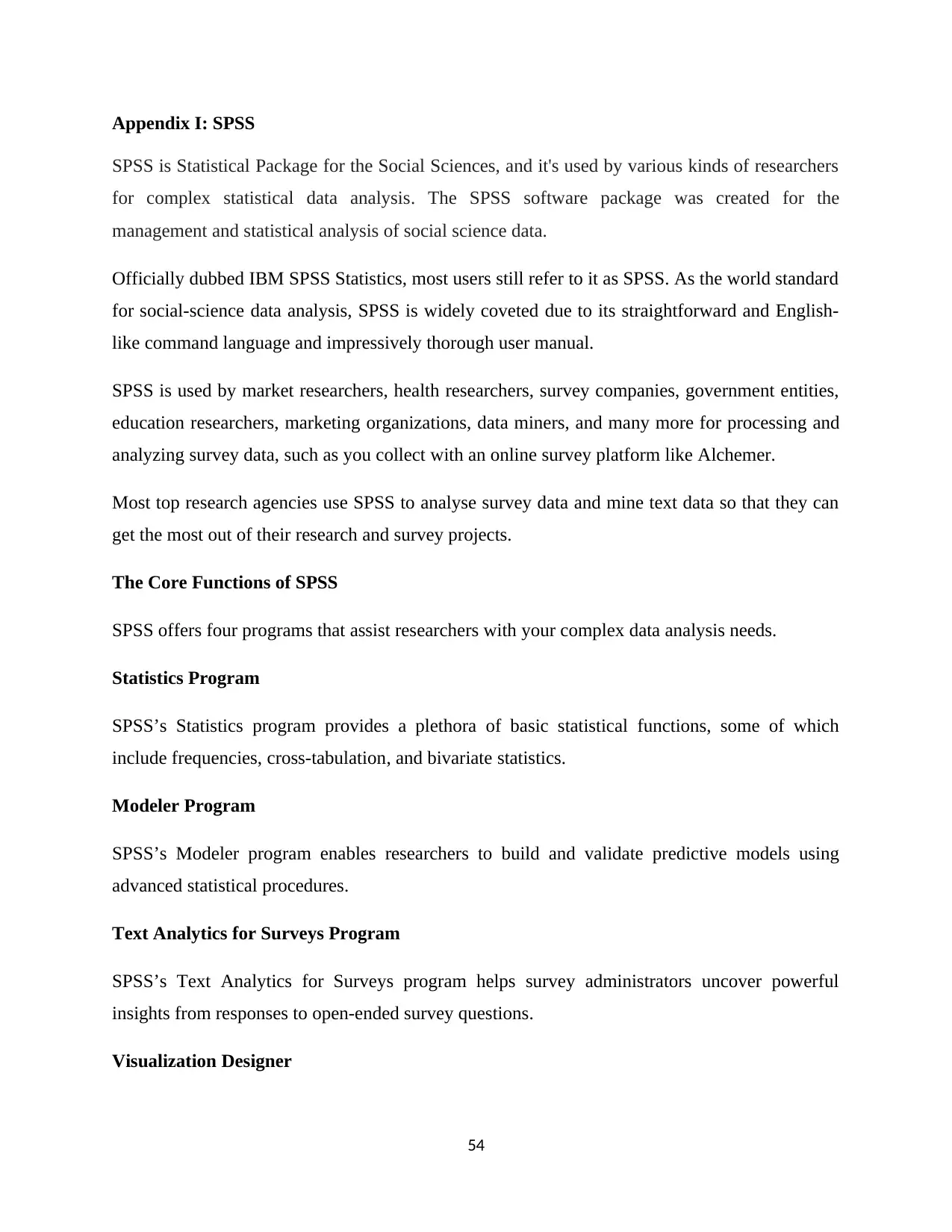
Appendix I: SPSS
SPSS is Statistical Package for the Social Sciences, and it's used by various kinds of researchers
for complex statistical data analysis. The SPSS software package was created for the
management and statistical analysis of social science data.
Officially dubbed IBM SPSS Statistics, most users still refer to it as SPSS. As the world standard
for social-science data analysis, SPSS is widely coveted due to its straightforward and English-
like command language and impressively thorough user manual.
SPSS is used by market researchers, health researchers, survey companies, government entities,
education researchers, marketing organizations, data miners, and many more for processing and
analyzing survey data, such as you collect with an online survey platform like Alchemer.
Most top research agencies use SPSS to analyse survey data and mine text data so that they can
get the most out of their research and survey projects.
The Core Functions of SPSS
SPSS offers four programs that assist researchers with your complex data analysis needs.
Statistics Program
SPSS’s Statistics program provides a plethora of basic statistical functions, some of which
include frequencies, cross-tabulation, and bivariate statistics.
Modeler Program
SPSS’s Modeler program enables researchers to build and validate predictive models using
advanced statistical procedures.
Text Analytics for Surveys Program
SPSS’s Text Analytics for Surveys program helps survey administrators uncover powerful
insights from responses to open-ended survey questions.
Visualization Designer
54
SPSS is Statistical Package for the Social Sciences, and it's used by various kinds of researchers
for complex statistical data analysis. The SPSS software package was created for the
management and statistical analysis of social science data.
Officially dubbed IBM SPSS Statistics, most users still refer to it as SPSS. As the world standard
for social-science data analysis, SPSS is widely coveted due to its straightforward and English-
like command language and impressively thorough user manual.
SPSS is used by market researchers, health researchers, survey companies, government entities,
education researchers, marketing organizations, data miners, and many more for processing and
analyzing survey data, such as you collect with an online survey platform like Alchemer.
Most top research agencies use SPSS to analyse survey data and mine text data so that they can
get the most out of their research and survey projects.
The Core Functions of SPSS
SPSS offers four programs that assist researchers with your complex data analysis needs.
Statistics Program
SPSS’s Statistics program provides a plethora of basic statistical functions, some of which
include frequencies, cross-tabulation, and bivariate statistics.
Modeler Program
SPSS’s Modeler program enables researchers to build and validate predictive models using
advanced statistical procedures.
Text Analytics for Surveys Program
SPSS’s Text Analytics for Surveys program helps survey administrators uncover powerful
insights from responses to open-ended survey questions.
Visualization Designer
54
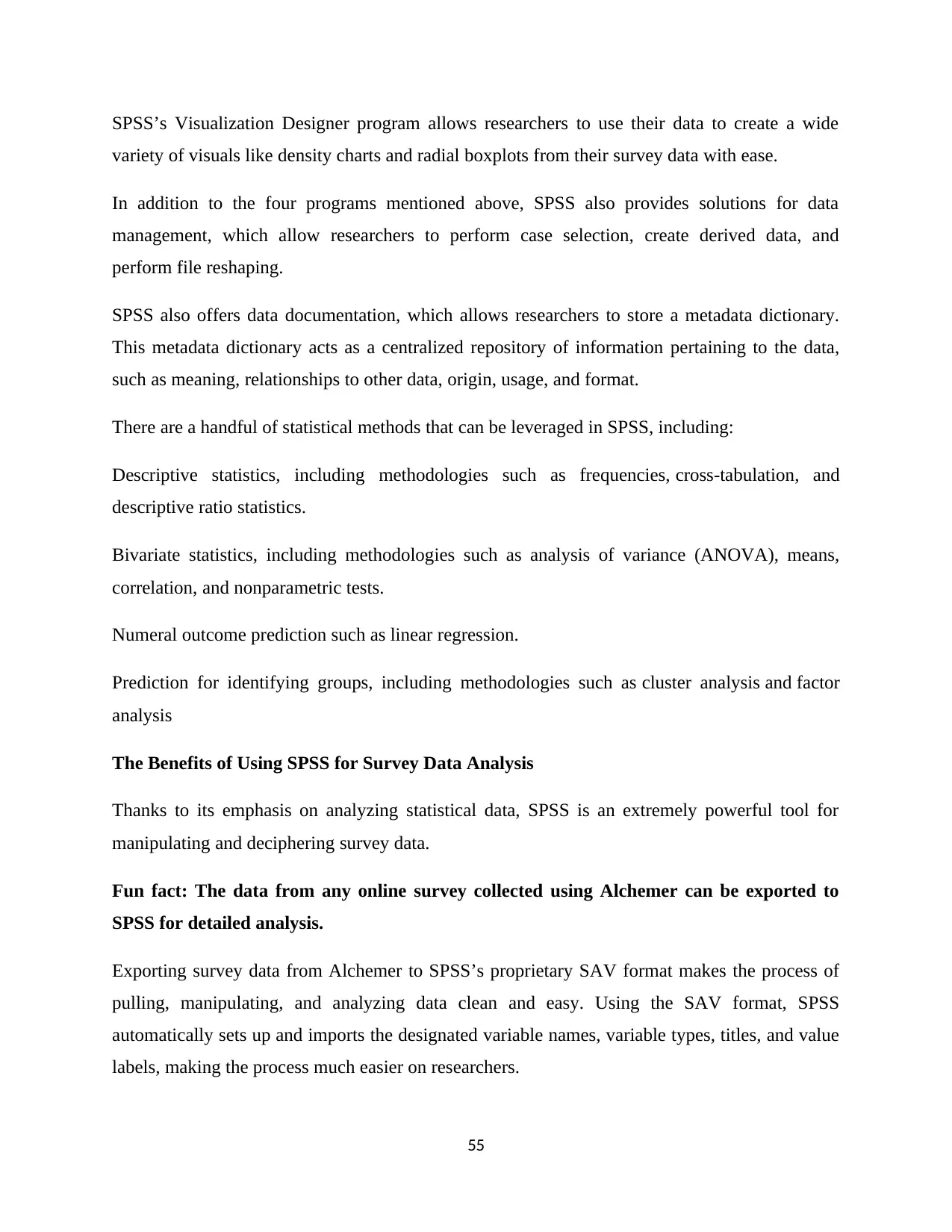
SPSS’s Visualization Designer program allows researchers to use their data to create a wide
variety of visuals like density charts and radial boxplots from their survey data with ease.
In addition to the four programs mentioned above, SPSS also provides solutions for data
management, which allow researchers to perform case selection, create derived data, and
perform file reshaping.
SPSS also offers data documentation, which allows researchers to store a metadata dictionary.
This metadata dictionary acts as a centralized repository of information pertaining to the data,
such as meaning, relationships to other data, origin, usage, and format.
There are a handful of statistical methods that can be leveraged in SPSS, including:
Descriptive statistics, including methodologies such as frequencies, cross-tabulation, and
descriptive ratio statistics.
Bivariate statistics, including methodologies such as analysis of variance (ANOVA), means,
correlation, and nonparametric tests.
Numeral outcome prediction such as linear regression.
Prediction for identifying groups, including methodologies such as cluster analysis and factor
analysis
The Benefits of Using SPSS for Survey Data Analysis
Thanks to its emphasis on analyzing statistical data, SPSS is an extremely powerful tool for
manipulating and deciphering survey data.
Fun fact: The data from any online survey collected using Alchemer can be exported to
SPSS for detailed analysis.
Exporting survey data from Alchemer to SPSS’s proprietary SAV format makes the process of
pulling, manipulating, and analyzing data clean and easy. Using the SAV format, SPSS
automatically sets up and imports the designated variable names, variable types, titles, and value
labels, making the process much easier on researchers.
55
variety of visuals like density charts and radial boxplots from their survey data with ease.
In addition to the four programs mentioned above, SPSS also provides solutions for data
management, which allow researchers to perform case selection, create derived data, and
perform file reshaping.
SPSS also offers data documentation, which allows researchers to store a metadata dictionary.
This metadata dictionary acts as a centralized repository of information pertaining to the data,
such as meaning, relationships to other data, origin, usage, and format.
There are a handful of statistical methods that can be leveraged in SPSS, including:
Descriptive statistics, including methodologies such as frequencies, cross-tabulation, and
descriptive ratio statistics.
Bivariate statistics, including methodologies such as analysis of variance (ANOVA), means,
correlation, and nonparametric tests.
Numeral outcome prediction such as linear regression.
Prediction for identifying groups, including methodologies such as cluster analysis and factor
analysis
The Benefits of Using SPSS for Survey Data Analysis
Thanks to its emphasis on analyzing statistical data, SPSS is an extremely powerful tool for
manipulating and deciphering survey data.
Fun fact: The data from any online survey collected using Alchemer can be exported to
SPSS for detailed analysis.
Exporting survey data from Alchemer to SPSS’s proprietary SAV format makes the process of
pulling, manipulating, and analyzing data clean and easy. Using the SAV format, SPSS
automatically sets up and imports the designated variable names, variable types, titles, and value
labels, making the process much easier on researchers.
55
Paraphrase This Document
Need a fresh take? Get an instant paraphrase of this document with our AI Paraphraser
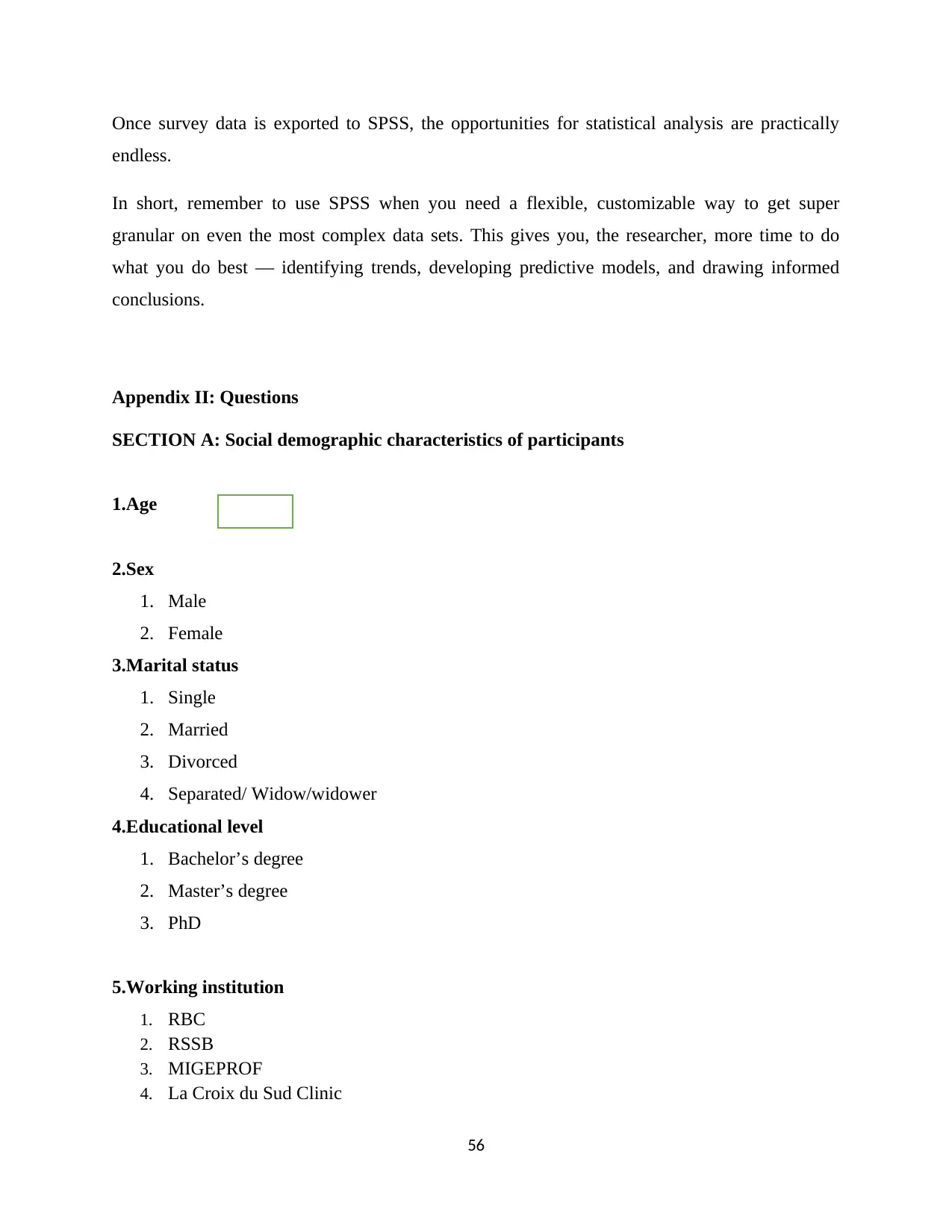
Once survey data is exported to SPSS, the opportunities for statistical analysis are practically
endless.
In short, remember to use SPSS when you need a flexible, customizable way to get super
granular on even the most complex data sets. This gives you, the researcher, more time to do
what you do best — identifying trends, developing predictive models, and drawing informed
conclusions.
Appendix II: Questions
SECTION A: Social demographic characteristics of participants
1.Age
2.Sex
1. Male
2. Female
3.Marital status
1. Single
2. Married
3. Divorced
4. Separated/ Widow/widower
4.Educational level
1. Bachelor’s degree
2. Master’s degree
3. PhD
5.Working institution
1. RBC
2. RSSB
3. MIGEPROF
4. La Croix du Sud Clinic
56
endless.
In short, remember to use SPSS when you need a flexible, customizable way to get super
granular on even the most complex data sets. This gives you, the researcher, more time to do
what you do best — identifying trends, developing predictive models, and drawing informed
conclusions.
Appendix II: Questions
SECTION A: Social demographic characteristics of participants
1.Age
2.Sex
1. Male
2. Female
3.Marital status
1. Single
2. Married
3. Divorced
4. Separated/ Widow/widower
4.Educational level
1. Bachelor’s degree
2. Master’s degree
3. PhD
5.Working institution
1. RBC
2. RSSB
3. MIGEPROF
4. La Croix du Sud Clinic
56
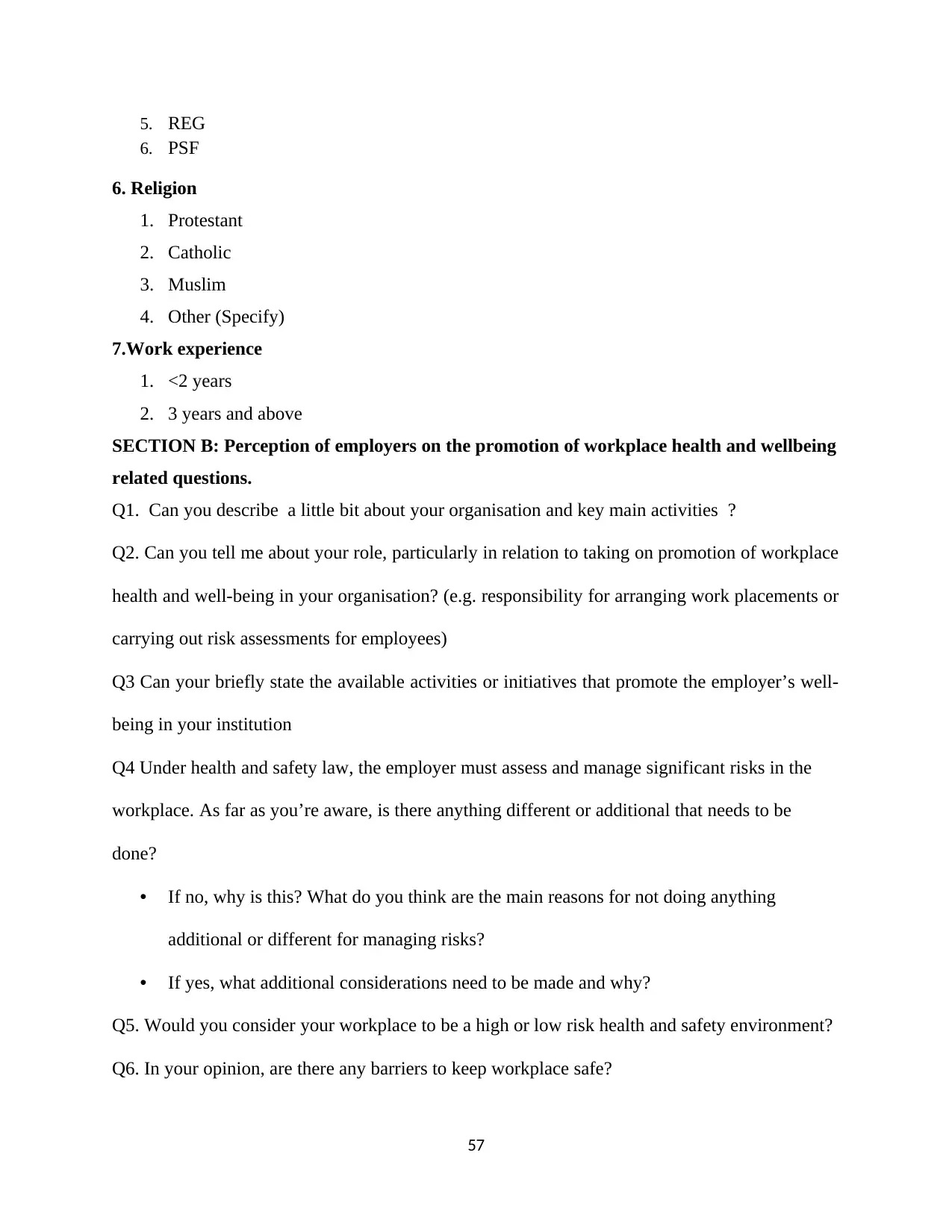
5. REG
6. PSF
6. Religion
1. Protestant
2. Catholic
3. Muslim
4. Other (Specify)
7.Work experience
1. <2 years
2. 3 years and above
SECTION B: Perception of employers on the promotion of workplace health and wellbeing
related questions.
Q1. Can you describe a little bit about your organisation and key main activities ?
Q2. Can you tell me about your role, particularly in relation to taking on promotion of workplace
health and well-being in your organisation? (e.g. responsibility for arranging work placements or
carrying out risk assessments for employees)
Q3 Can your briefly state the available activities or initiatives that promote the employer’s well-
being in your institution
Q4 Under health and safety law, the employer must assess and manage significant risks in the
workplace. As far as you’re aware, is there anything different or additional that needs to be
done?
• If no, why is this? What do you think are the main reasons for not doing anything
additional or different for managing risks?
• If yes, what additional considerations need to be made and why?
Q5. Would you consider your workplace to be a high or low risk health and safety environment?
Q6. In your opinion, are there any barriers to keep workplace safe?
57
6. PSF
6. Religion
1. Protestant
2. Catholic
3. Muslim
4. Other (Specify)
7.Work experience
1. <2 years
2. 3 years and above
SECTION B: Perception of employers on the promotion of workplace health and wellbeing
related questions.
Q1. Can you describe a little bit about your organisation and key main activities ?
Q2. Can you tell me about your role, particularly in relation to taking on promotion of workplace
health and well-being in your organisation? (e.g. responsibility for arranging work placements or
carrying out risk assessments for employees)
Q3 Can your briefly state the available activities or initiatives that promote the employer’s well-
being in your institution
Q4 Under health and safety law, the employer must assess and manage significant risks in the
workplace. As far as you’re aware, is there anything different or additional that needs to be
done?
• If no, why is this? What do you think are the main reasons for not doing anything
additional or different for managing risks?
• If yes, what additional considerations need to be made and why?
Q5. Would you consider your workplace to be a high or low risk health and safety environment?
Q6. In your opinion, are there any barriers to keep workplace safe?
57
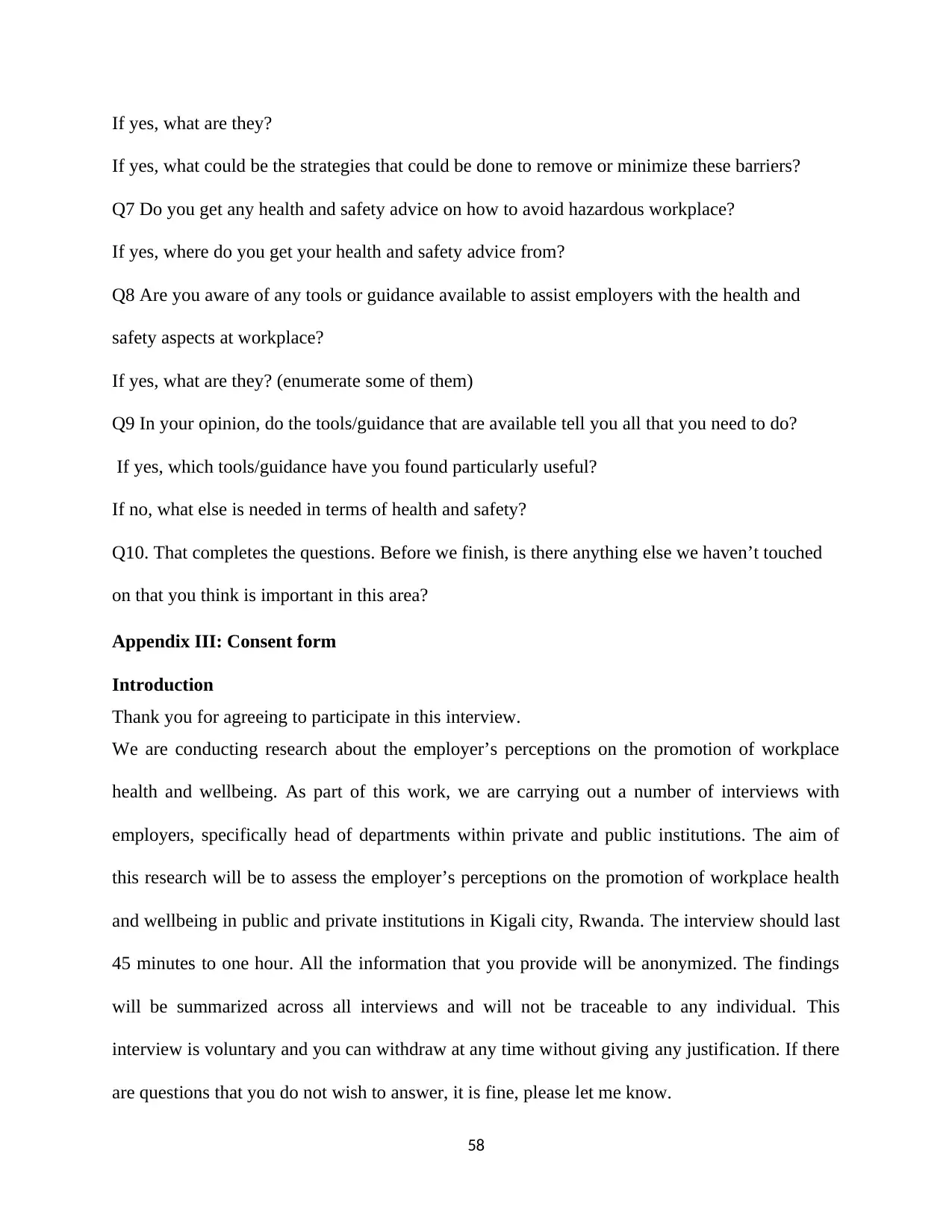
If yes, what are they?
If yes, what could be the strategies that could be done to remove or minimize these barriers?
Q7 Do you get any health and safety advice on how to avoid hazardous workplace?
If yes, where do you get your health and safety advice from?
Q8 Are you aware of any tools or guidance available to assist employers with the health and
safety aspects at workplace?
If yes, what are they? (enumerate some of them)
Q9 In your opinion, do the tools/guidance that are available tell you all that you need to do?
If yes, which tools/guidance have you found particularly useful?
If no, what else is needed in terms of health and safety?
Q10. That completes the questions. Before we finish, is there anything else we haven’t touched
on that you think is important in this area?
Appendix III: Consent form
Introduction
Thank you for agreeing to participate in this interview.
We are conducting research about the employer’s perceptions on the promotion of workplace
health and wellbeing. As part of this work, we are carrying out a number of interviews with
employers, specifically head of departments within private and public institutions. The aim of
this research will be to assess the employer’s perceptions on the promotion of workplace health
and wellbeing in public and private institutions in Kigali city, Rwanda. The interview should last
45 minutes to one hour. All the information that you provide will be anonymized. The findings
will be summarized across all interviews and will not be traceable to any individual. This
interview is voluntary and you can withdraw at any time without giving any justification. If there
are questions that you do not wish to answer, it is fine, please let me know.
58
If yes, what could be the strategies that could be done to remove or minimize these barriers?
Q7 Do you get any health and safety advice on how to avoid hazardous workplace?
If yes, where do you get your health and safety advice from?
Q8 Are you aware of any tools or guidance available to assist employers with the health and
safety aspects at workplace?
If yes, what are they? (enumerate some of them)
Q9 In your opinion, do the tools/guidance that are available tell you all that you need to do?
If yes, which tools/guidance have you found particularly useful?
If no, what else is needed in terms of health and safety?
Q10. That completes the questions. Before we finish, is there anything else we haven’t touched
on that you think is important in this area?
Appendix III: Consent form
Introduction
Thank you for agreeing to participate in this interview.
We are conducting research about the employer’s perceptions on the promotion of workplace
health and wellbeing. As part of this work, we are carrying out a number of interviews with
employers, specifically head of departments within private and public institutions. The aim of
this research will be to assess the employer’s perceptions on the promotion of workplace health
and wellbeing in public and private institutions in Kigali city, Rwanda. The interview should last
45 minutes to one hour. All the information that you provide will be anonymized. The findings
will be summarized across all interviews and will not be traceable to any individual. This
interview is voluntary and you can withdraw at any time without giving any justification. If there
are questions that you do not wish to answer, it is fine, please let me know.
58
Secure Best Marks with AI Grader
Need help grading? Try our AI Grader for instant feedback on your assignments.
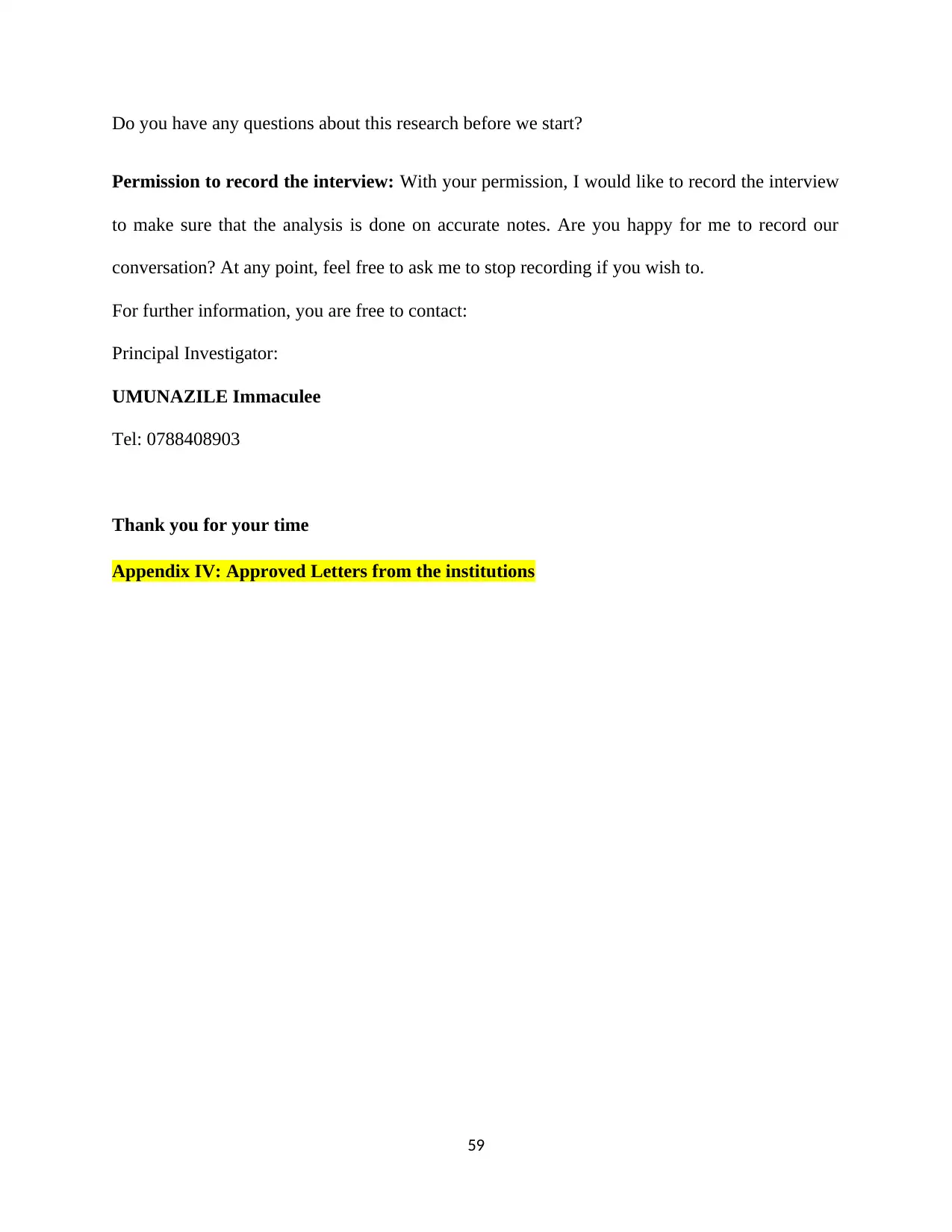
Do you have any questions about this research before we start?
Permission to record the interview: With your permission, I would like to record the interview
to make sure that the analysis is done on accurate notes. Are you happy for me to record our
conversation? At any point, feel free to ask me to stop recording if you wish to.
For further information, you are free to contact:
Principal Investigator:
UMUNAZILE Immaculee
Tel: 0788408903
Thank you for your time
Appendix IV: Approved Letters from the institutions
59
Permission to record the interview: With your permission, I would like to record the interview
to make sure that the analysis is done on accurate notes. Are you happy for me to record our
conversation? At any point, feel free to ask me to stop recording if you wish to.
For further information, you are free to contact:
Principal Investigator:
UMUNAZILE Immaculee
Tel: 0788408903
Thank you for your time
Appendix IV: Approved Letters from the institutions
59
1 out of 59
Your All-in-One AI-Powered Toolkit for Academic Success.
+13062052269
info@desklib.com
Available 24*7 on WhatsApp / Email
![[object Object]](/_next/static/media/star-bottom.7253800d.svg)
Unlock your academic potential
© 2024 | Zucol Services PVT LTD | All rights reserved.

